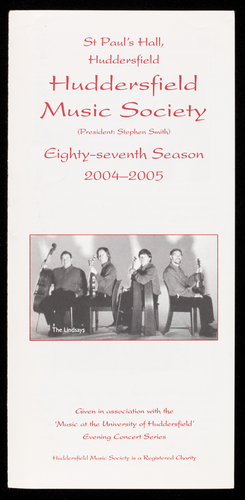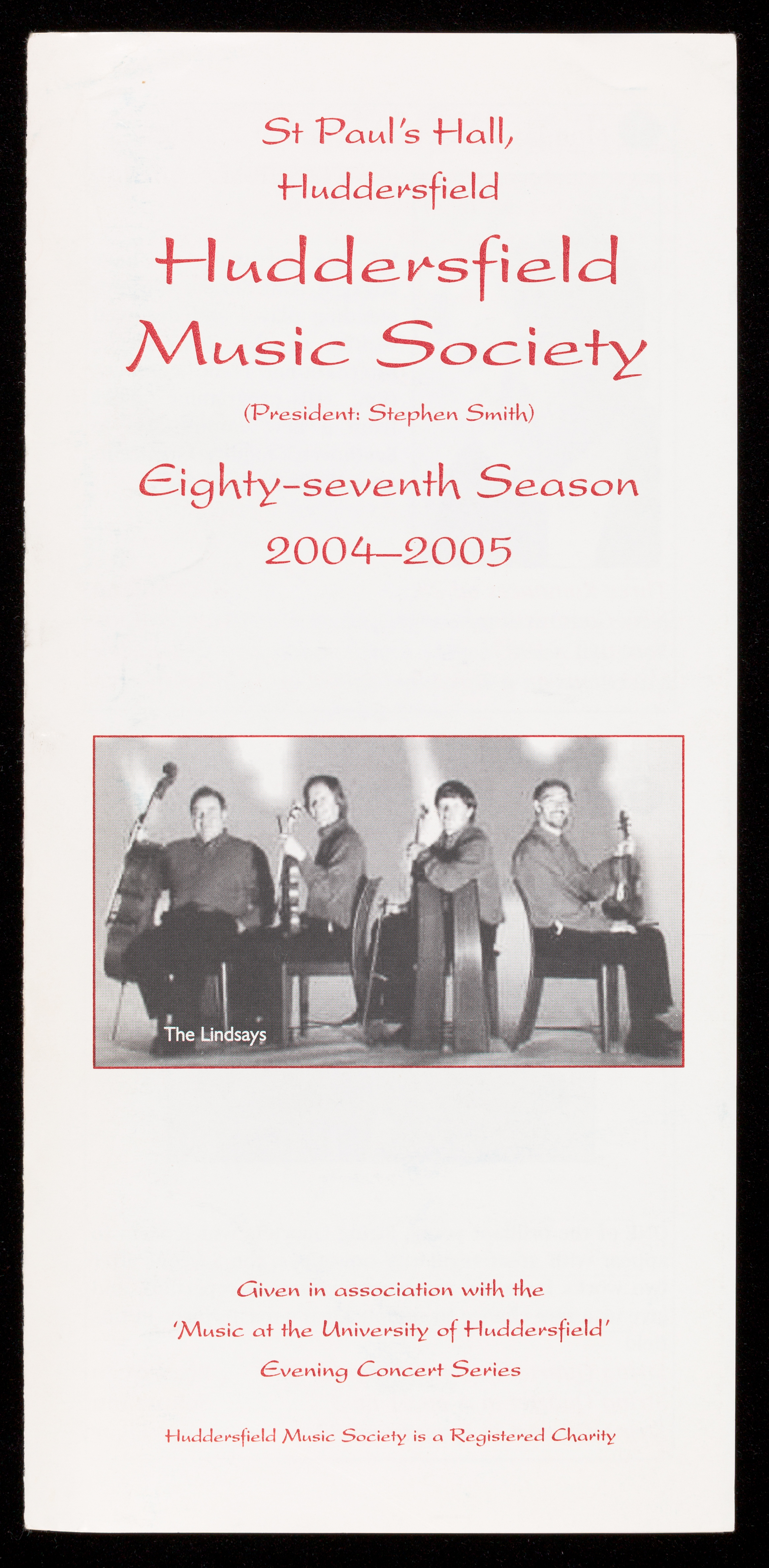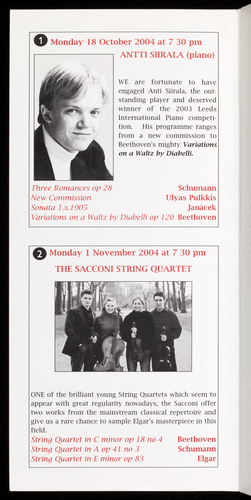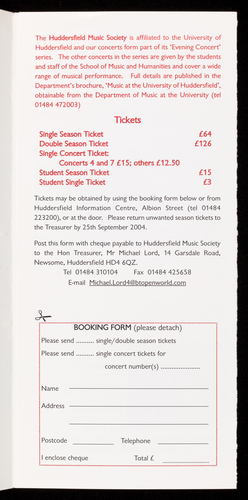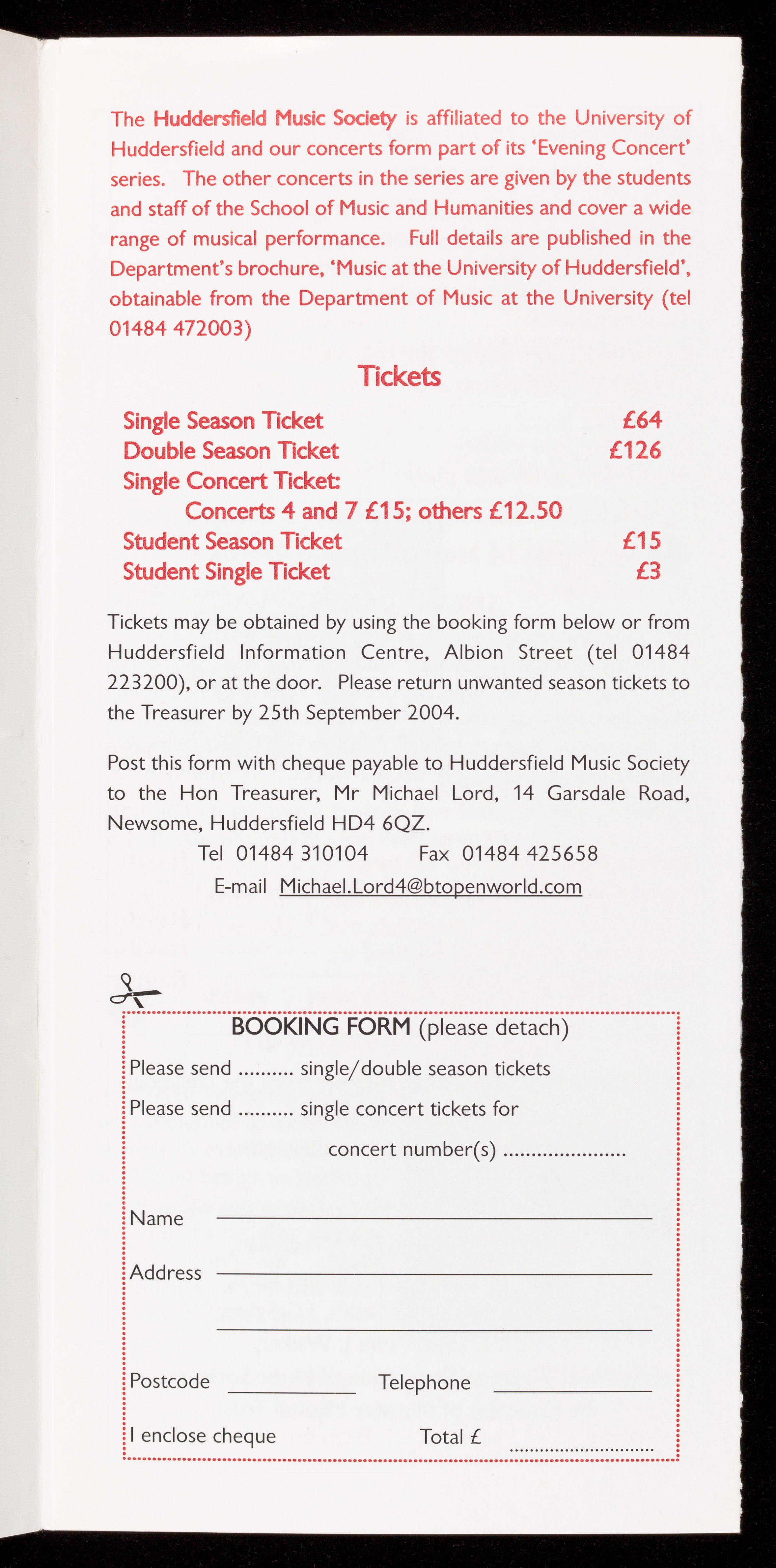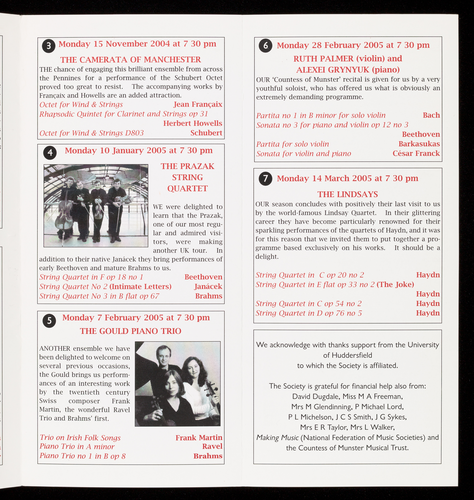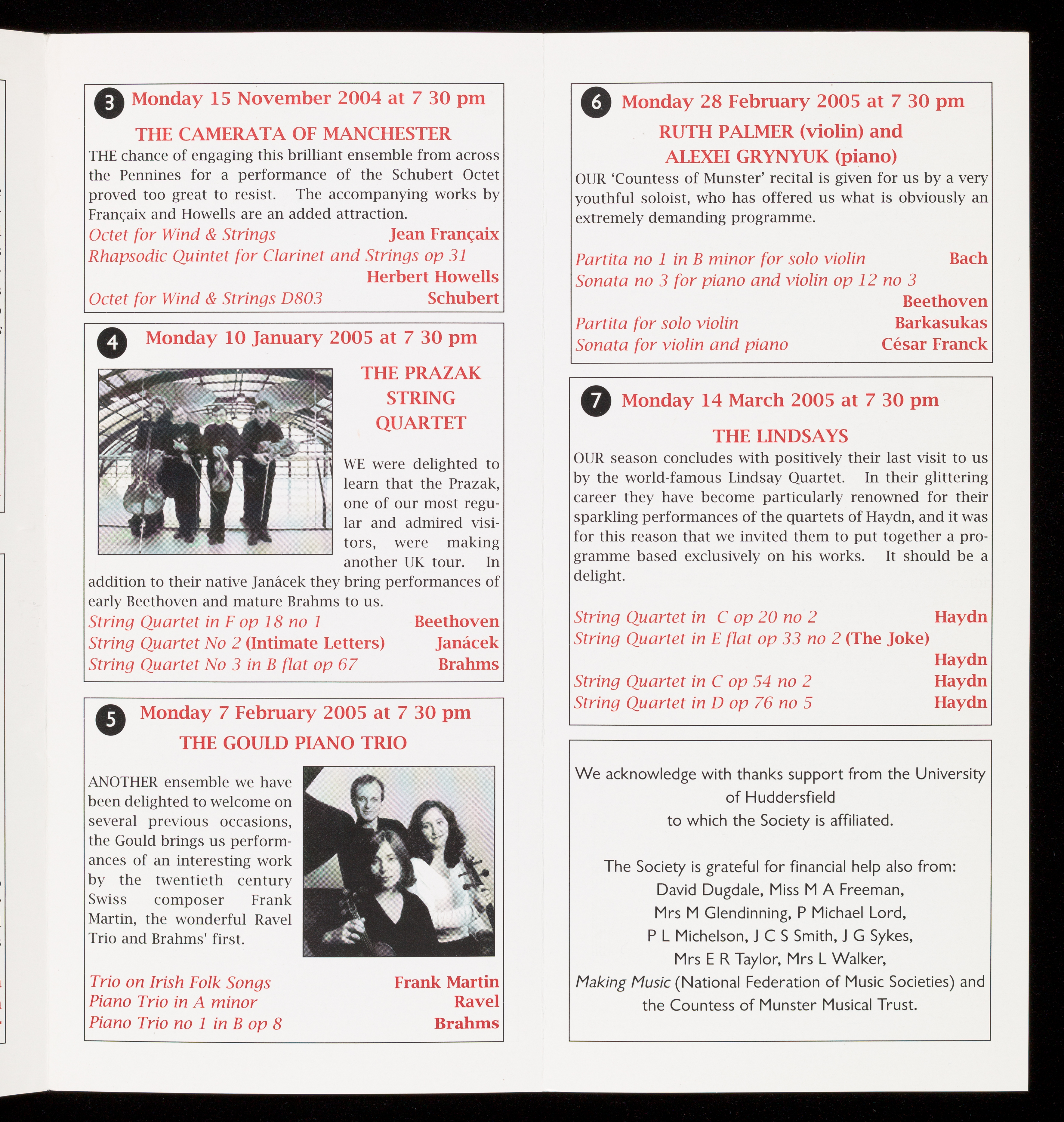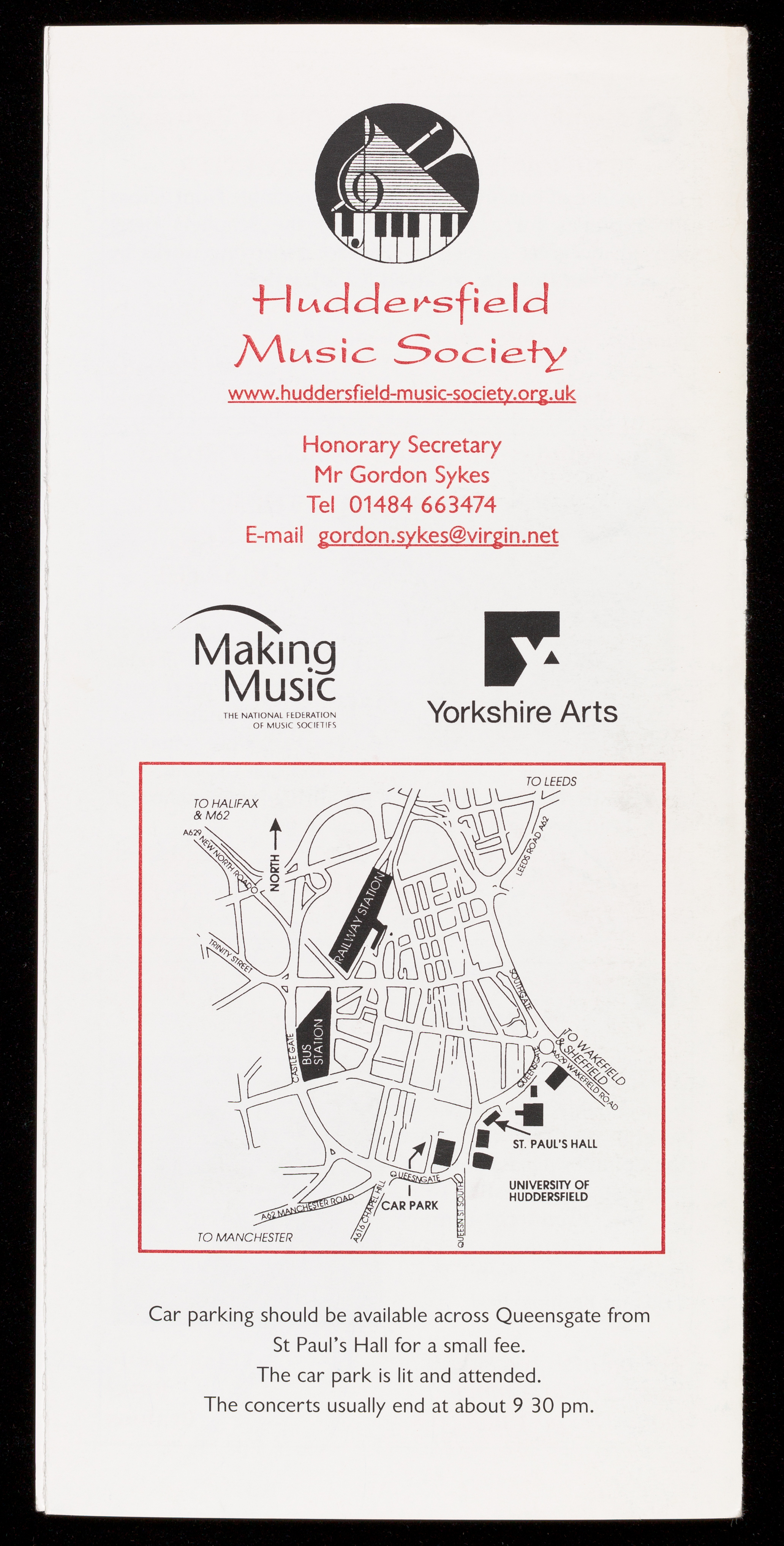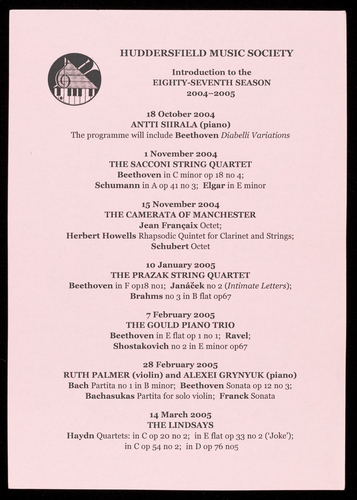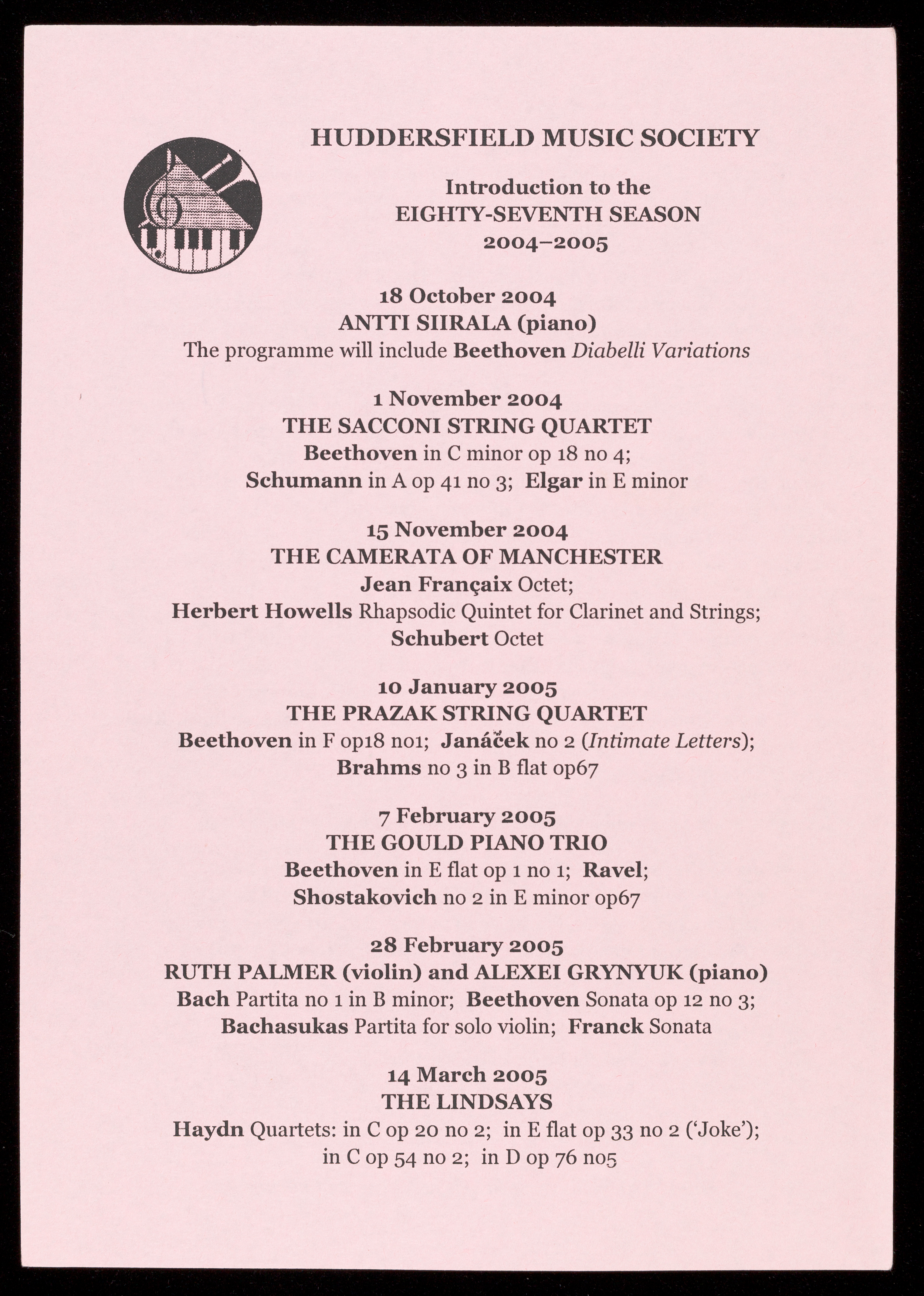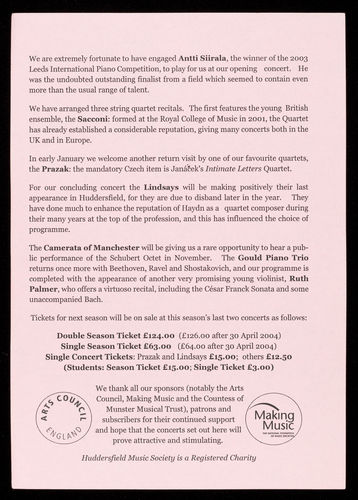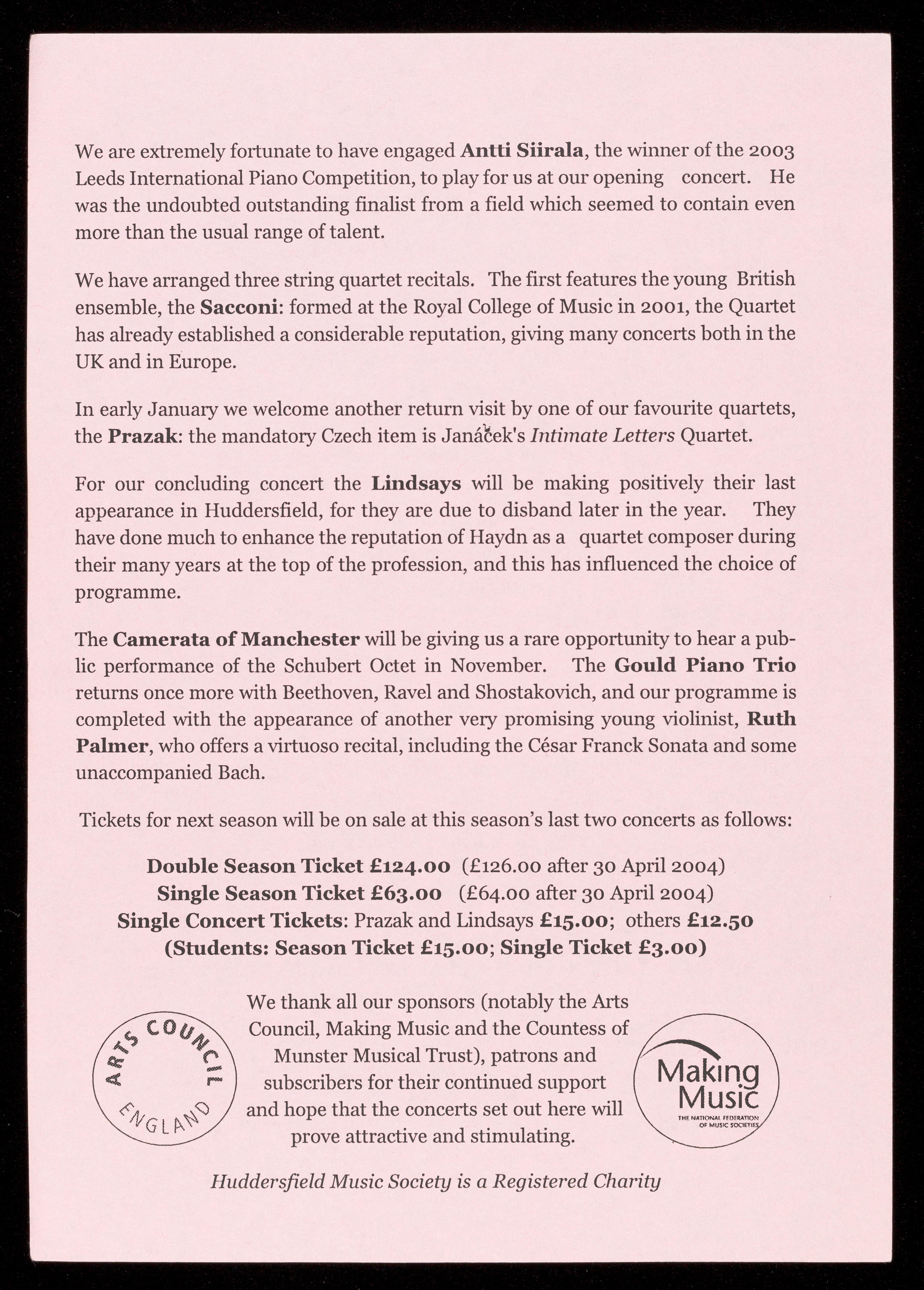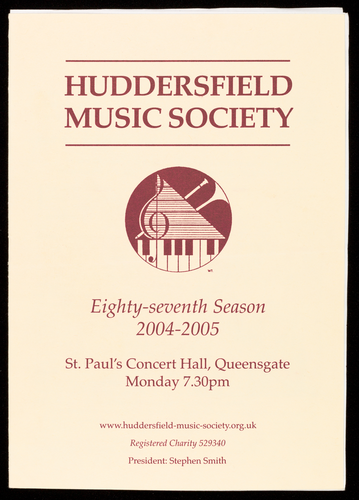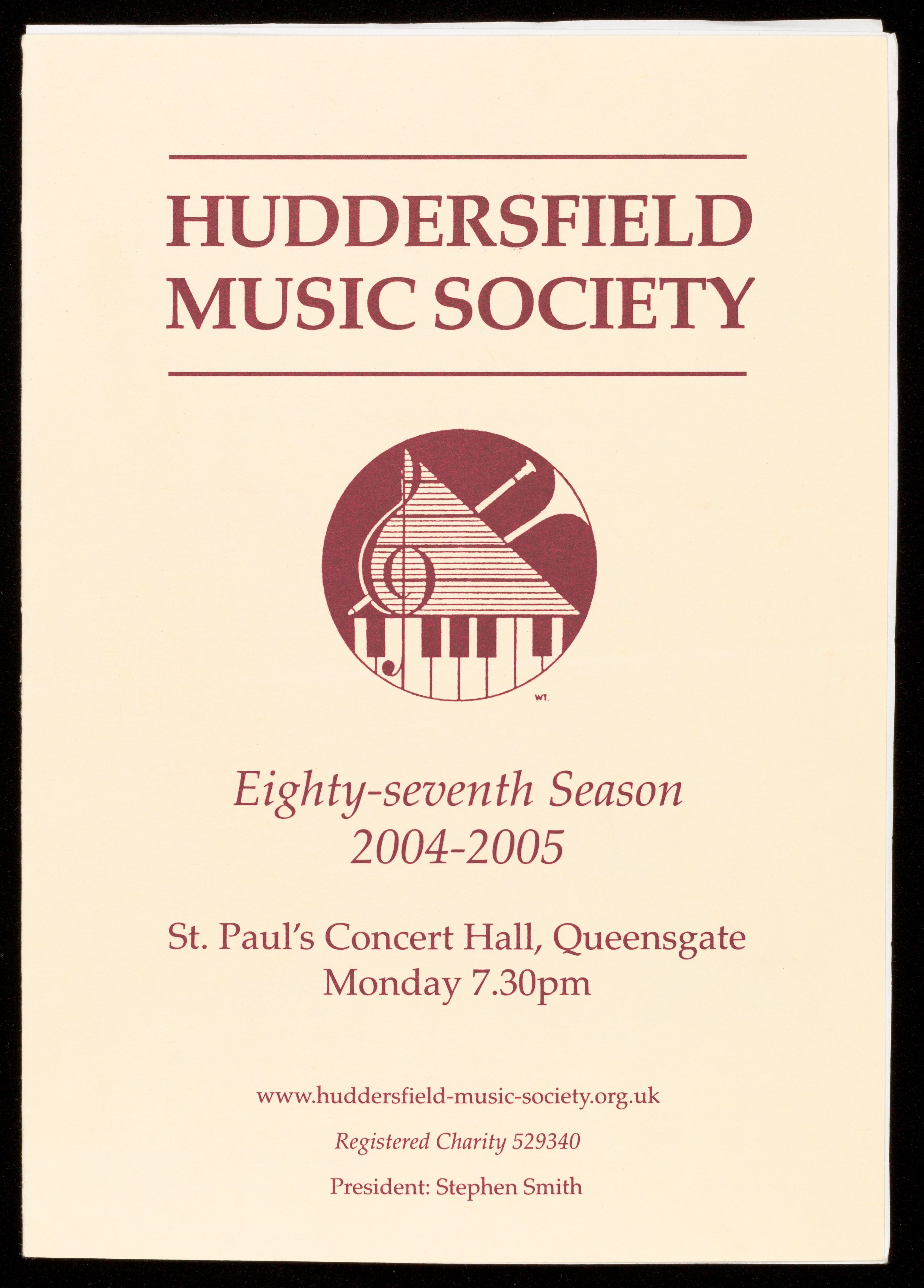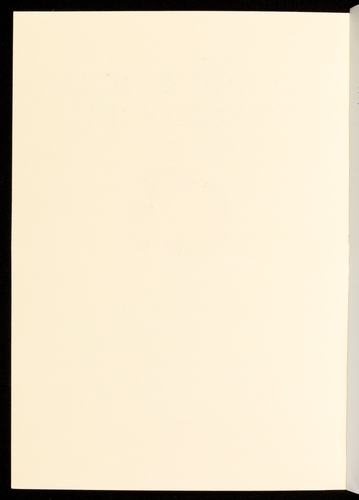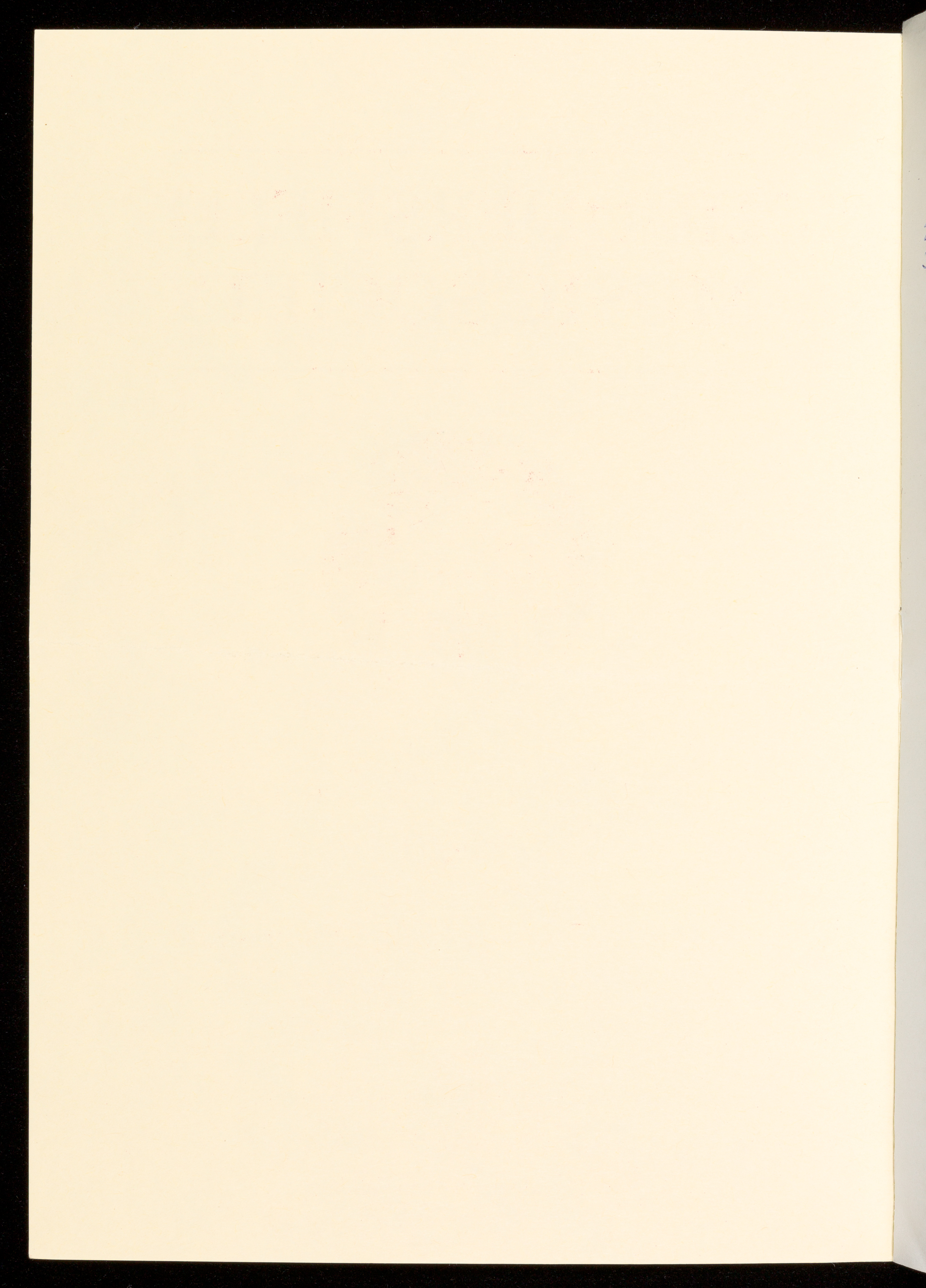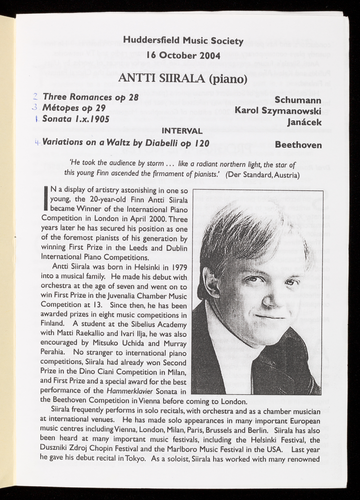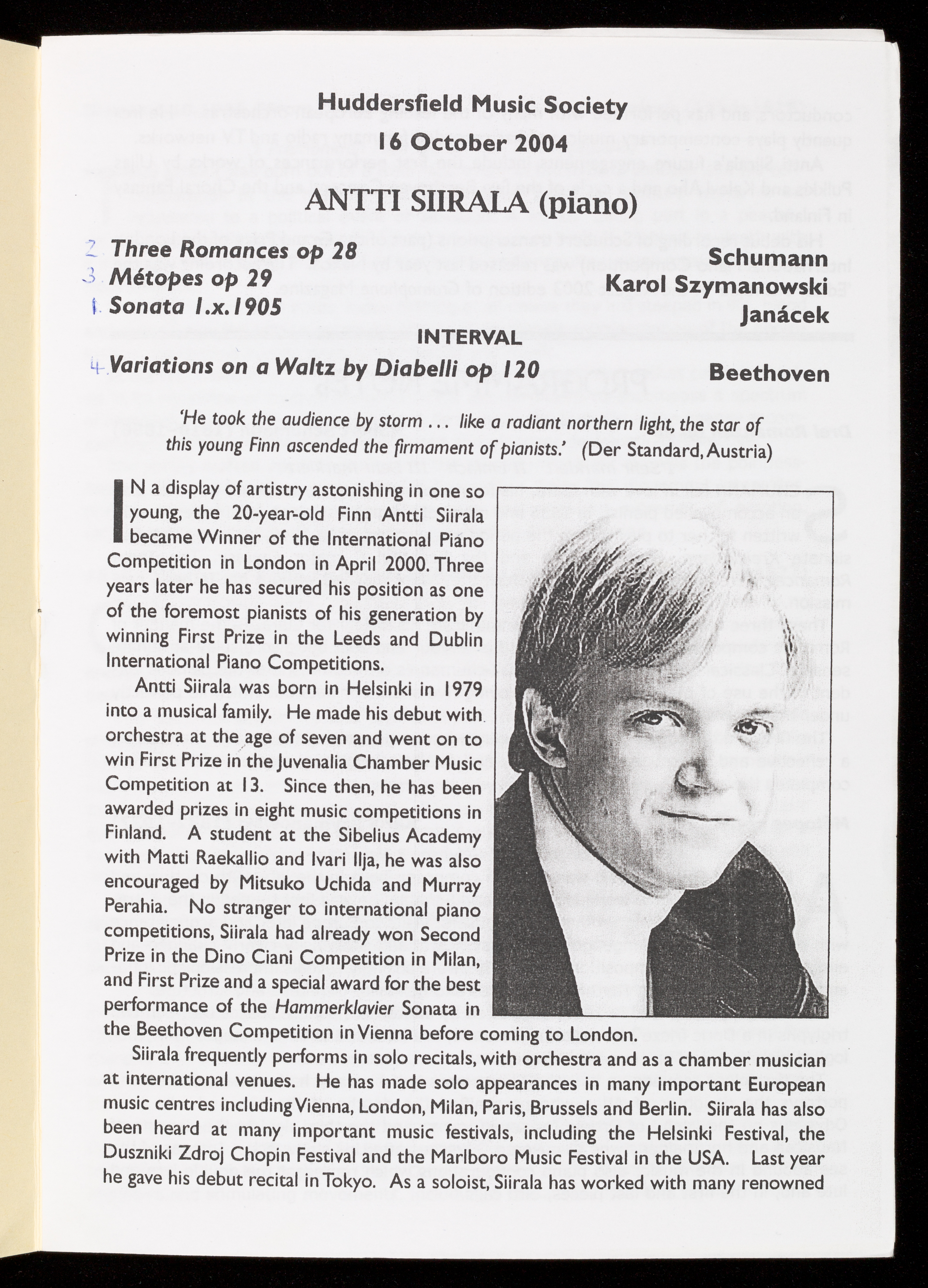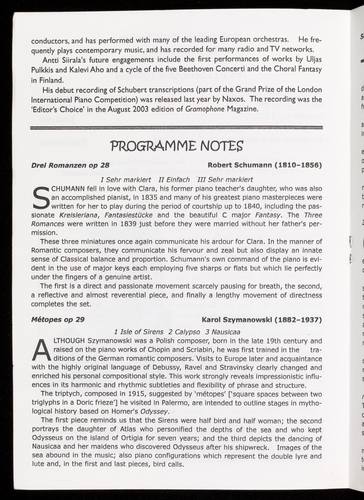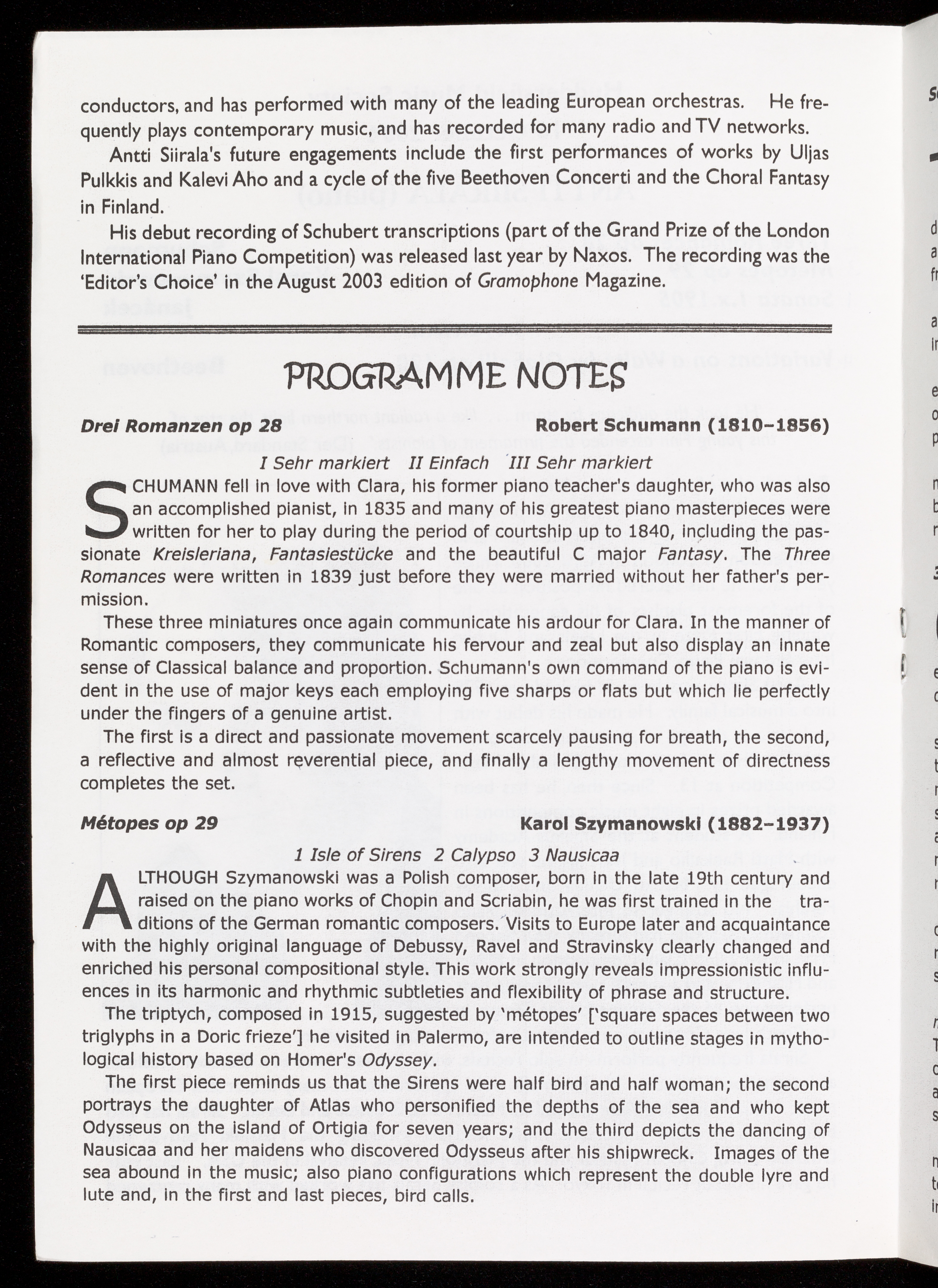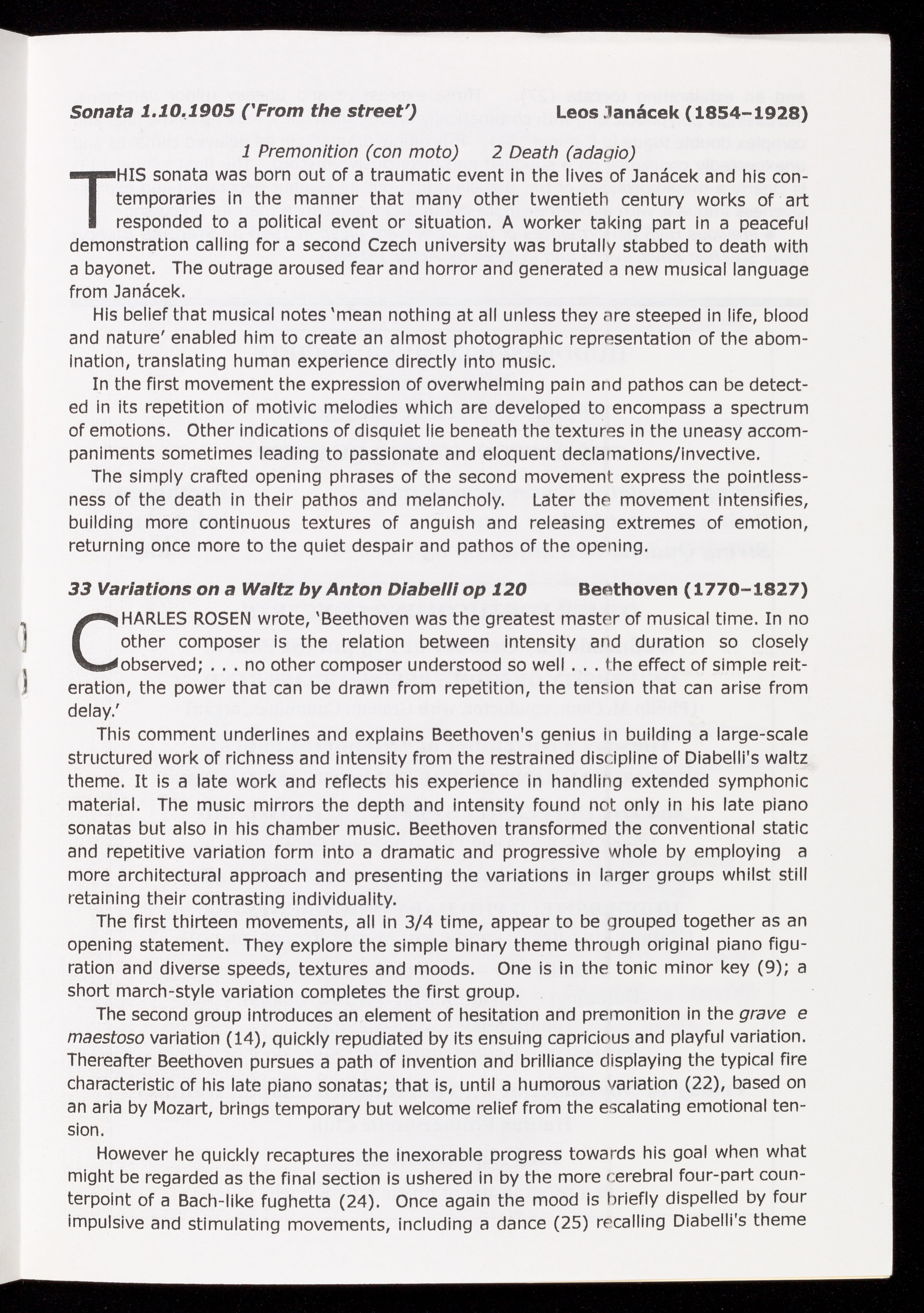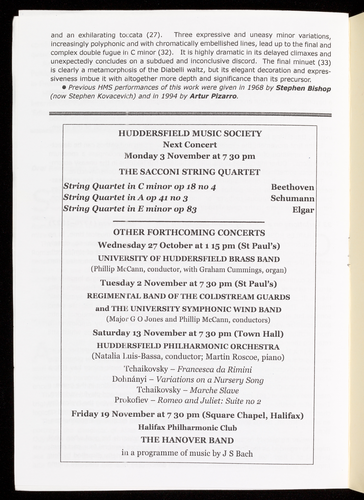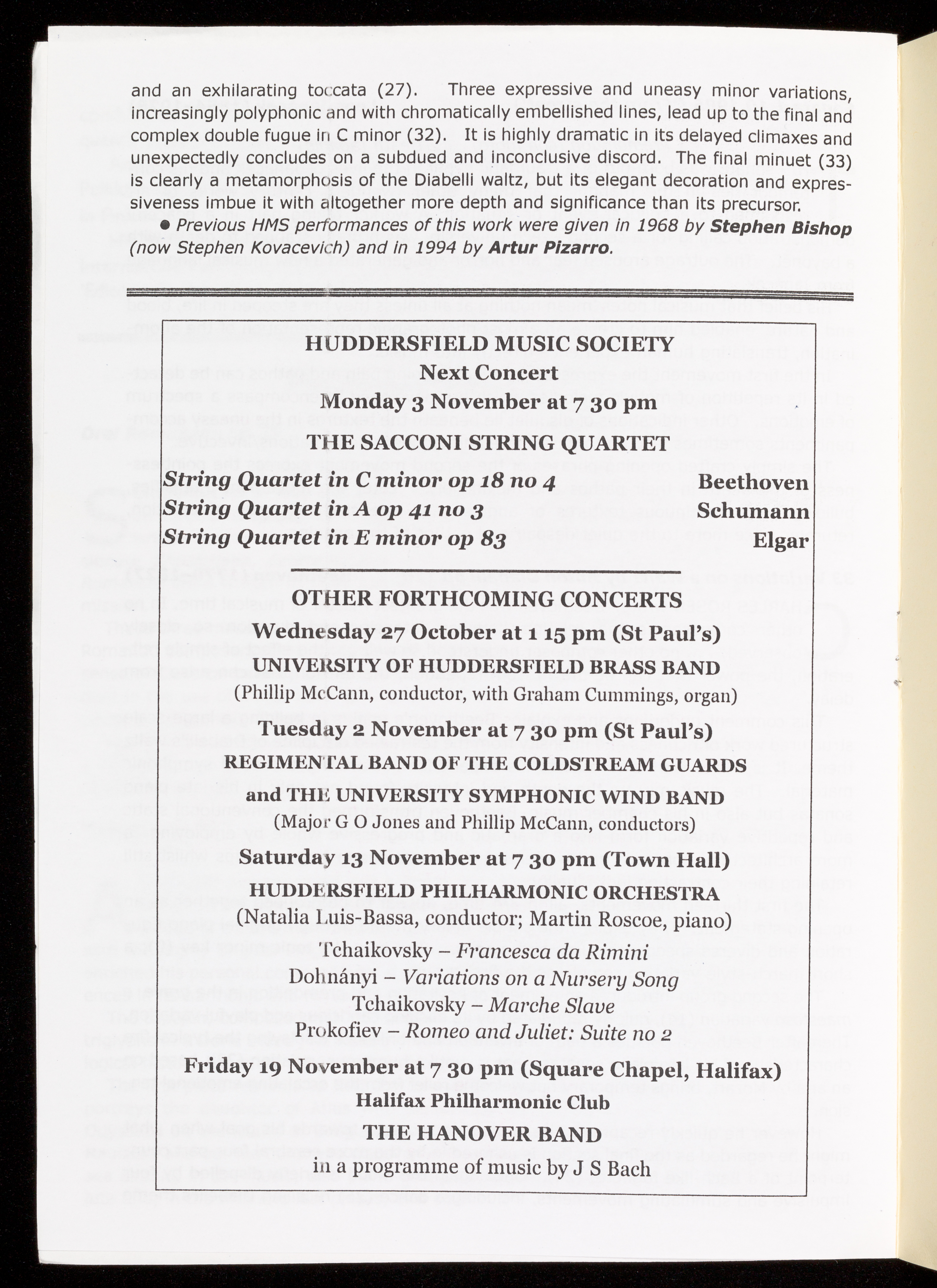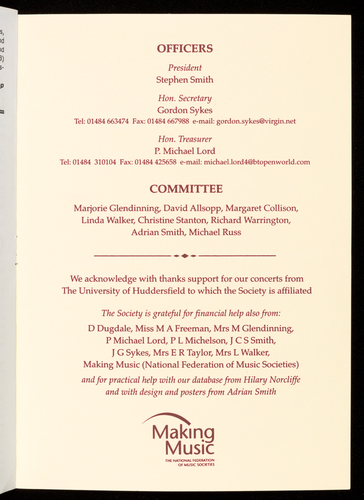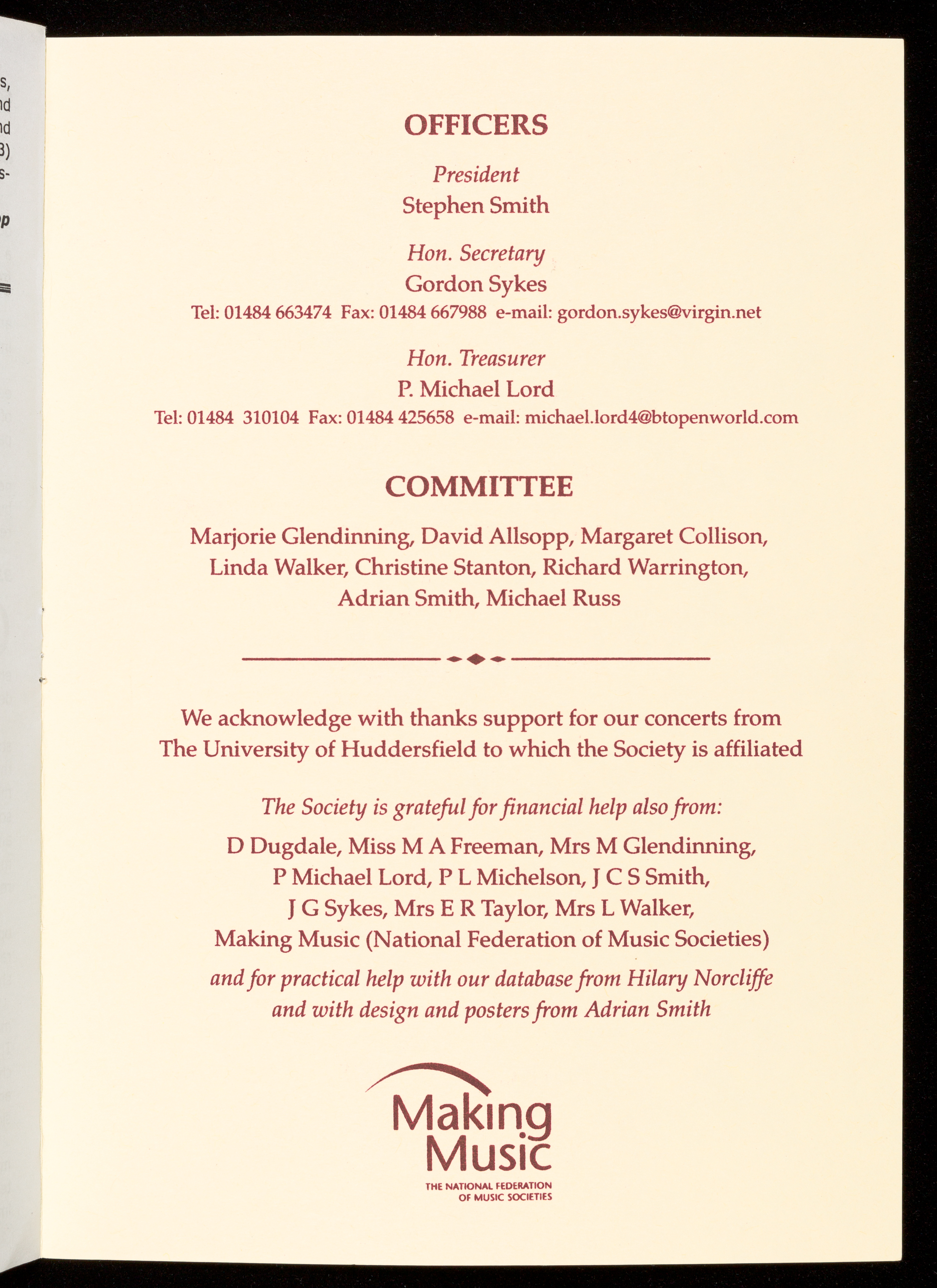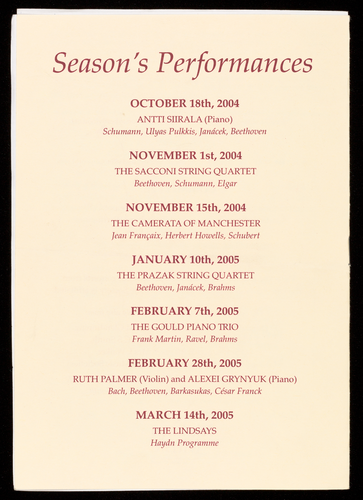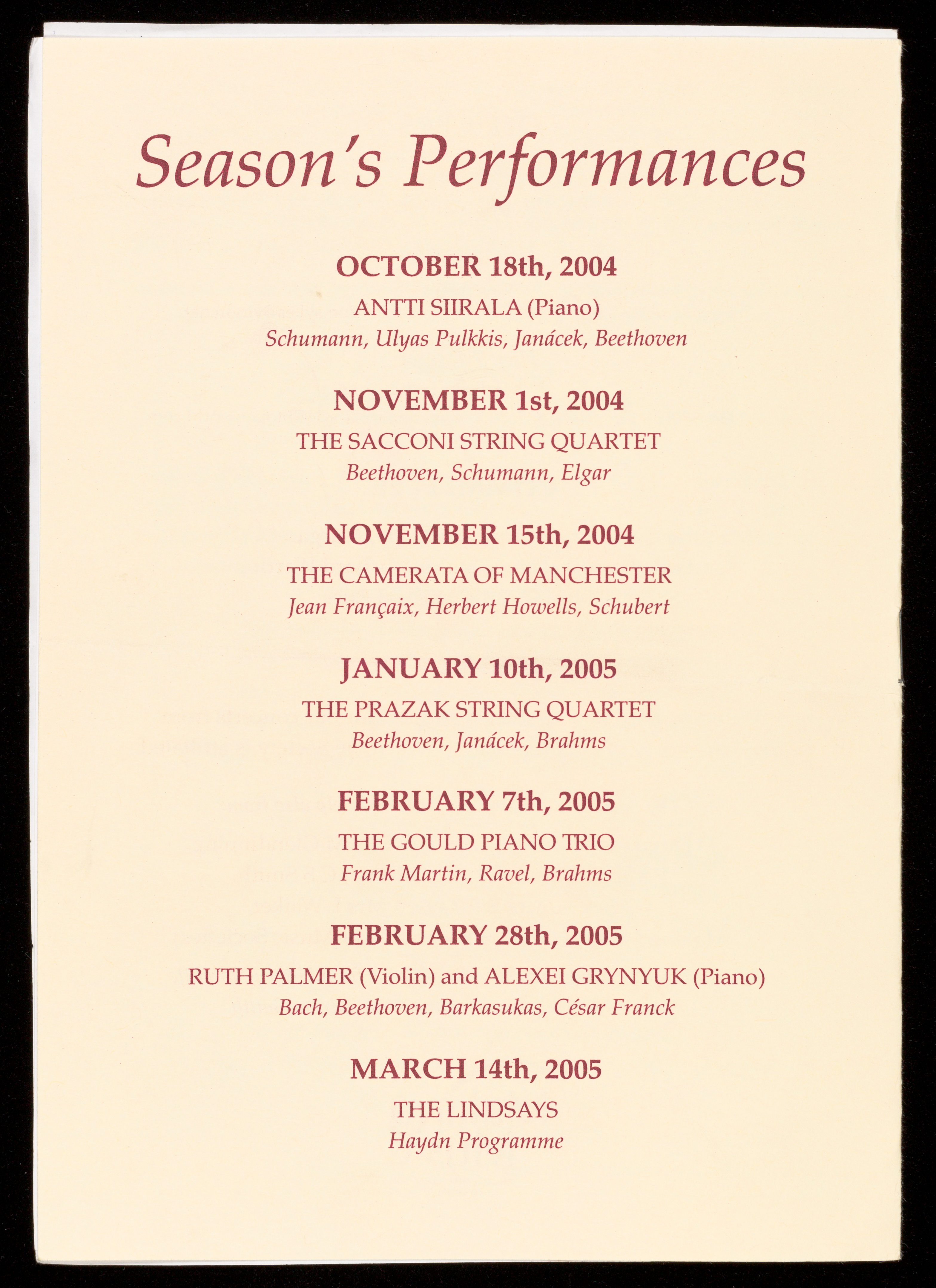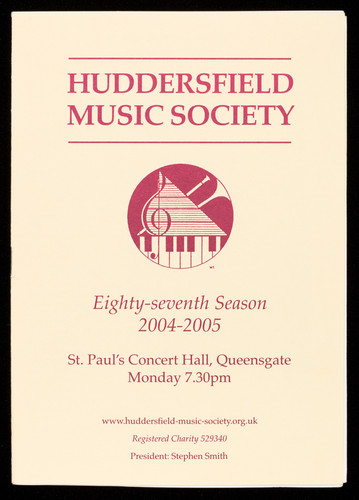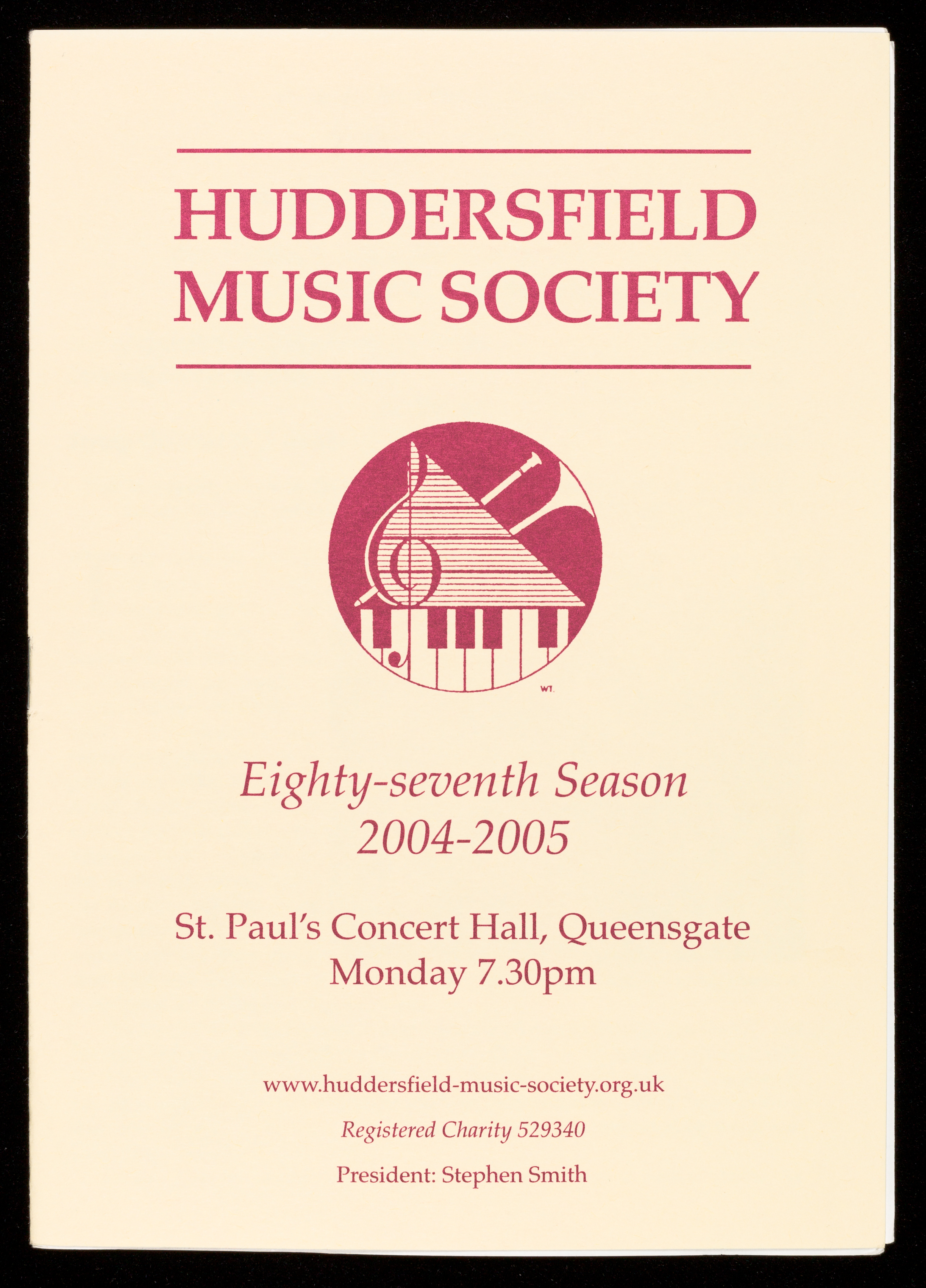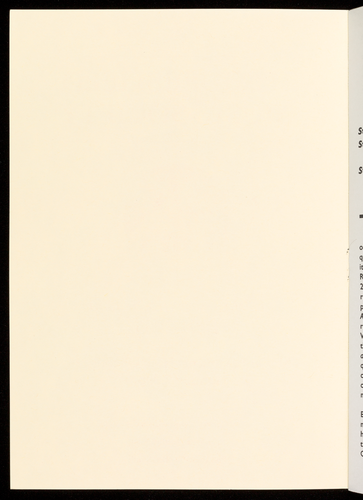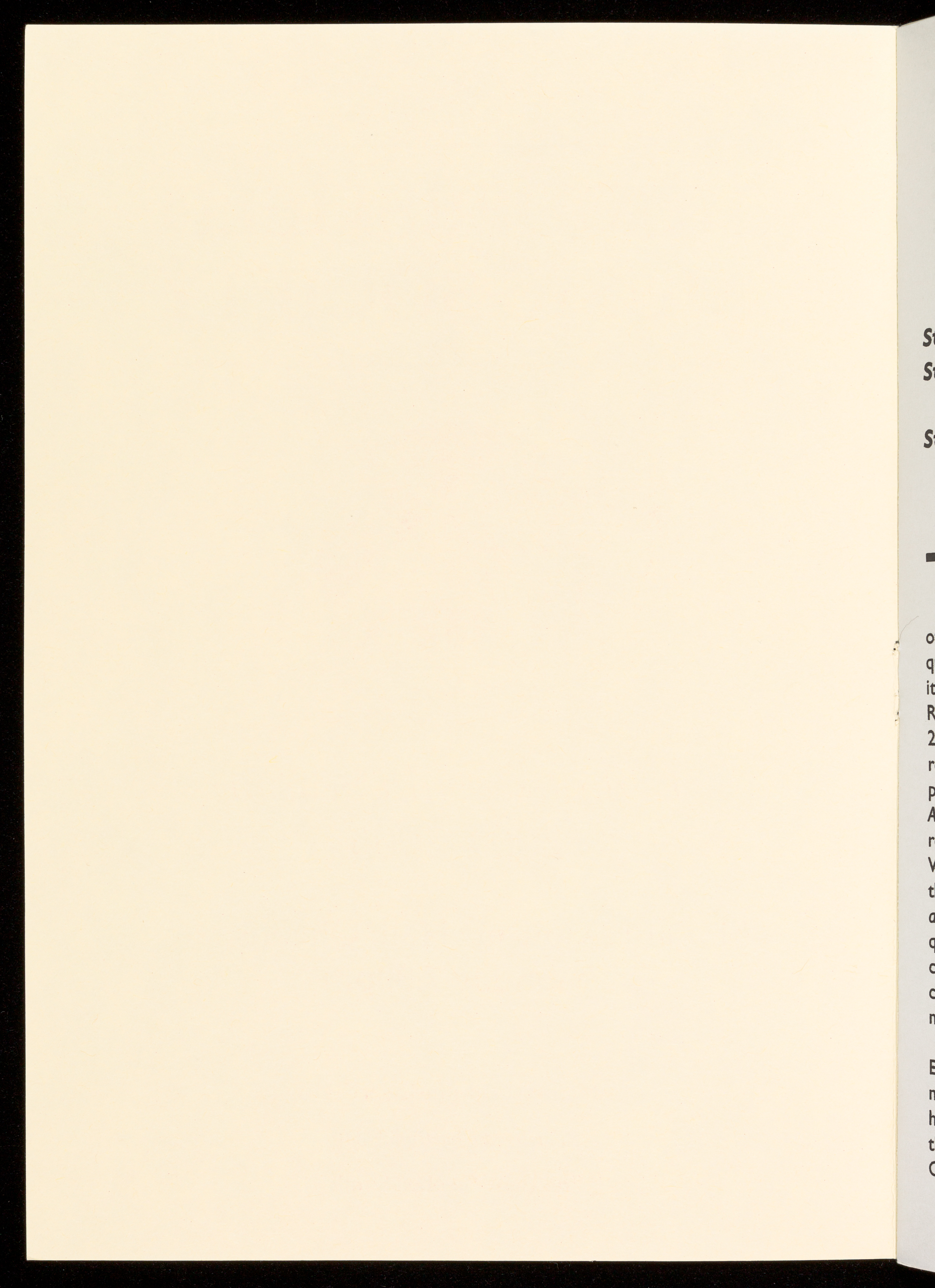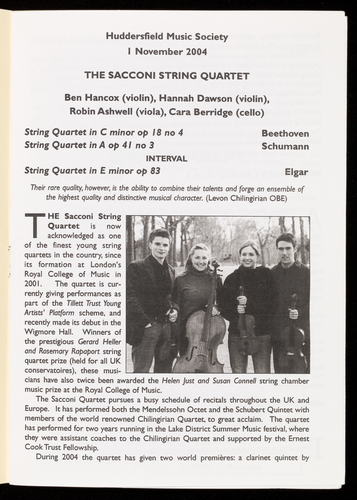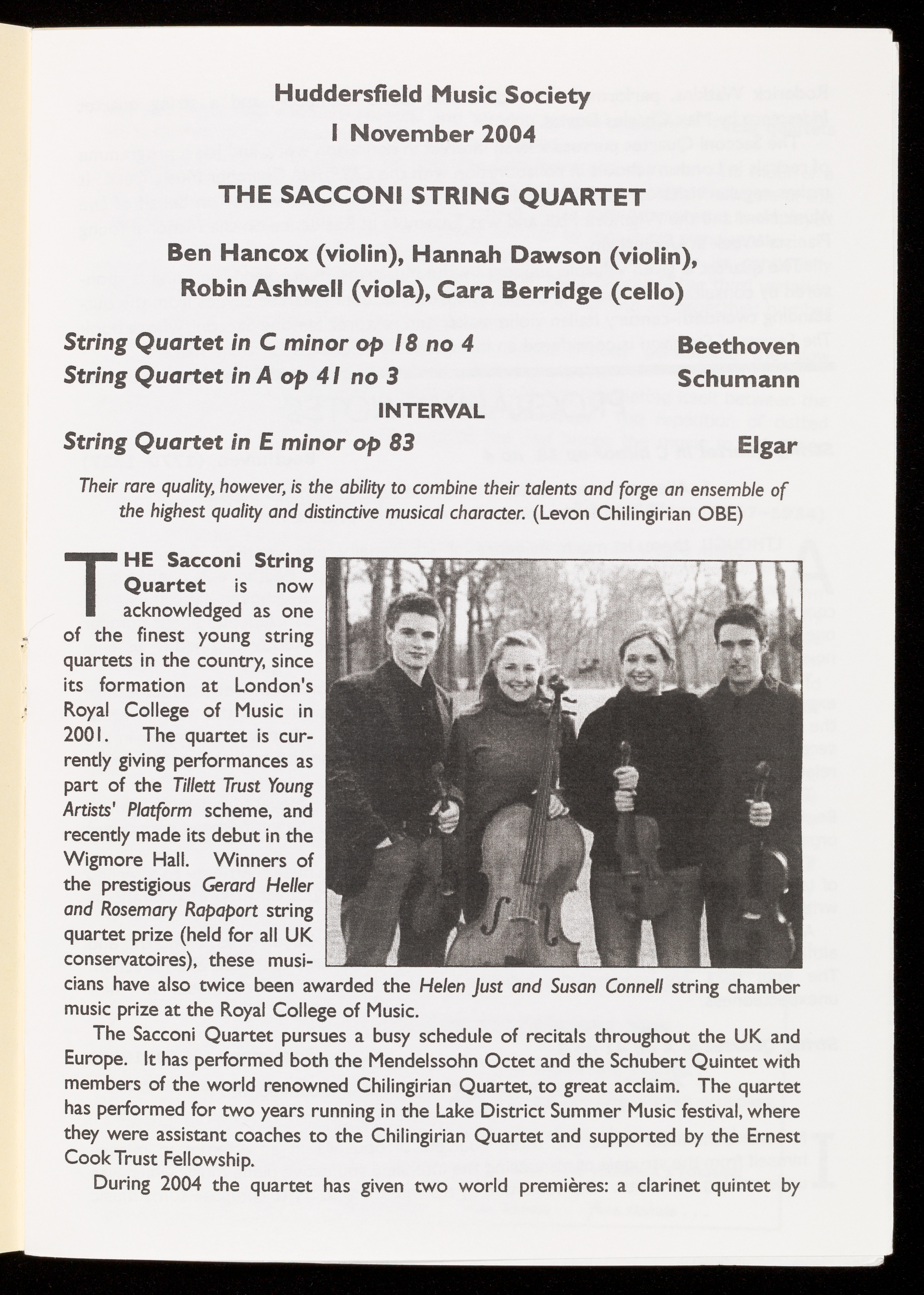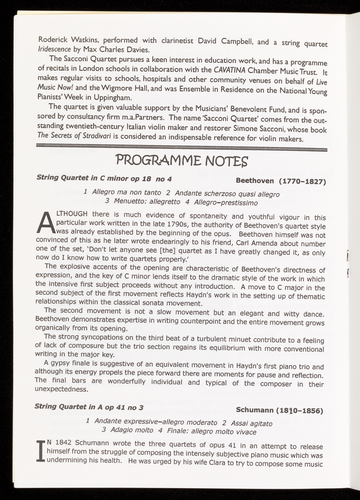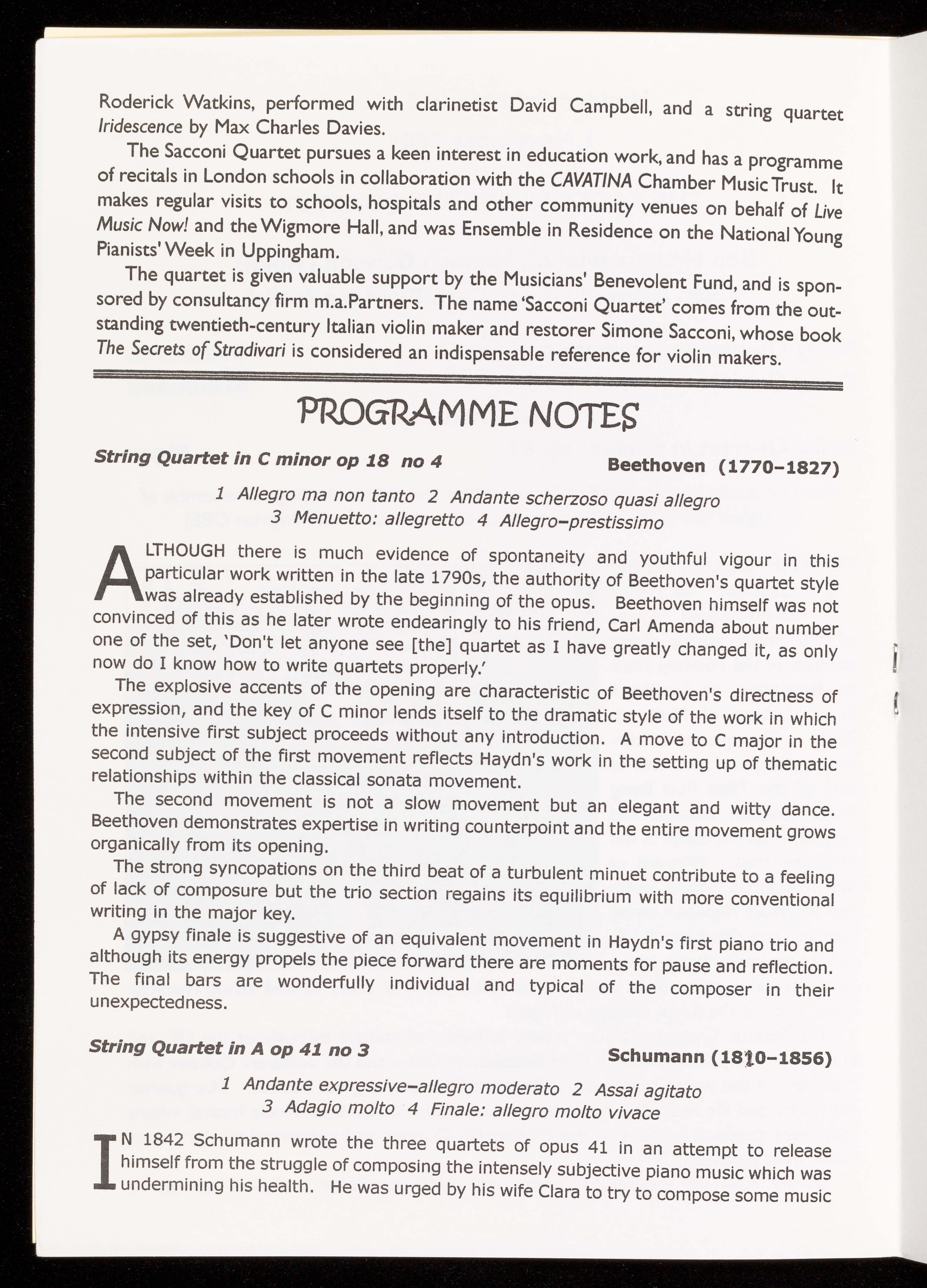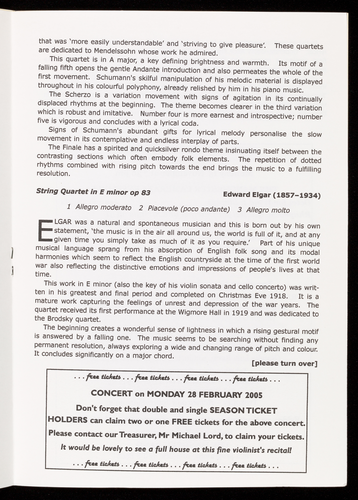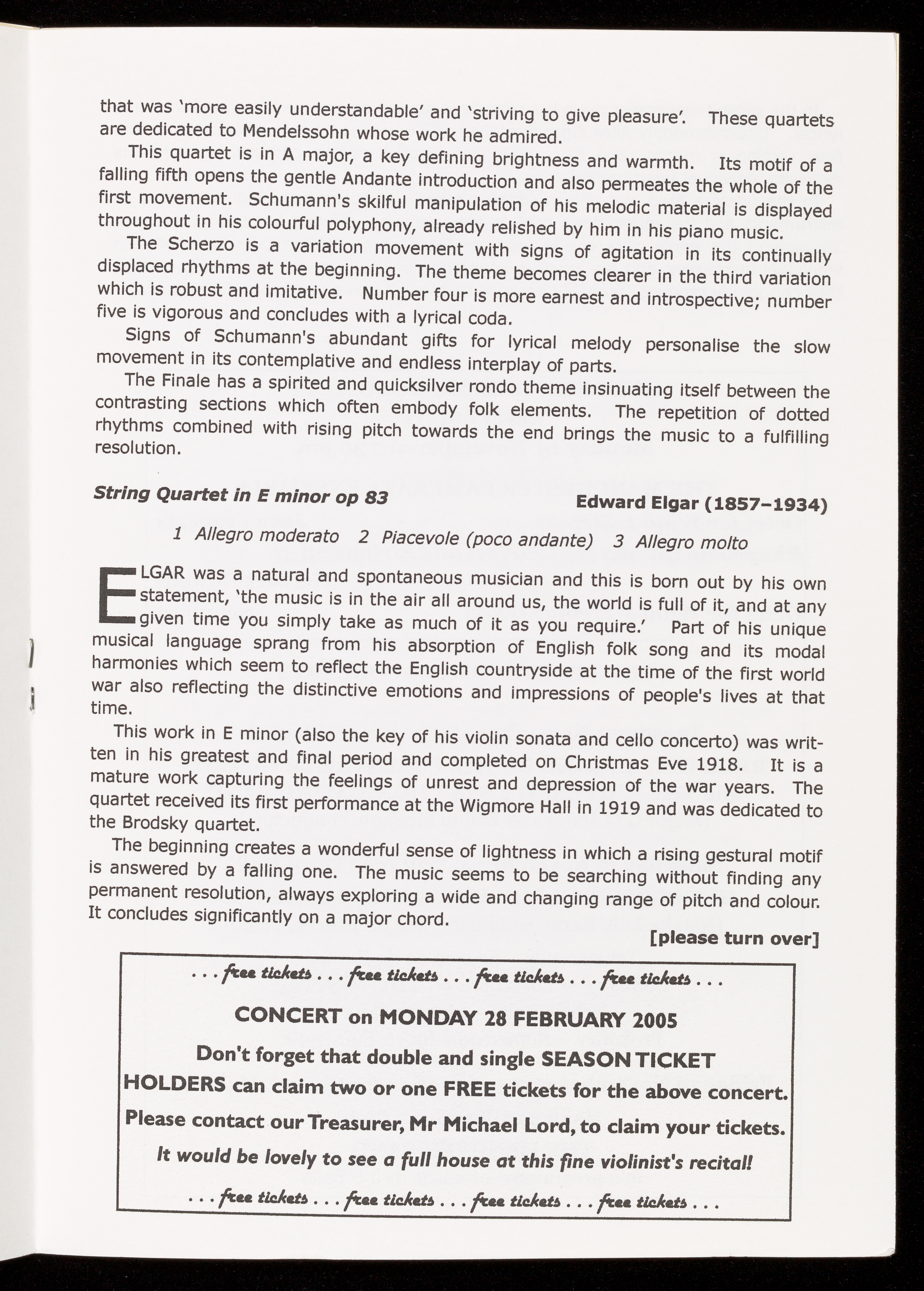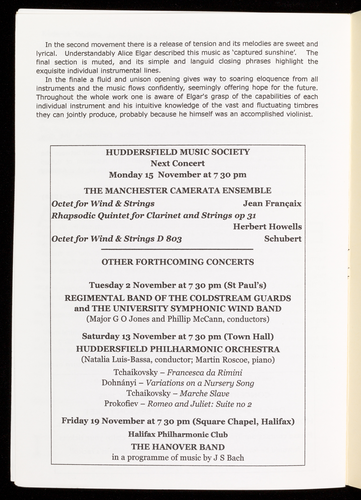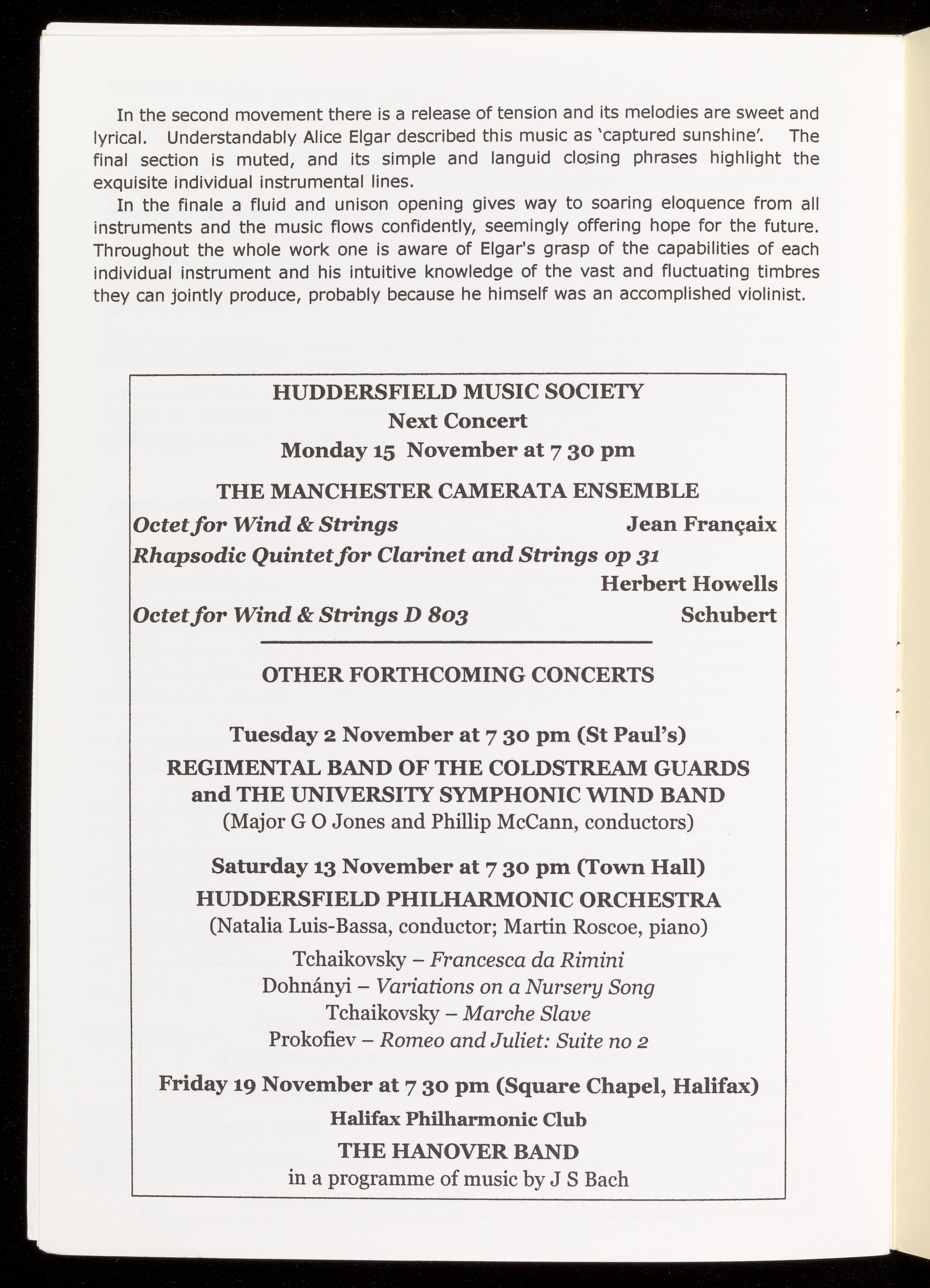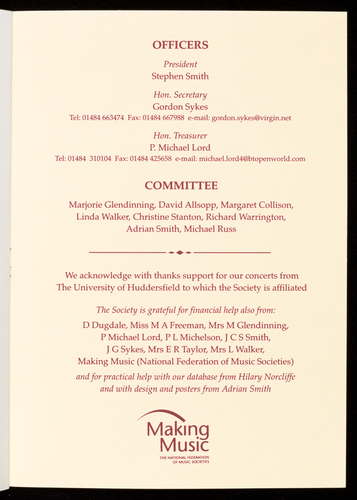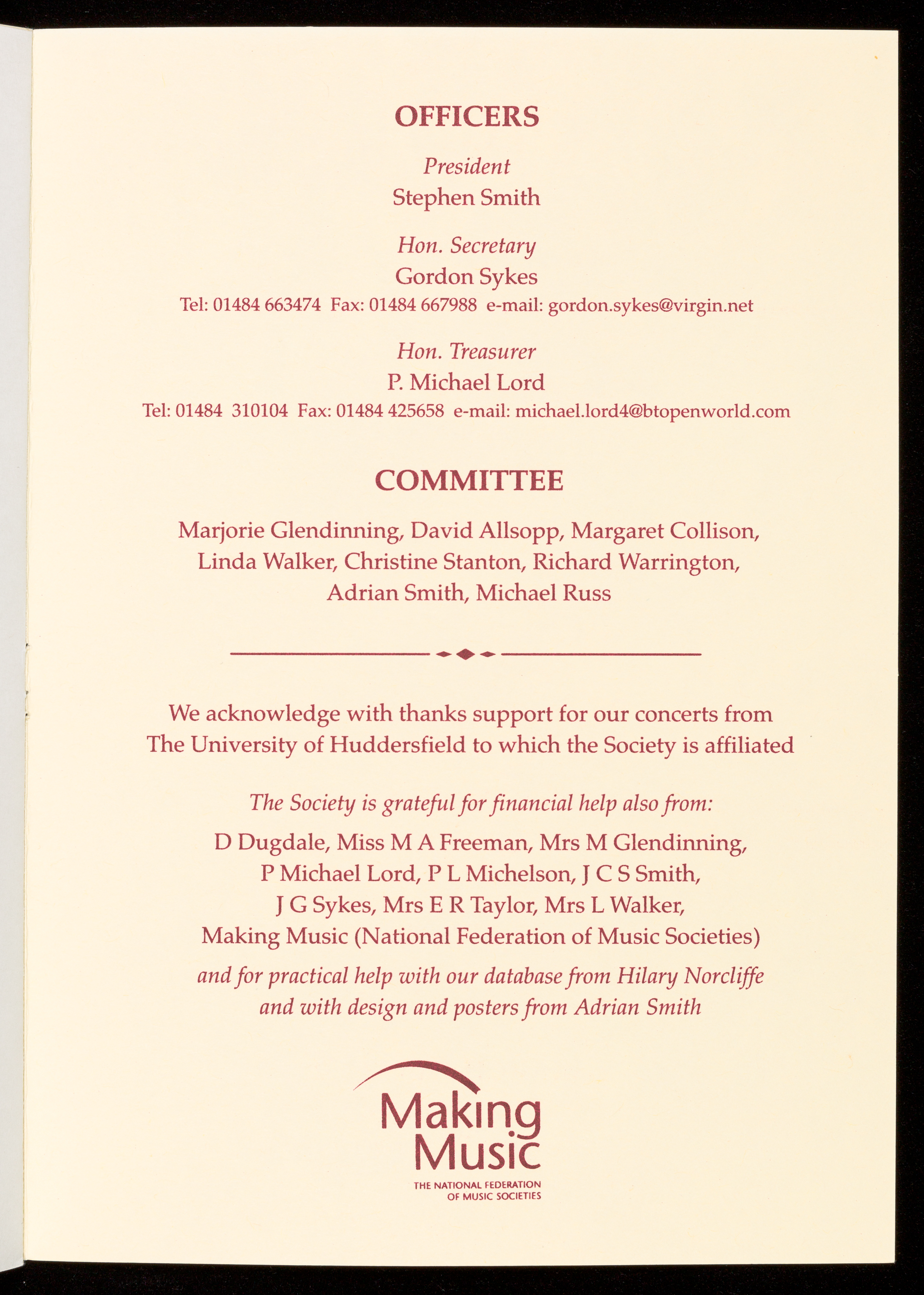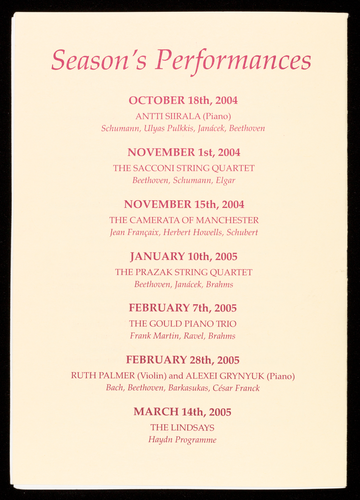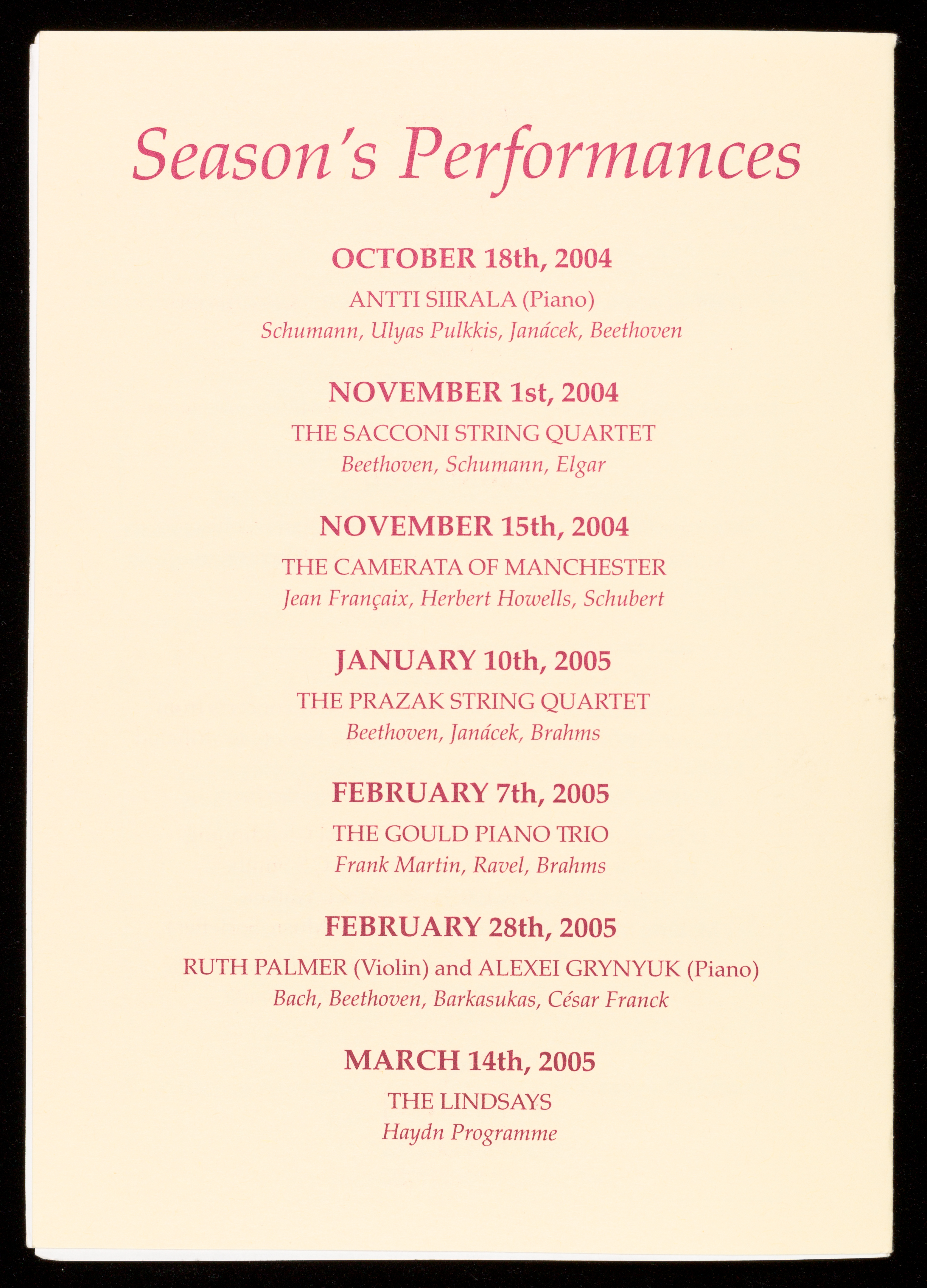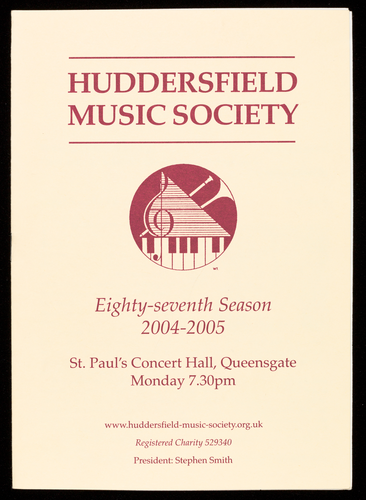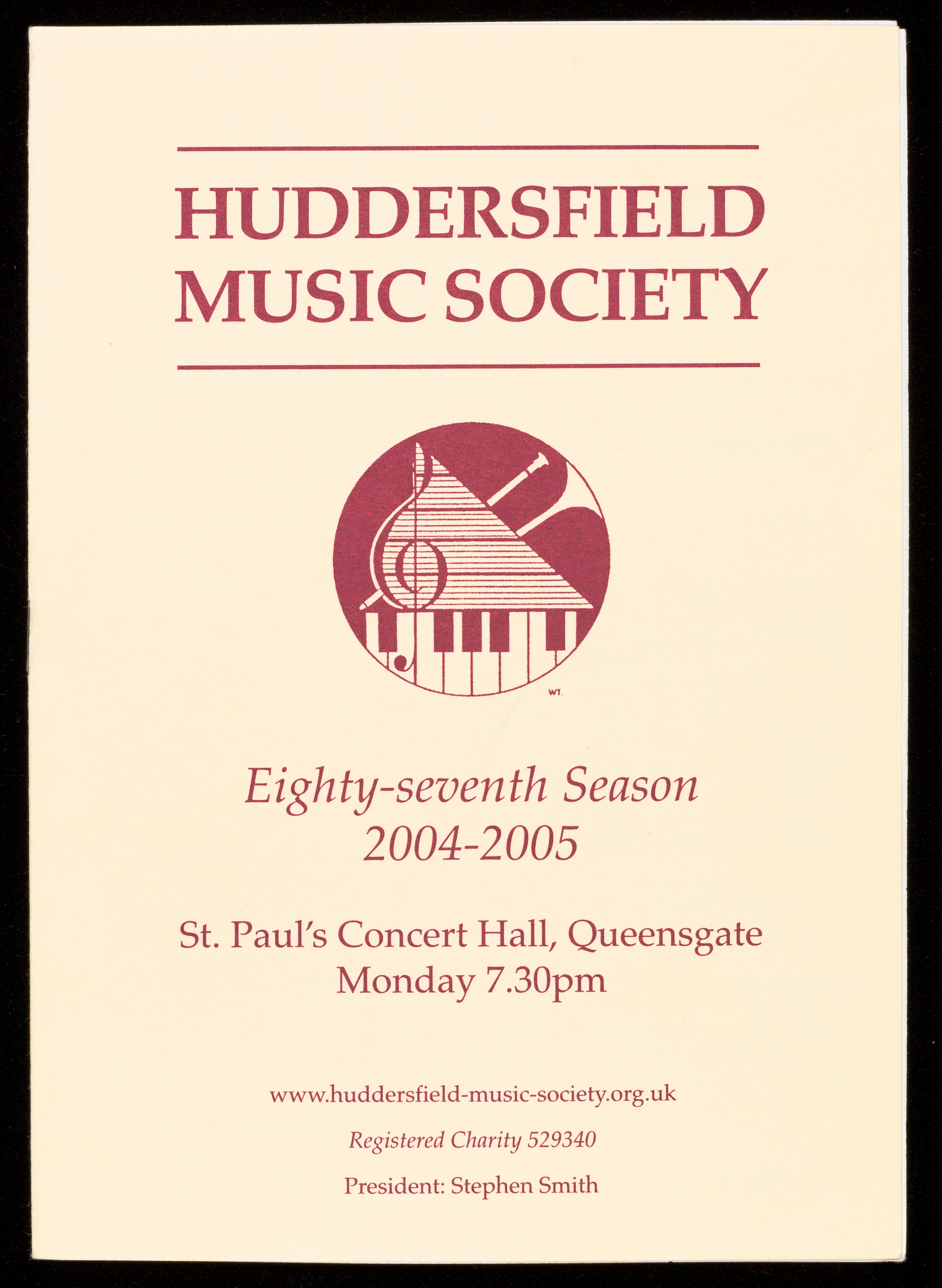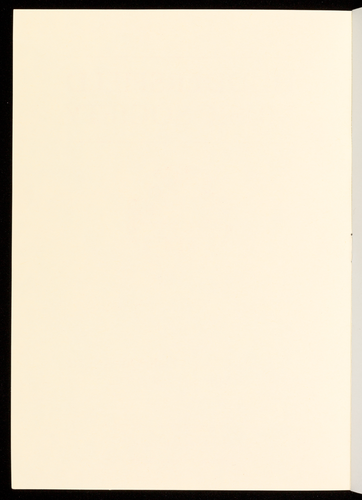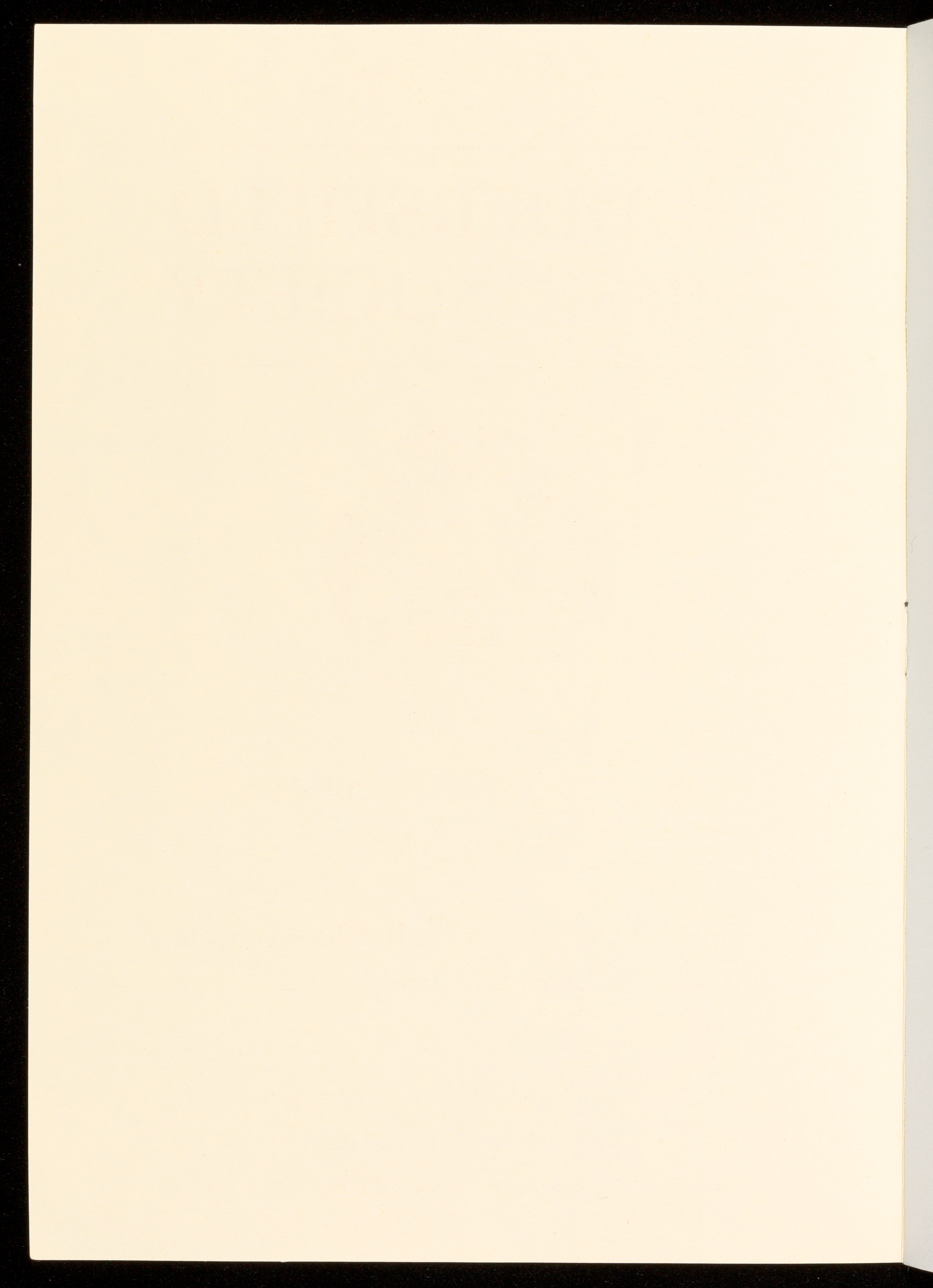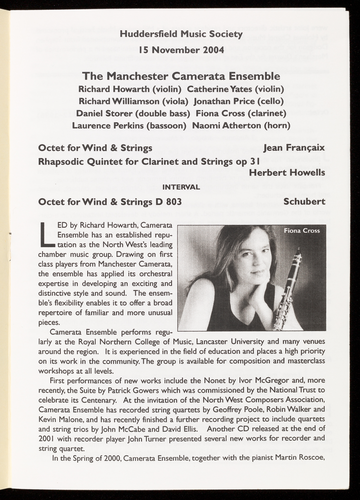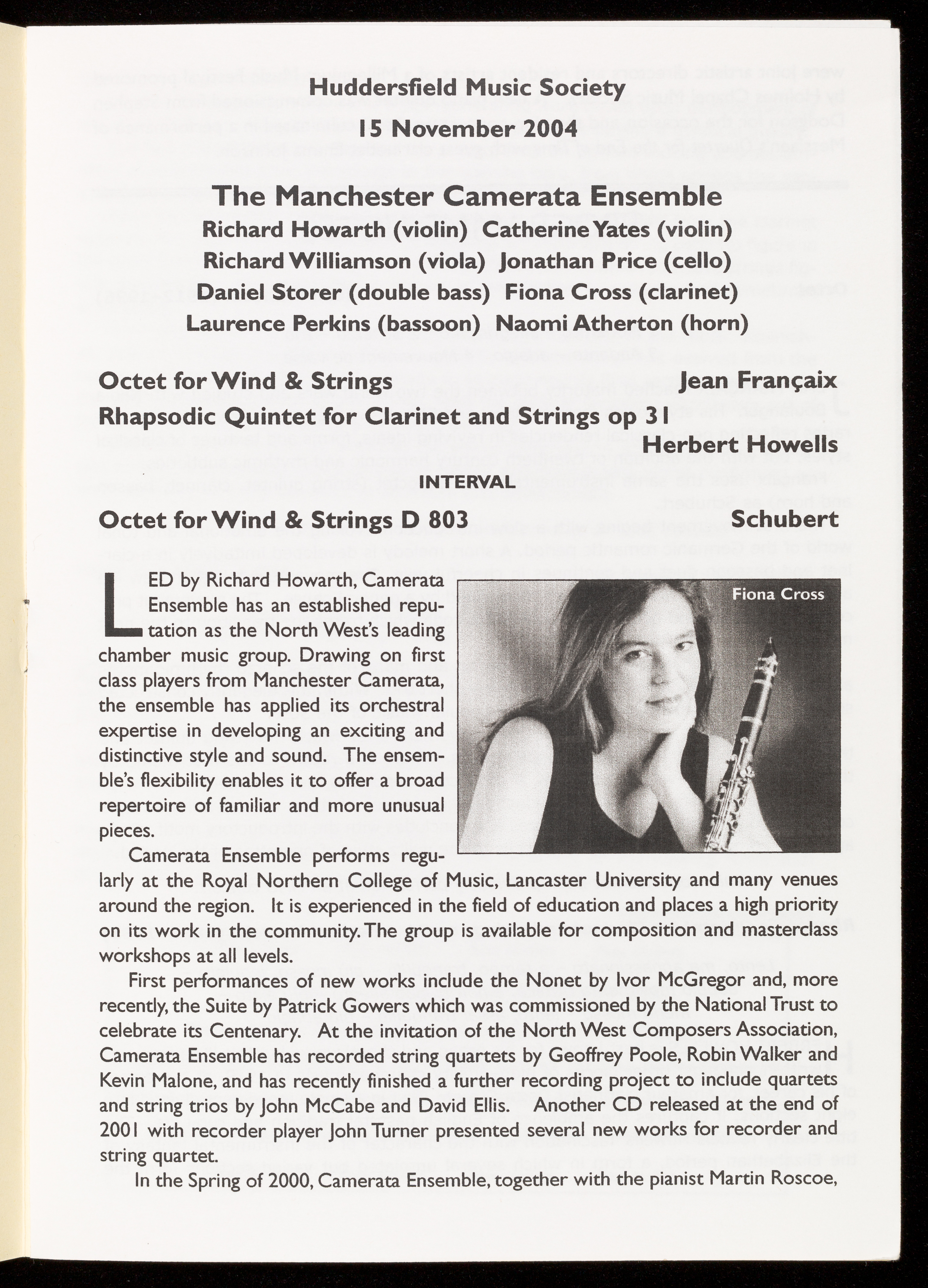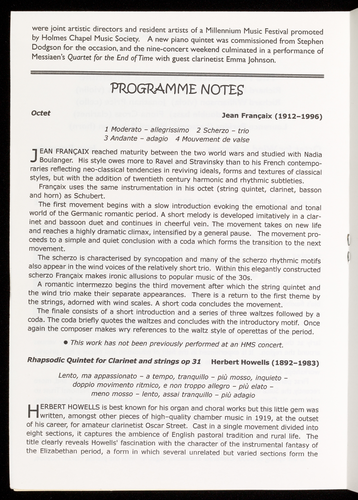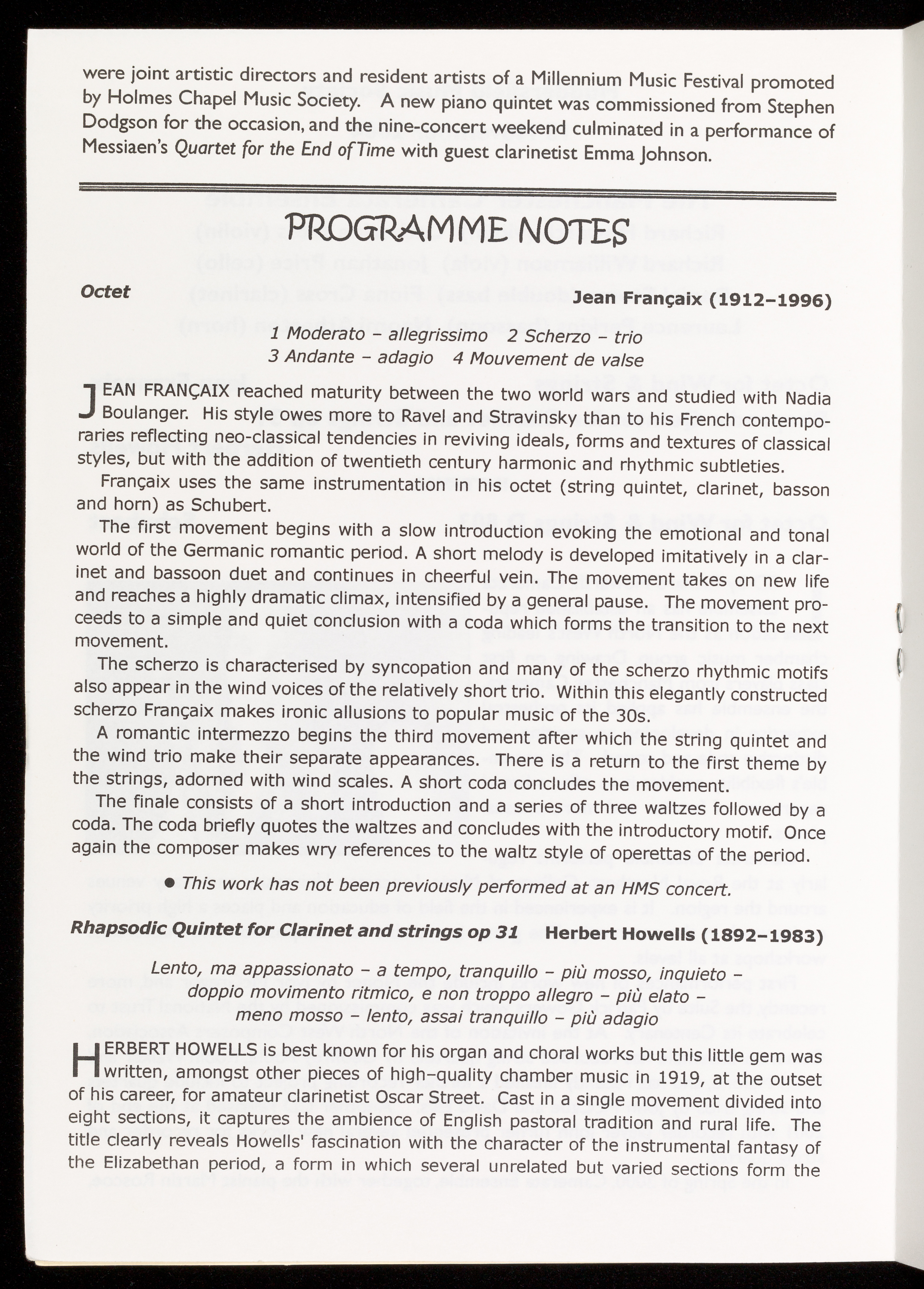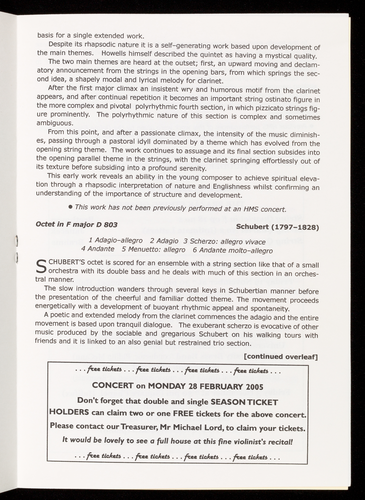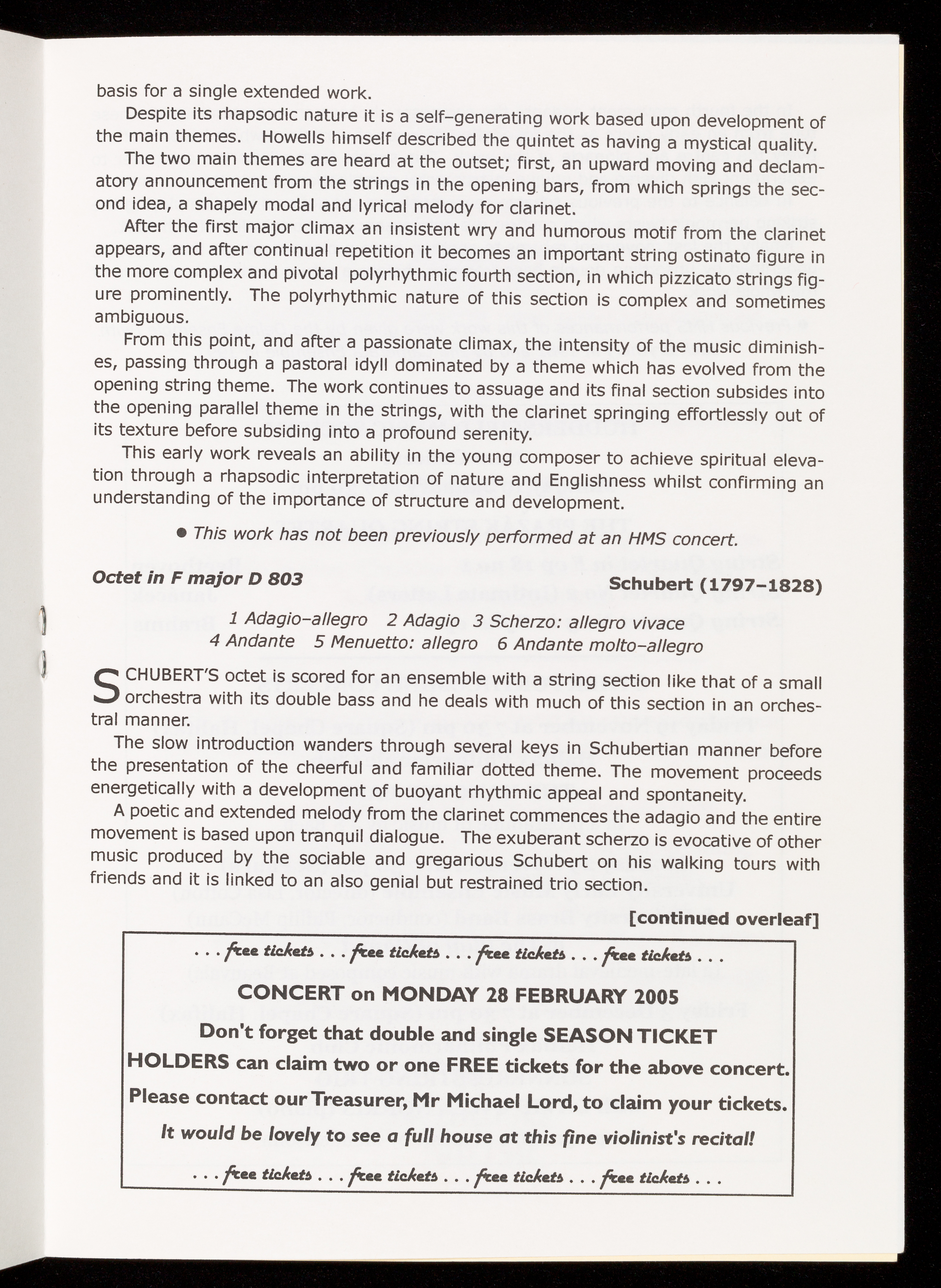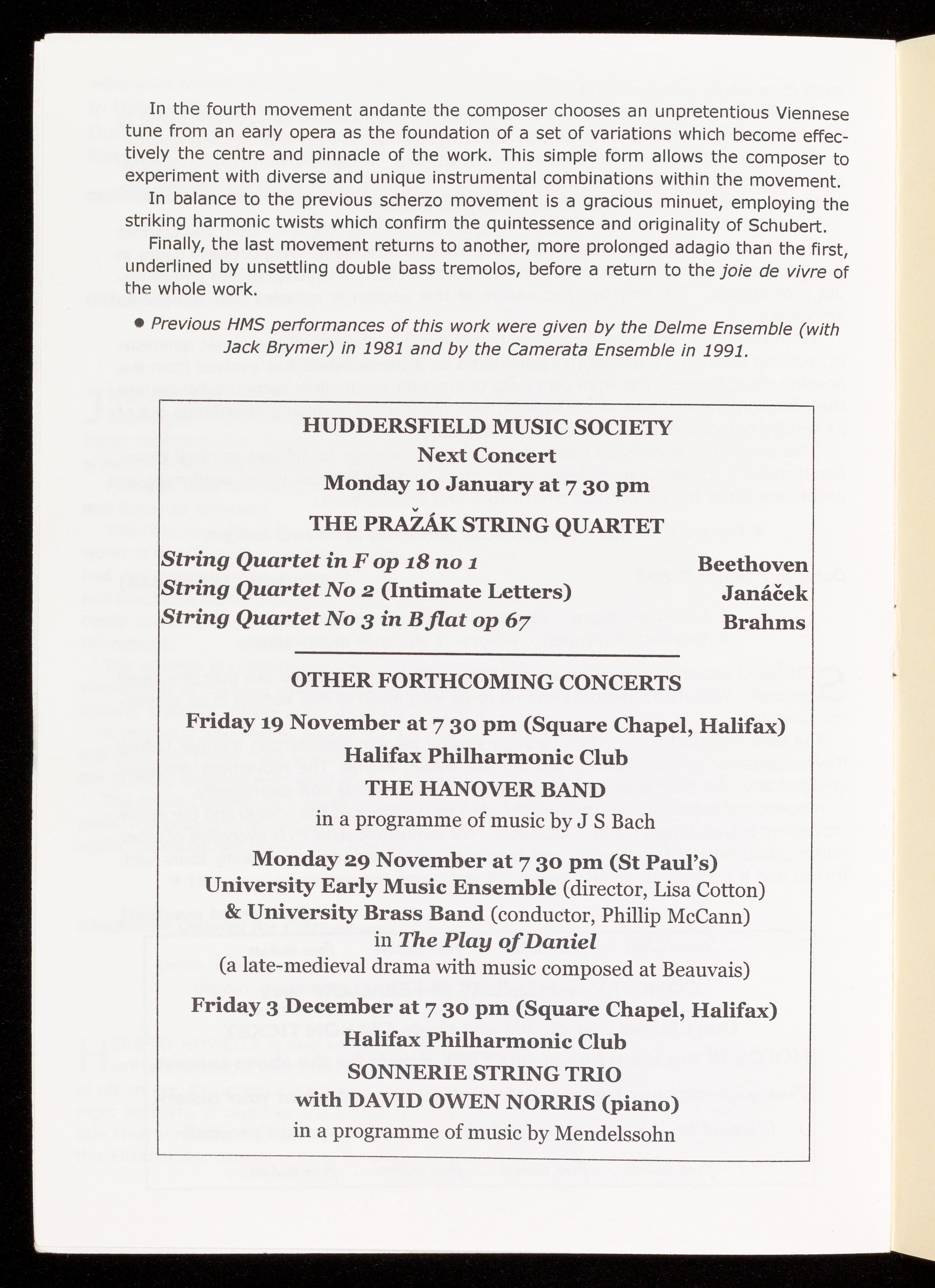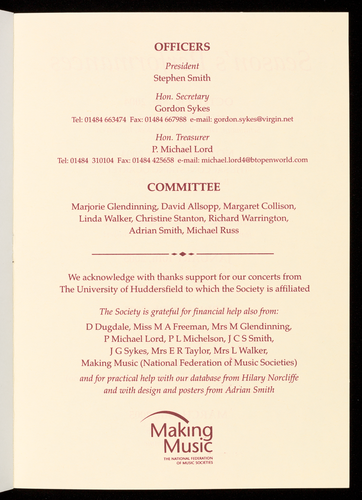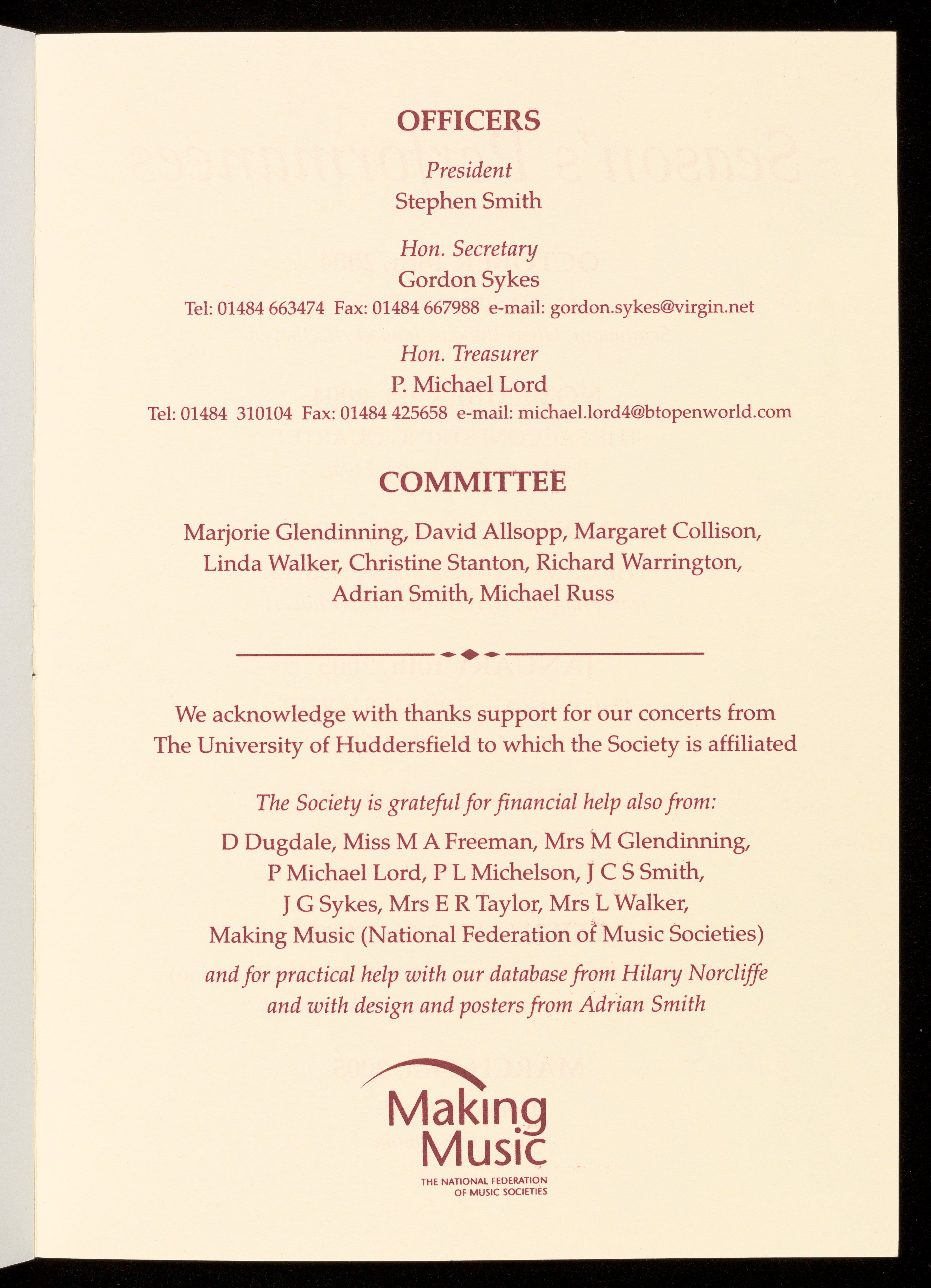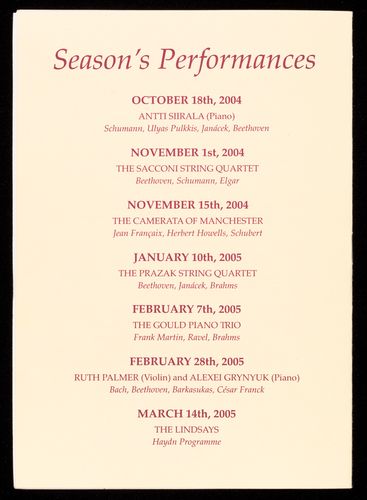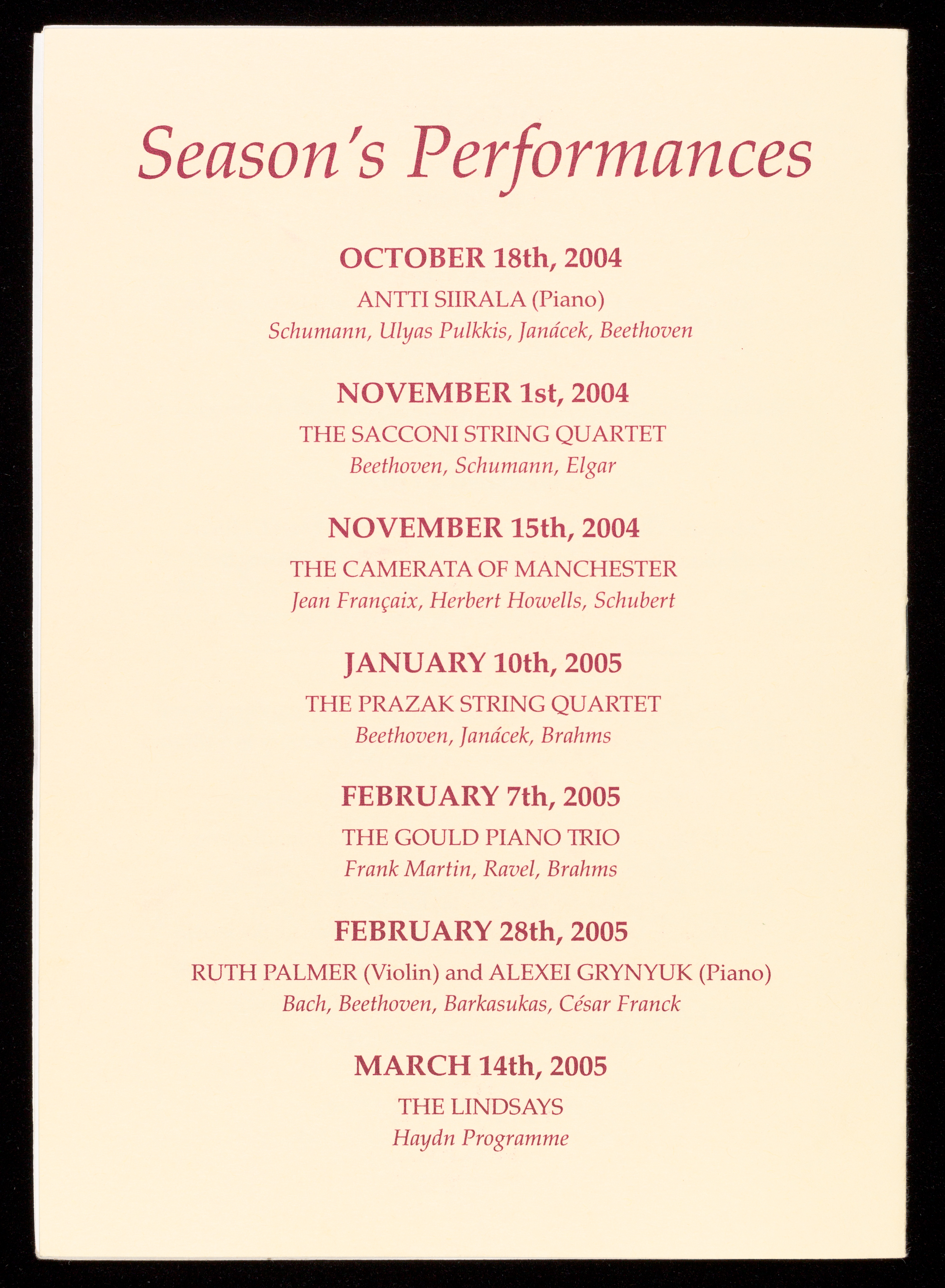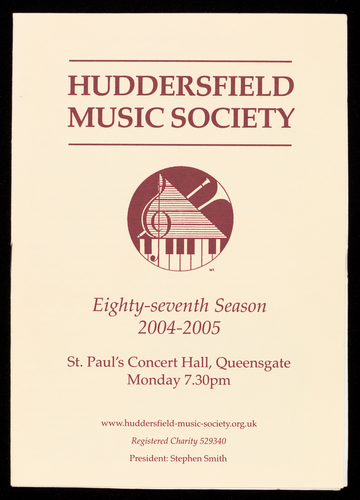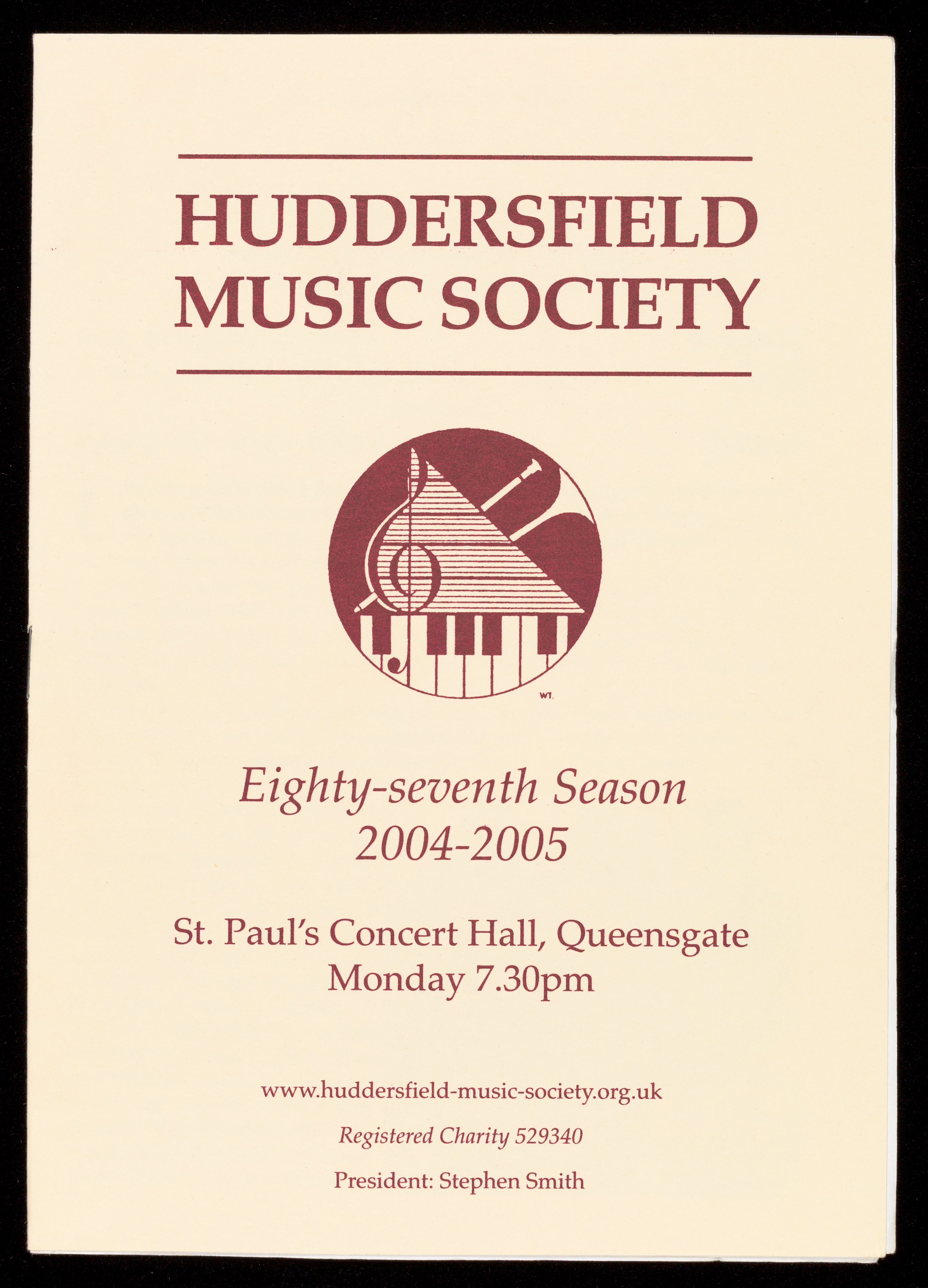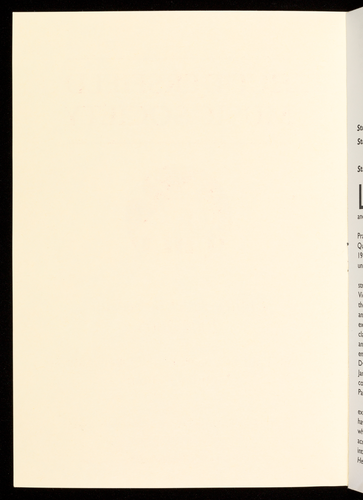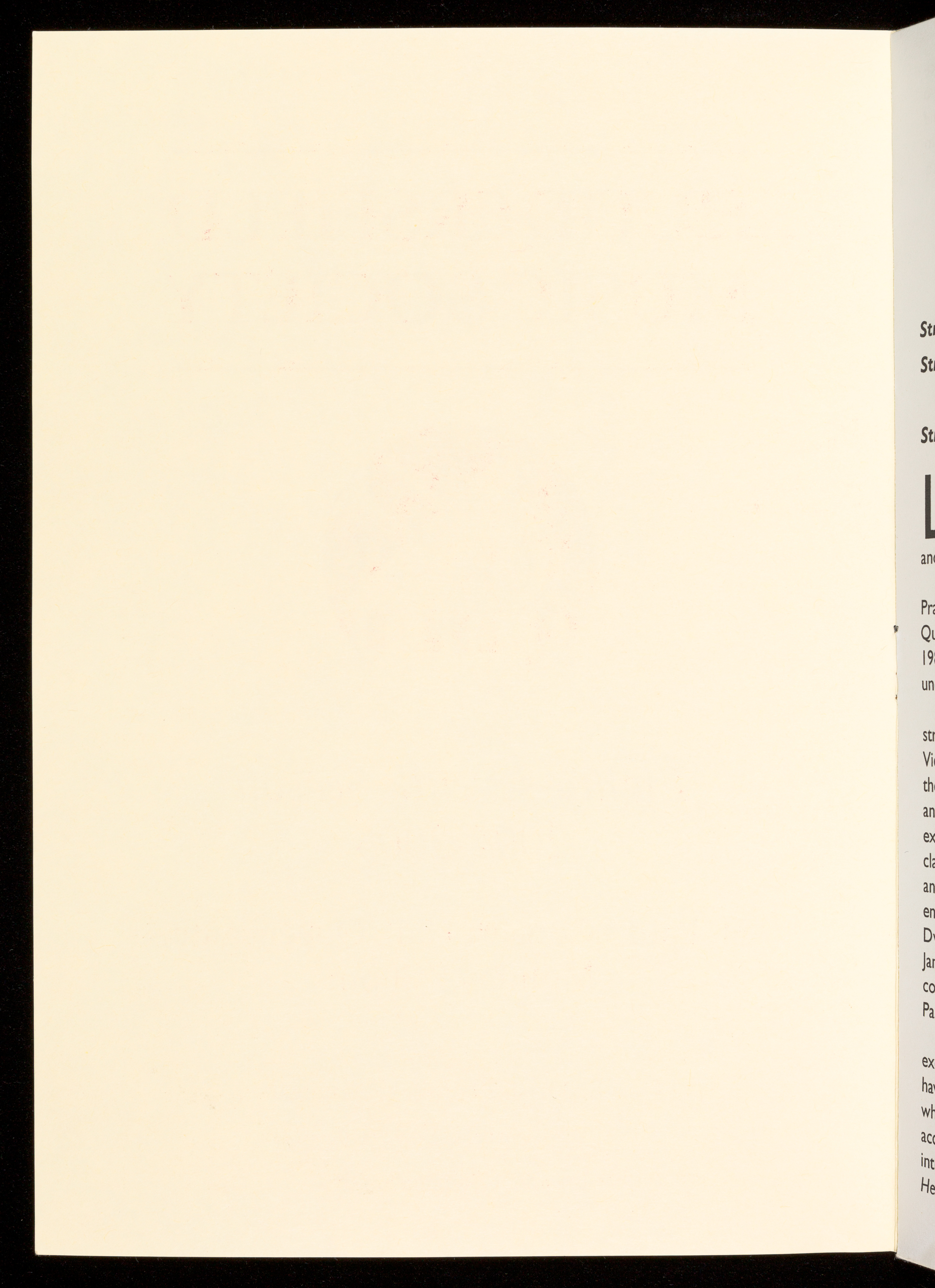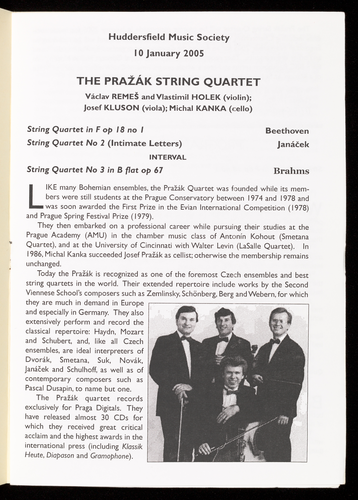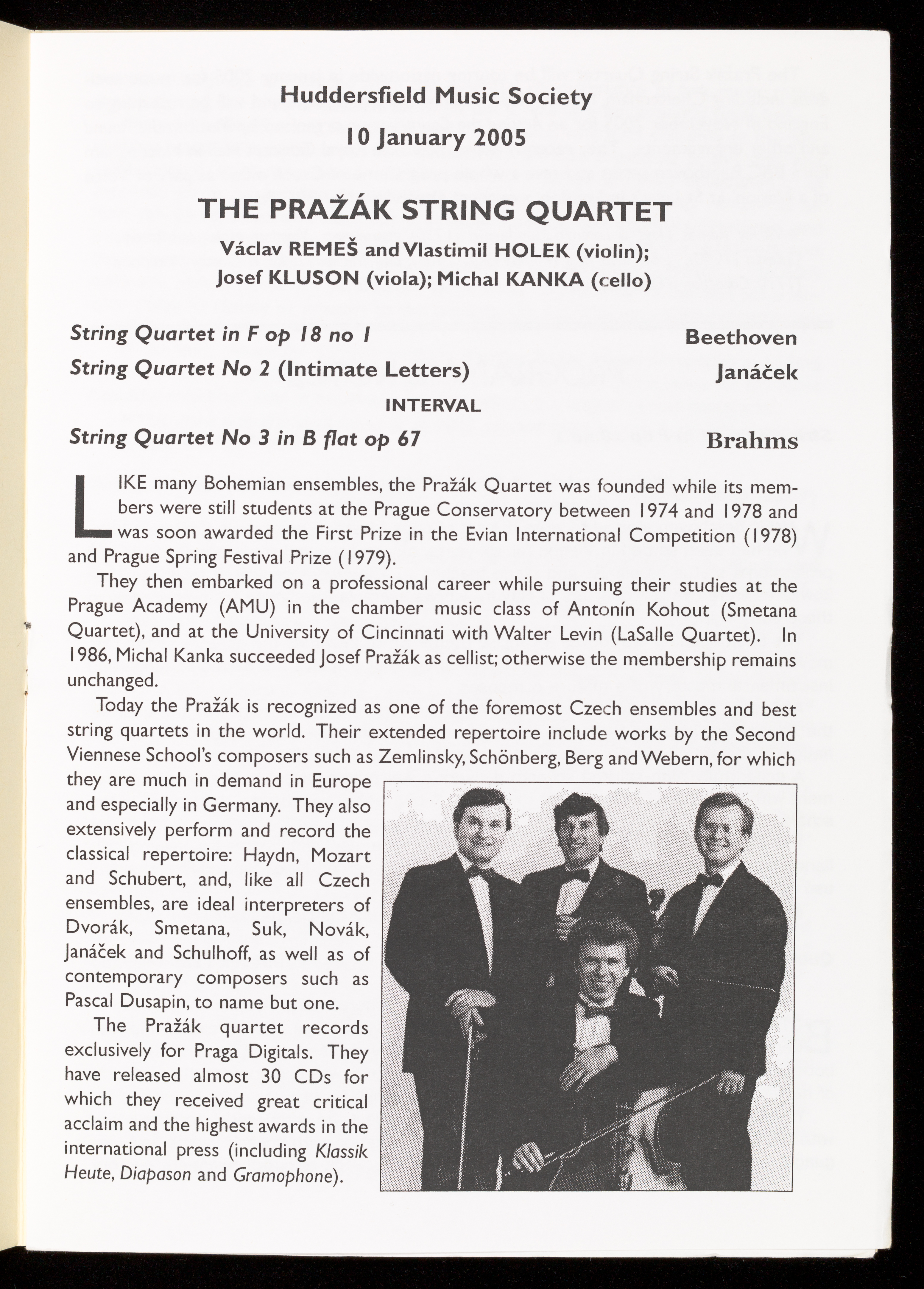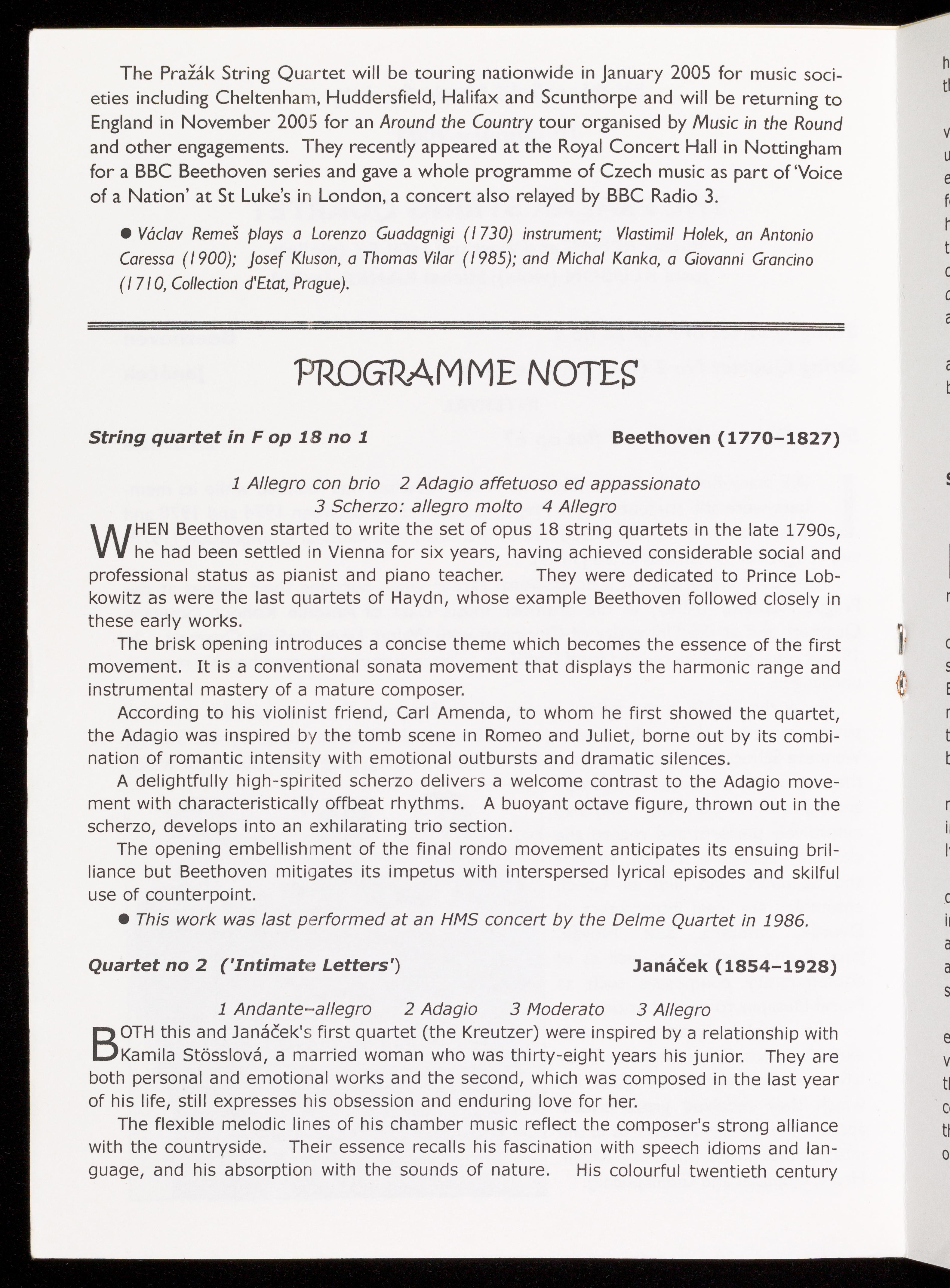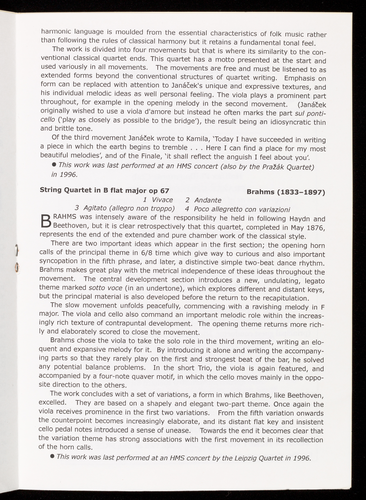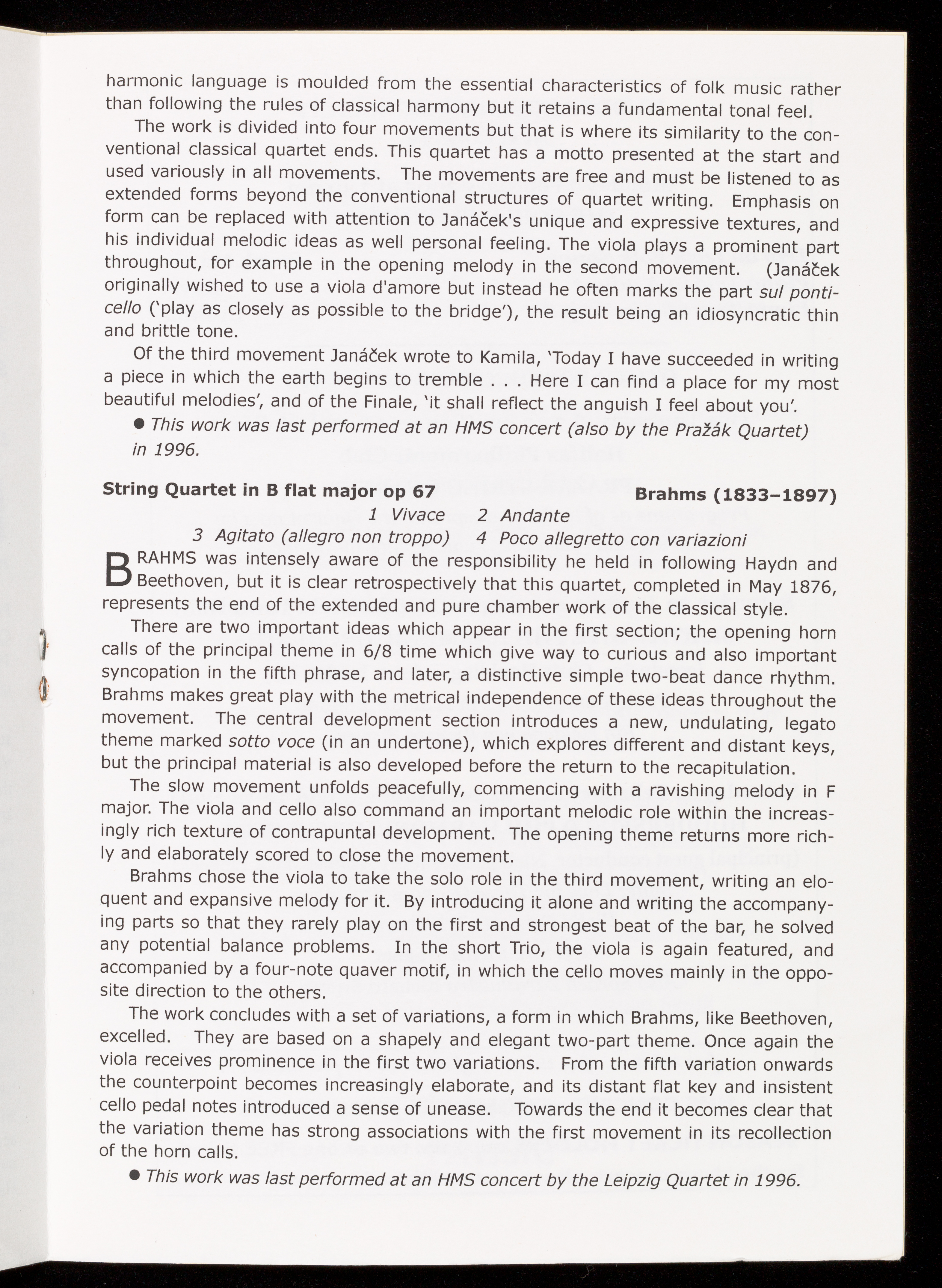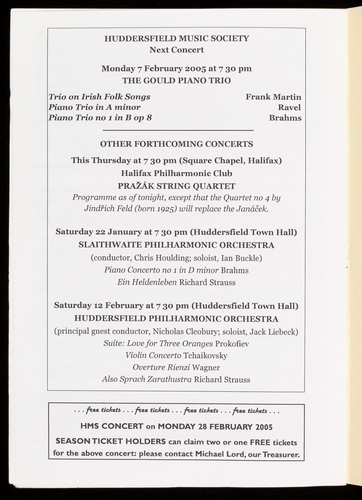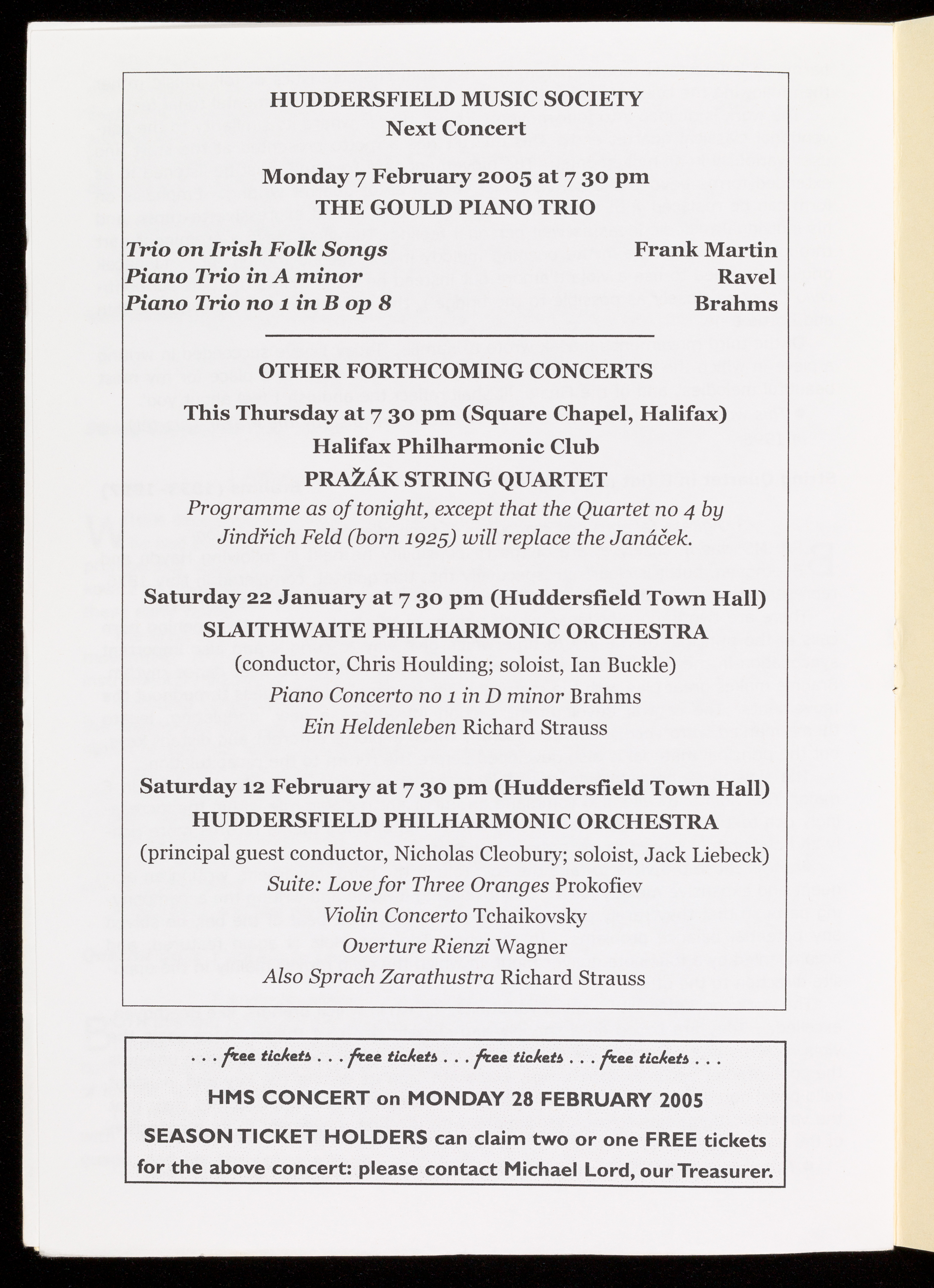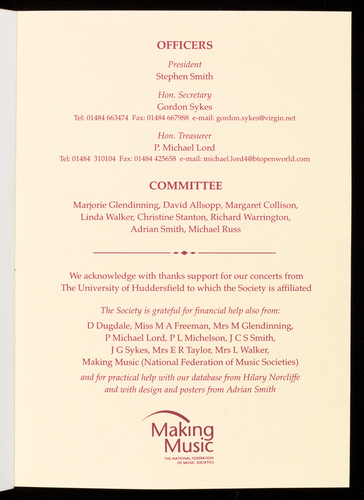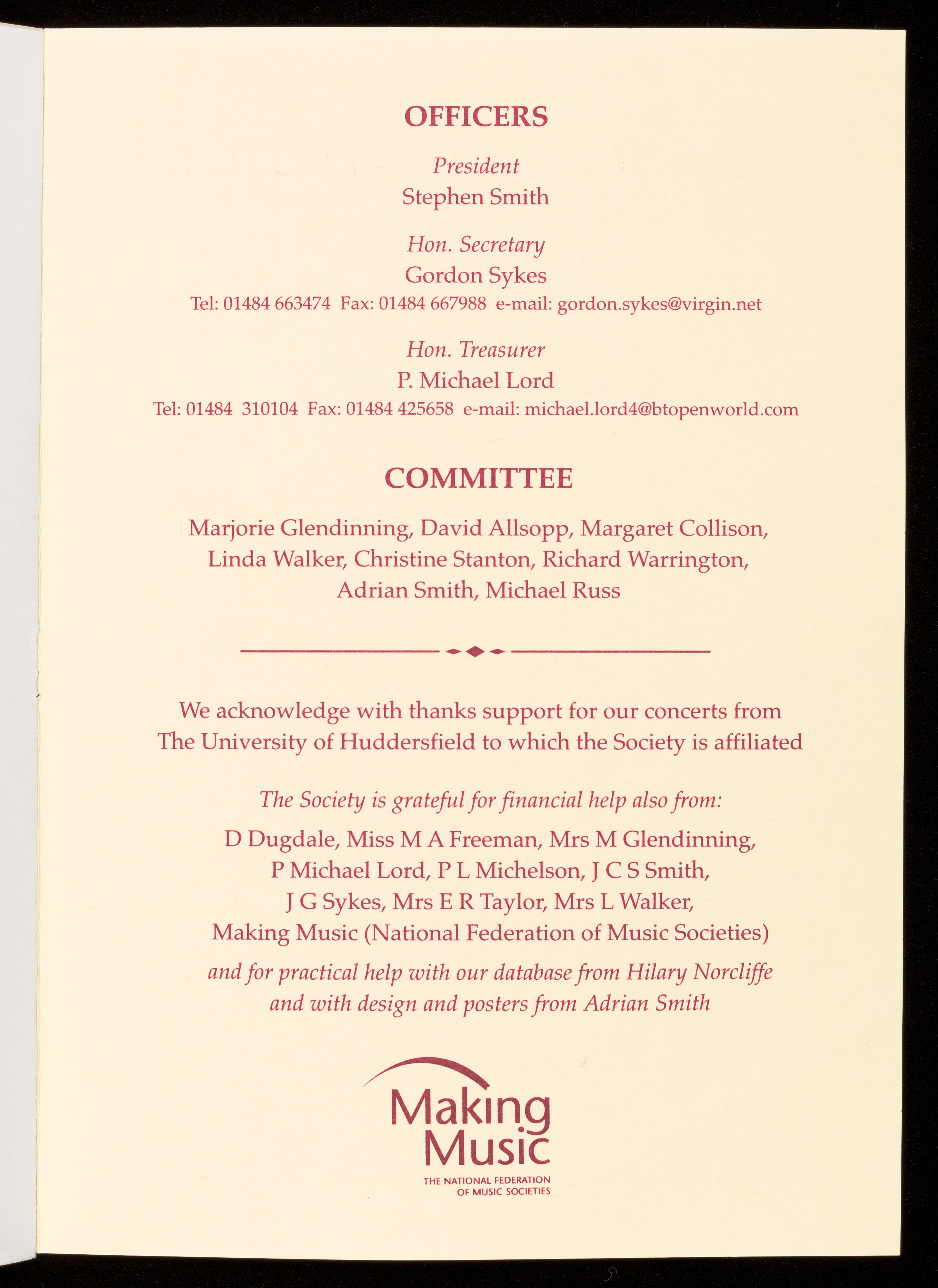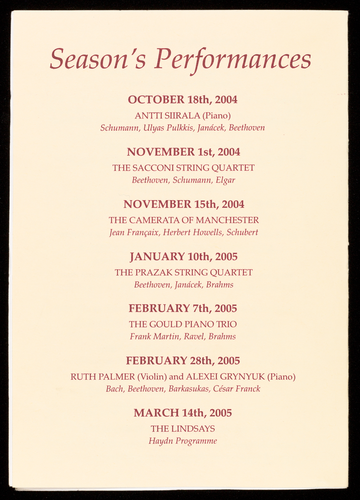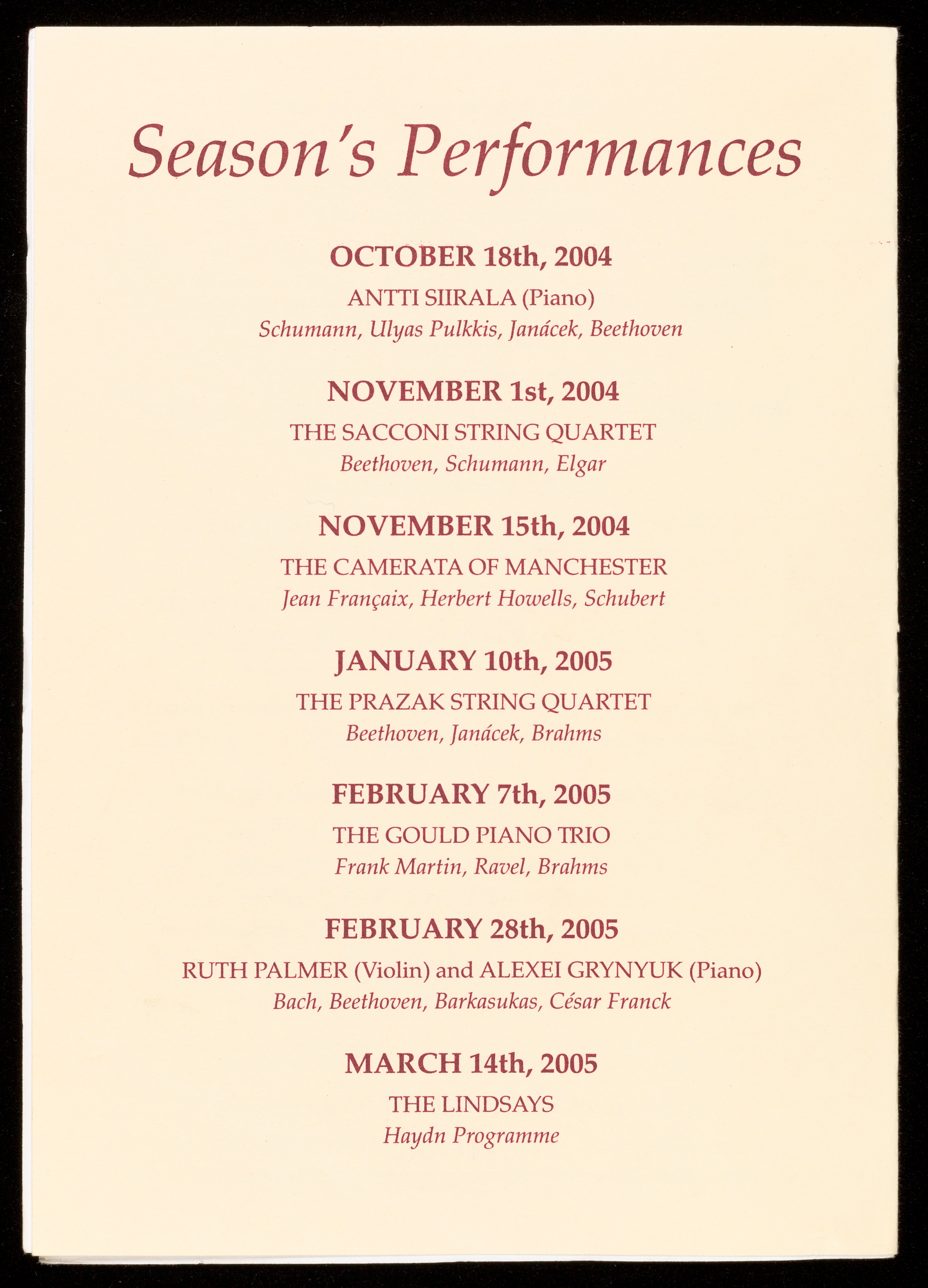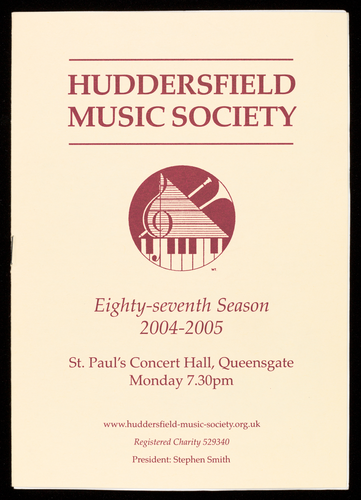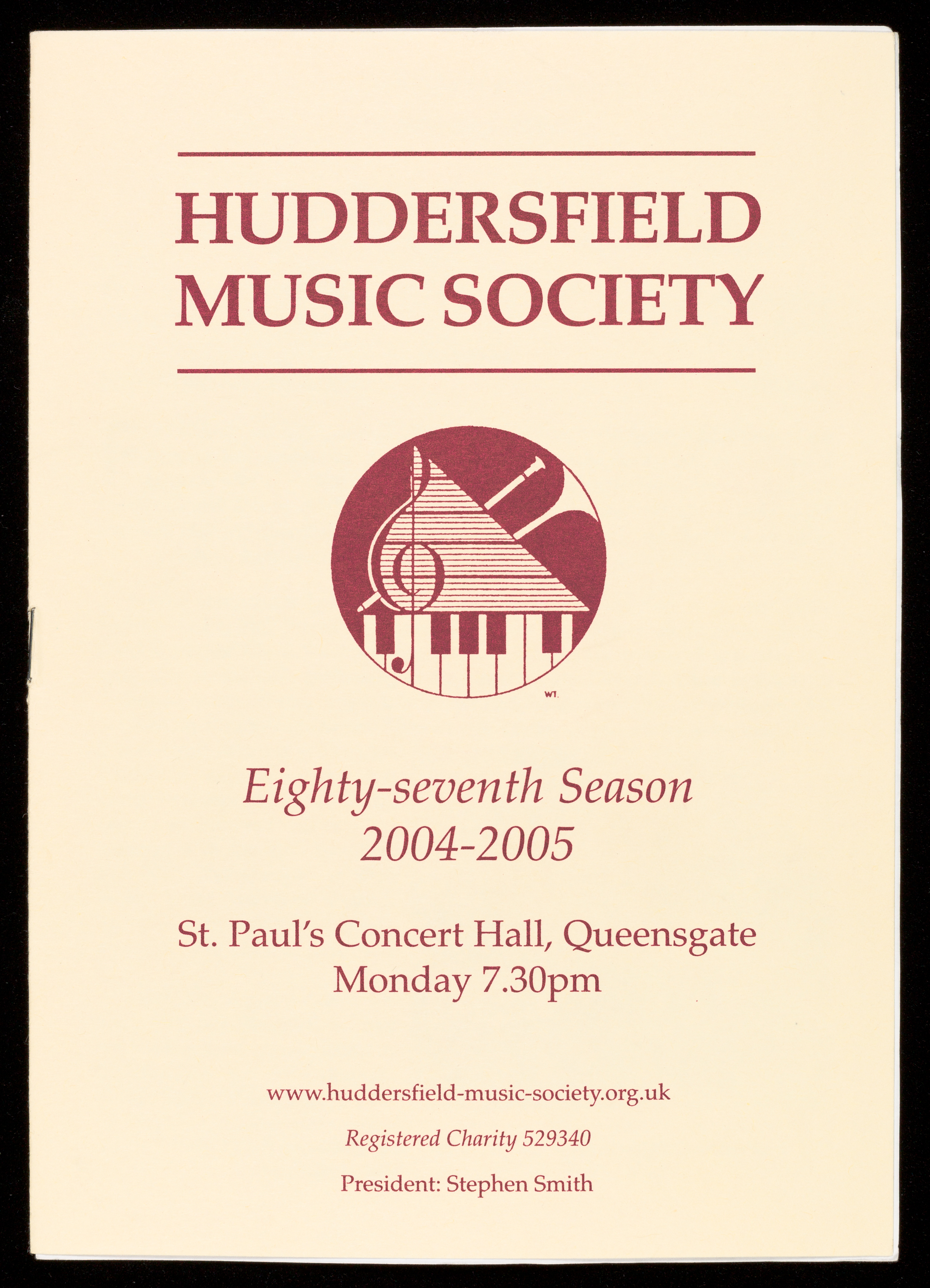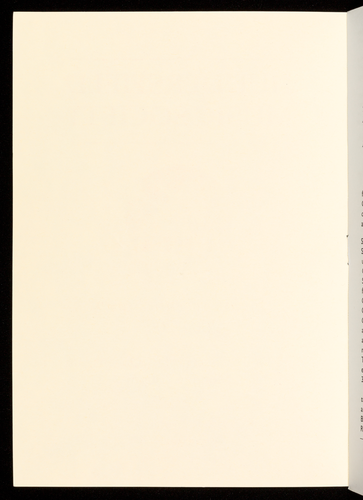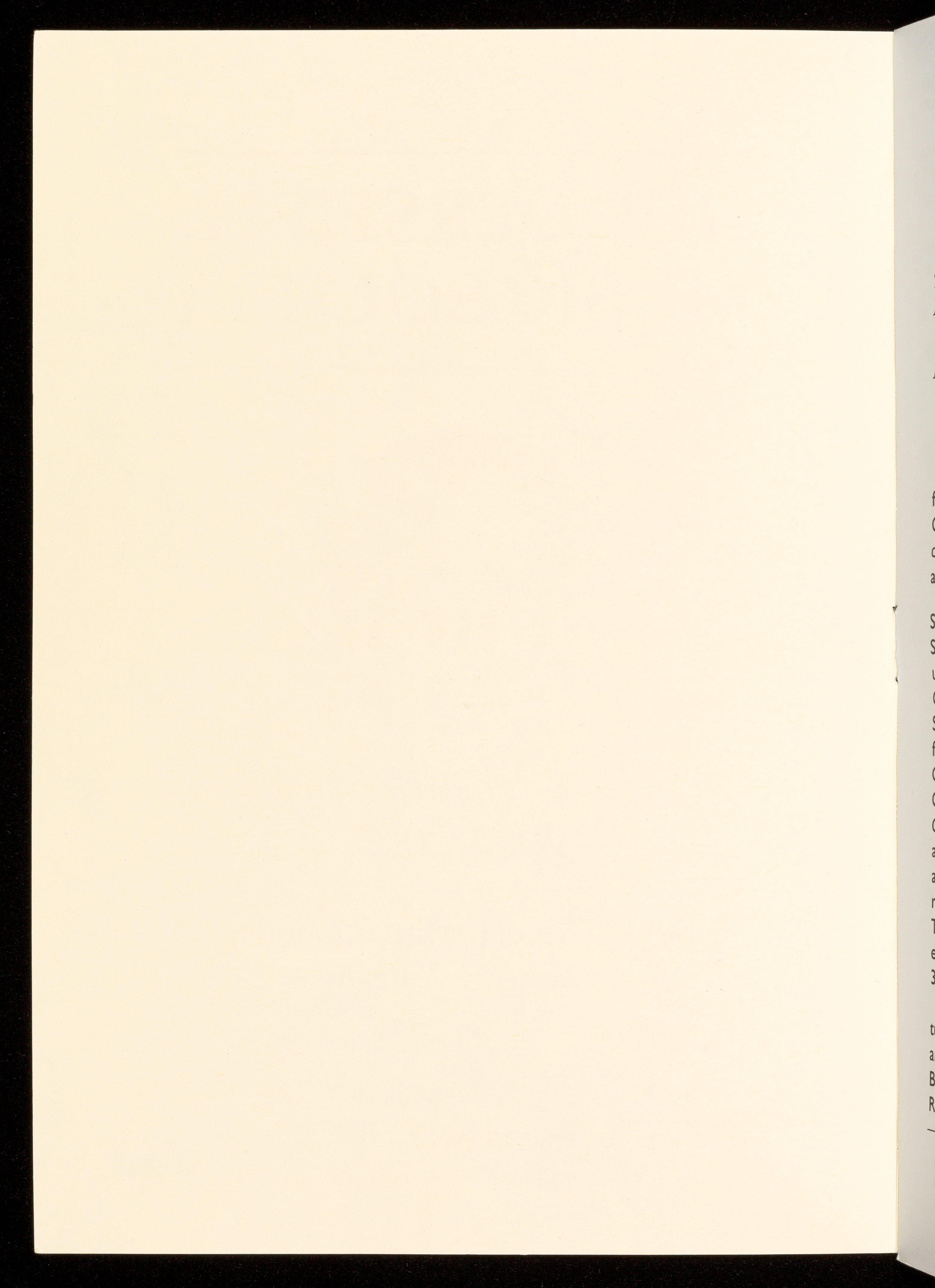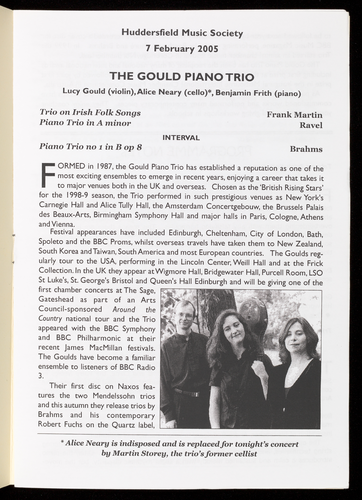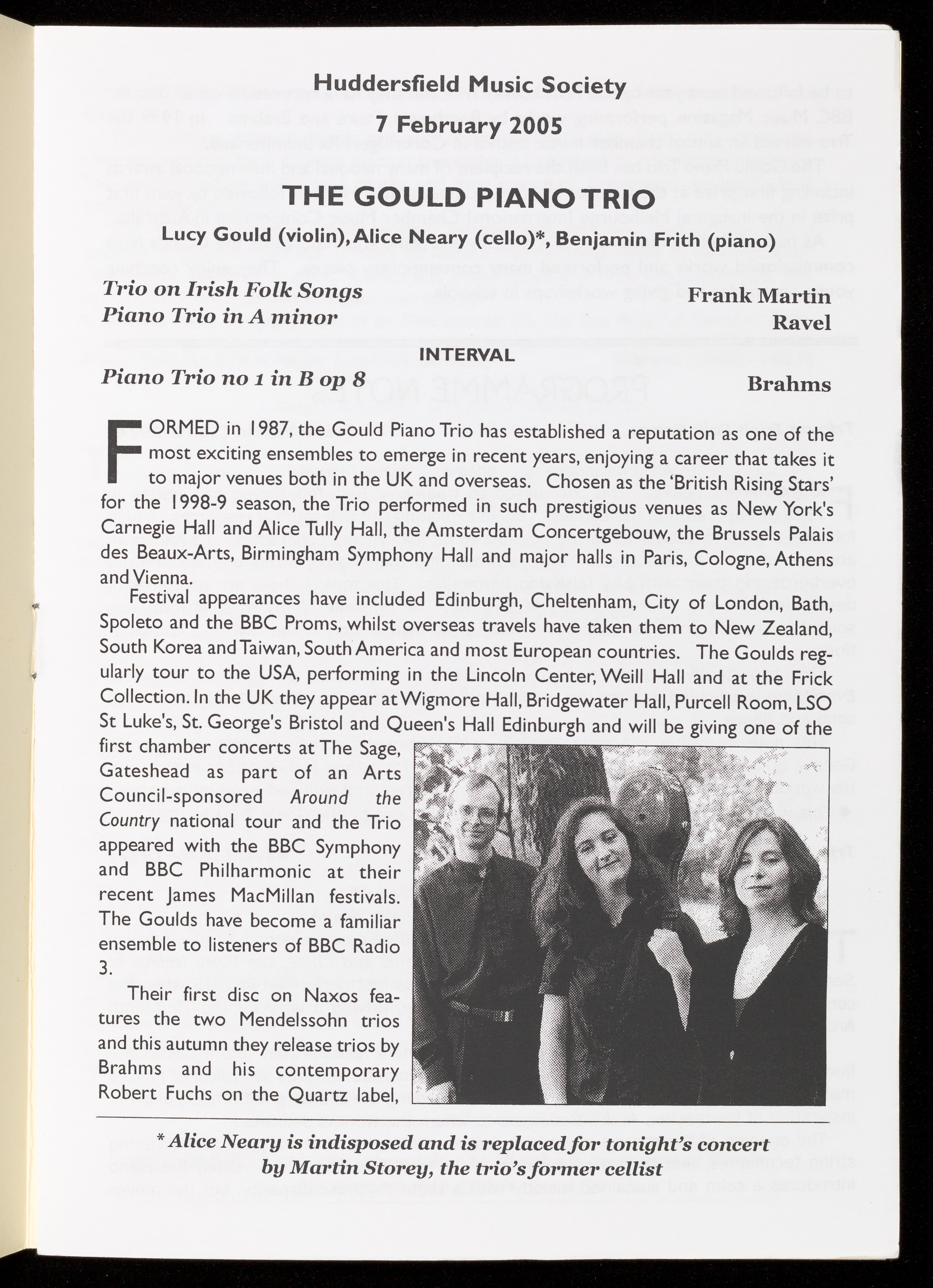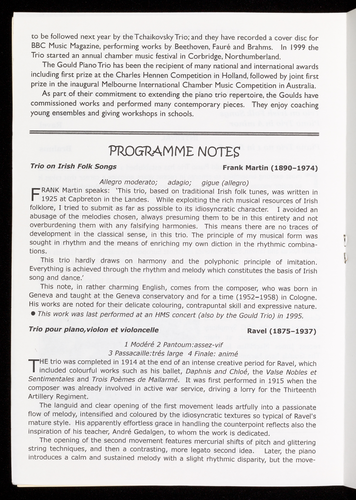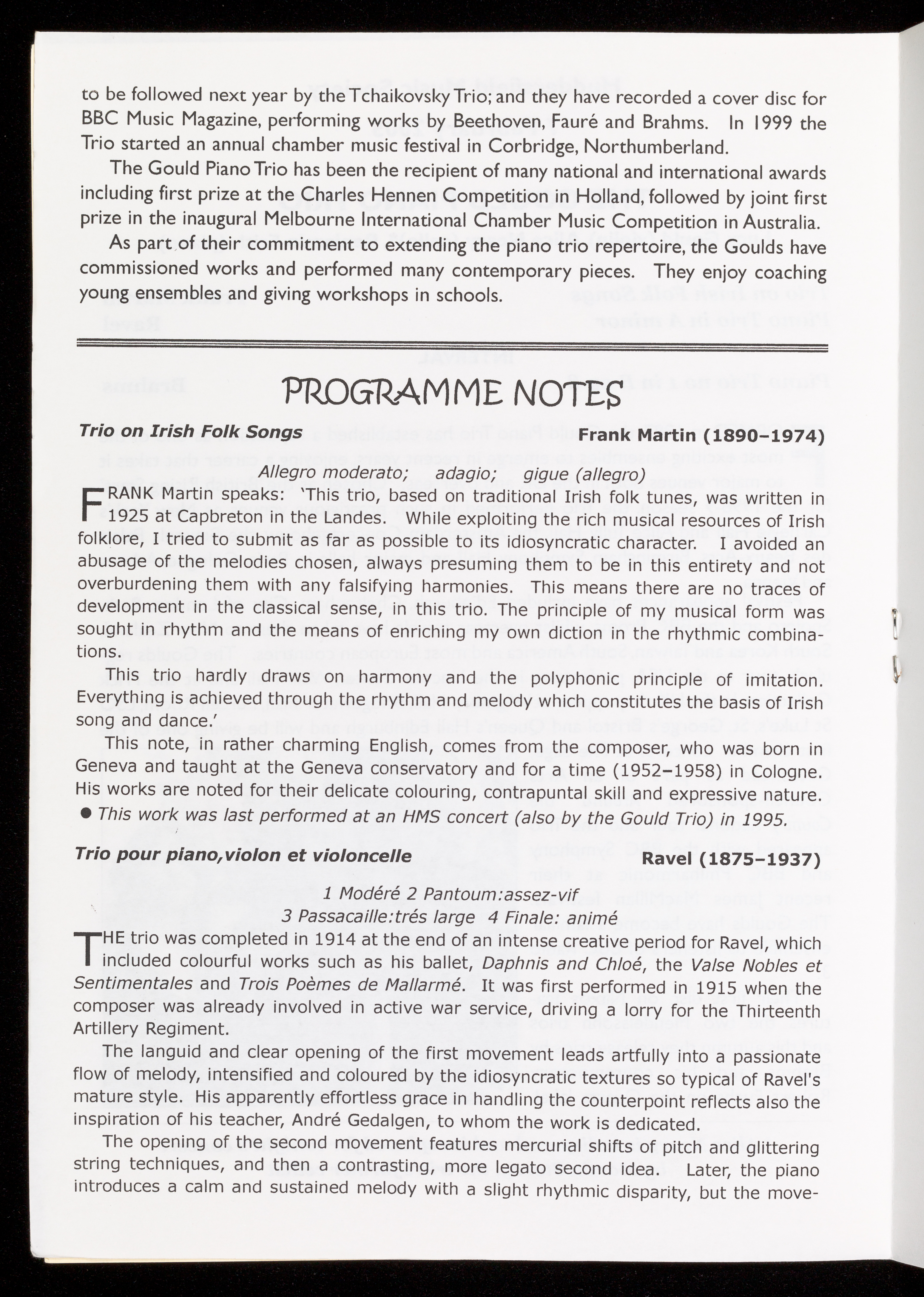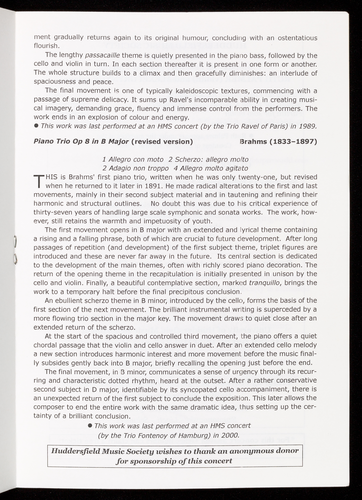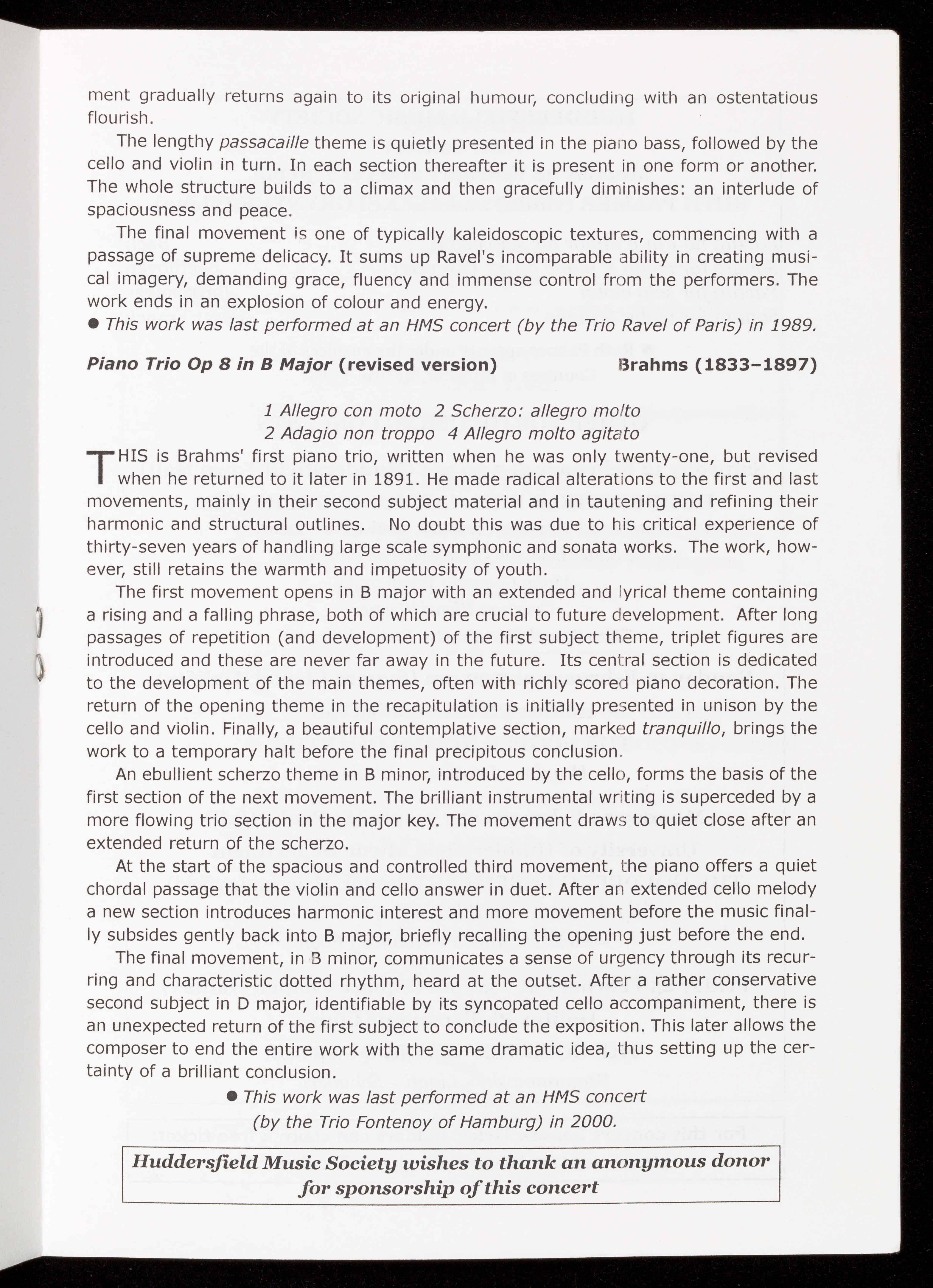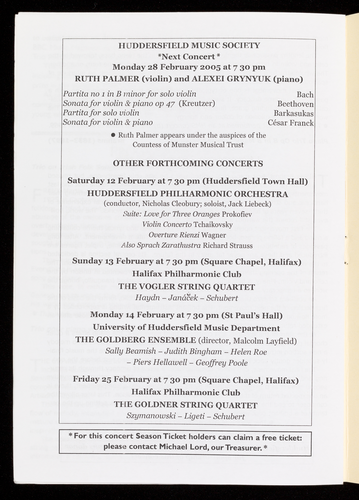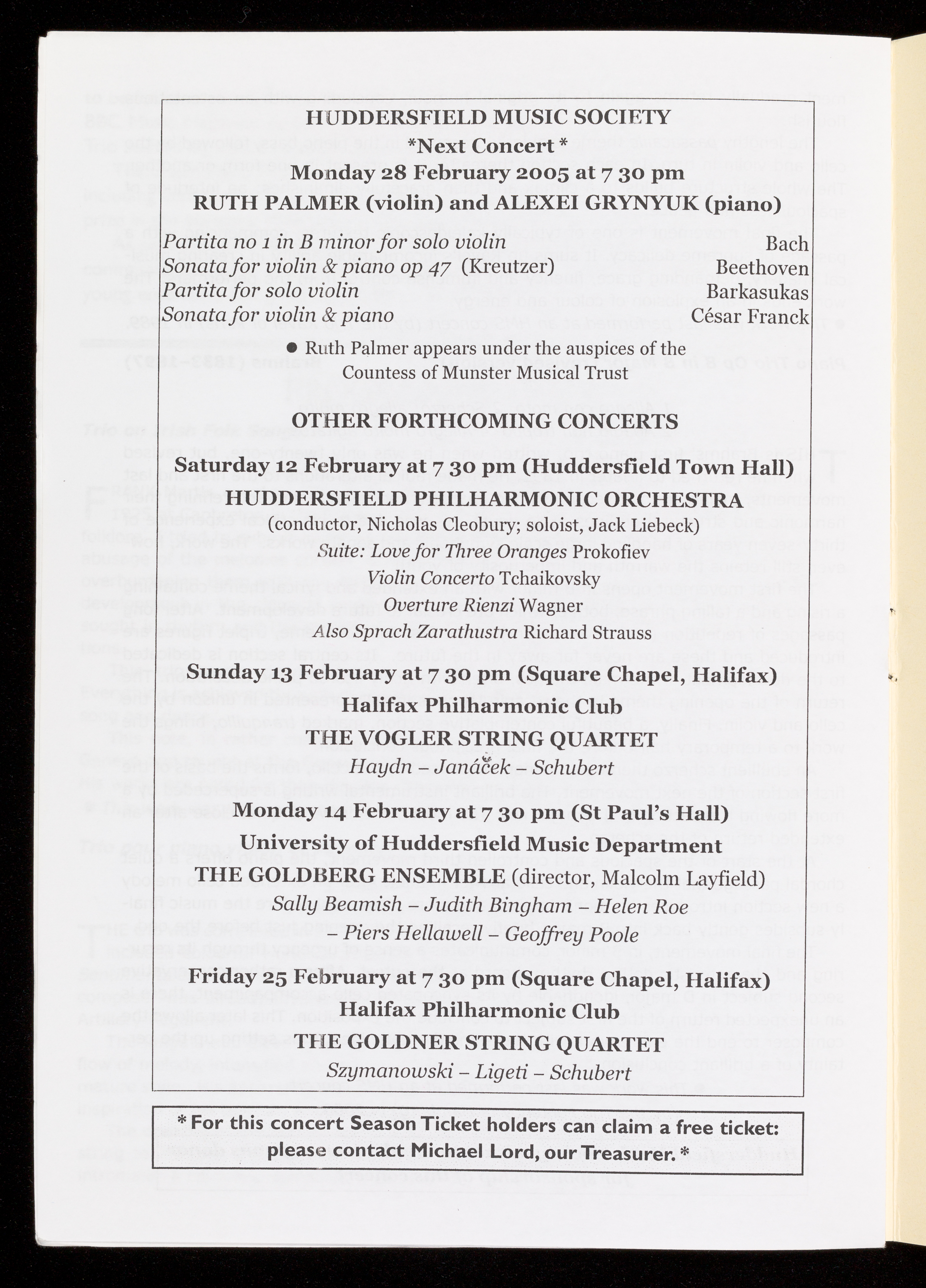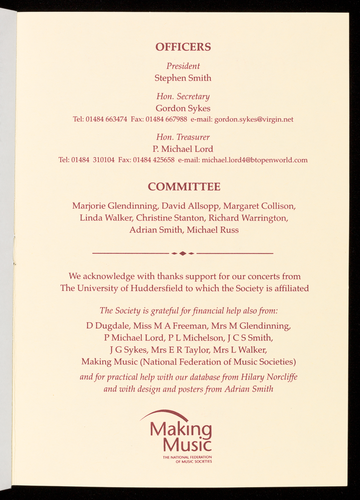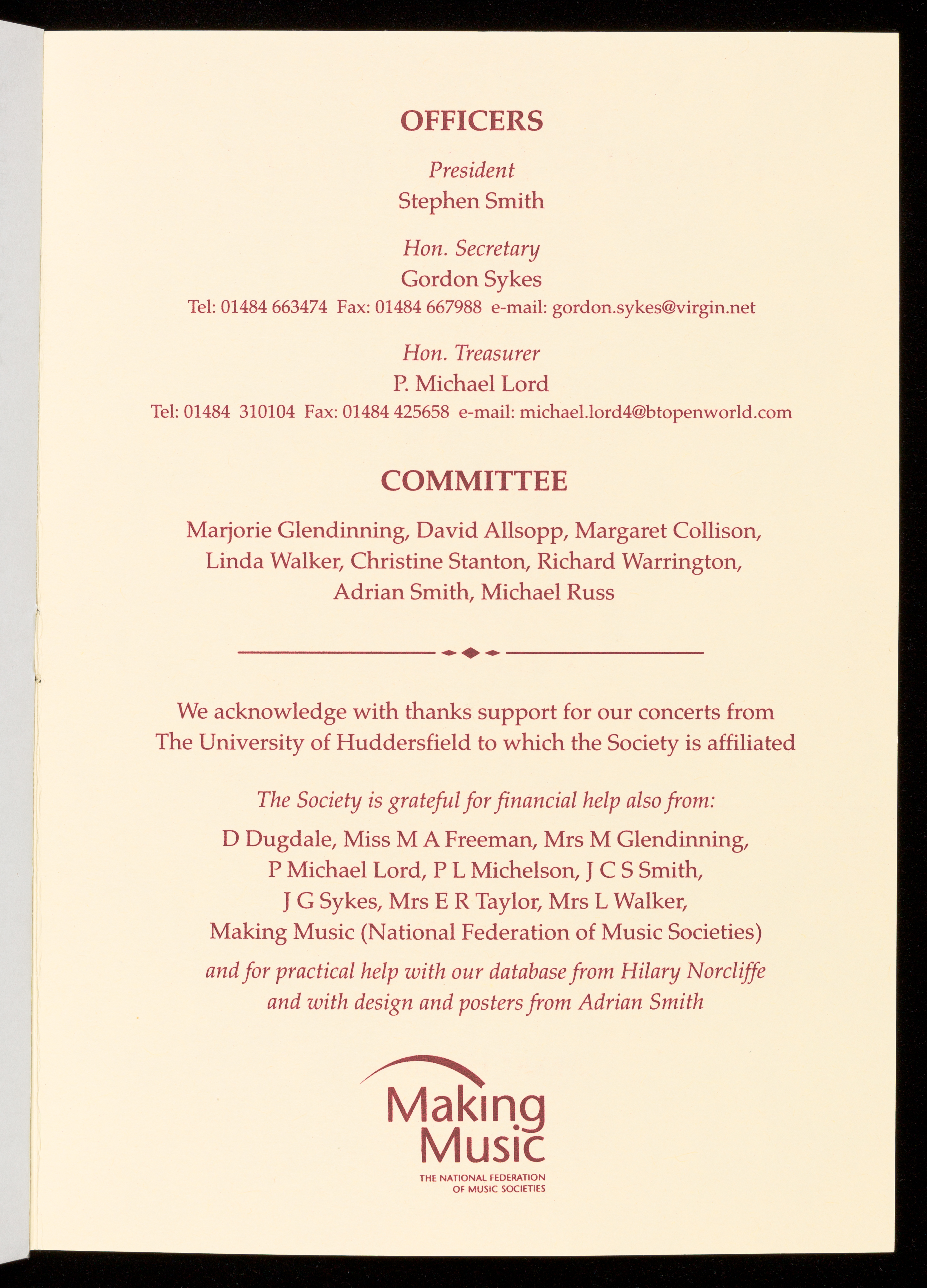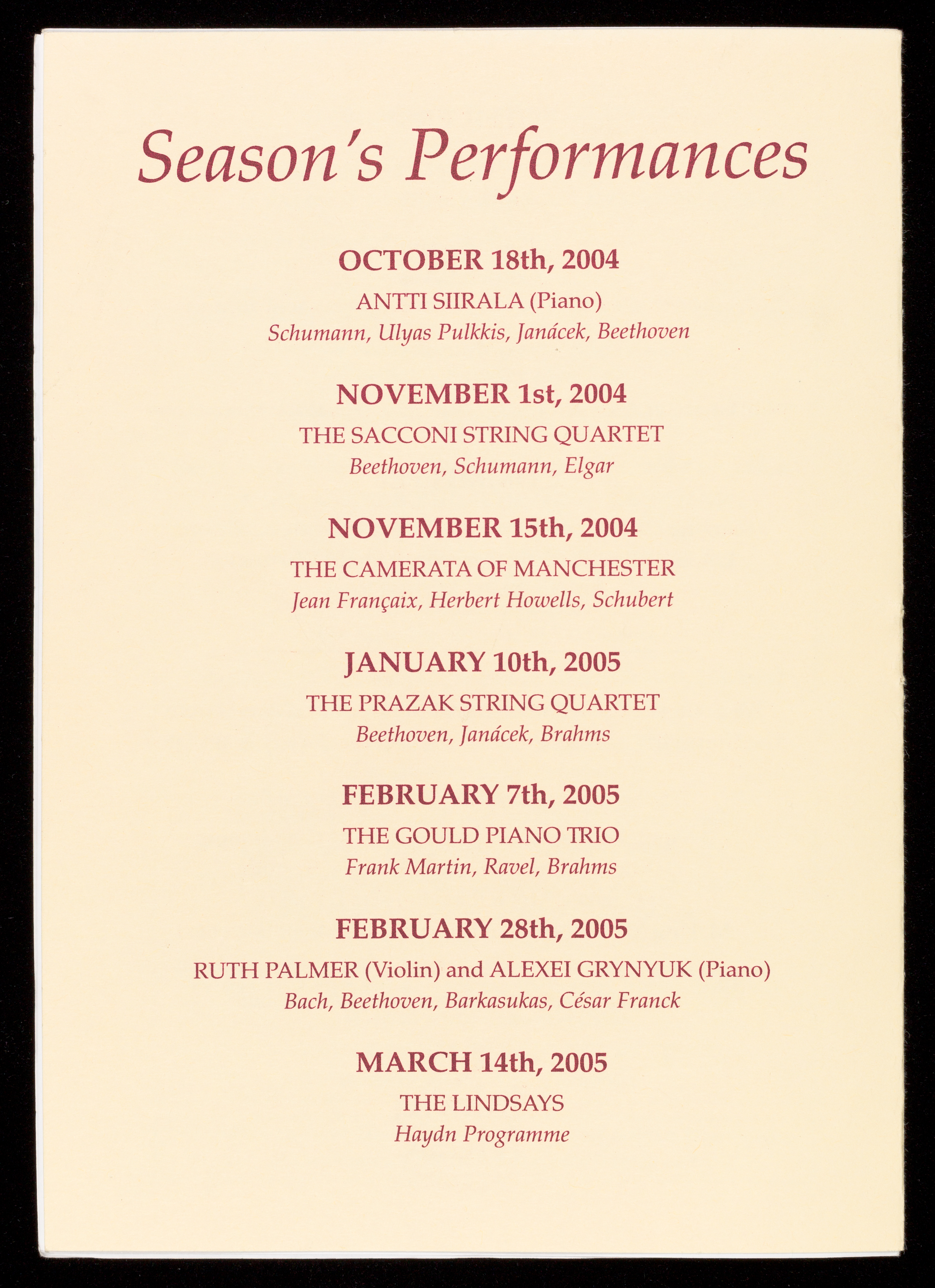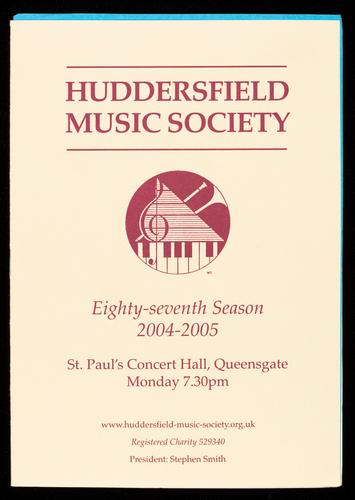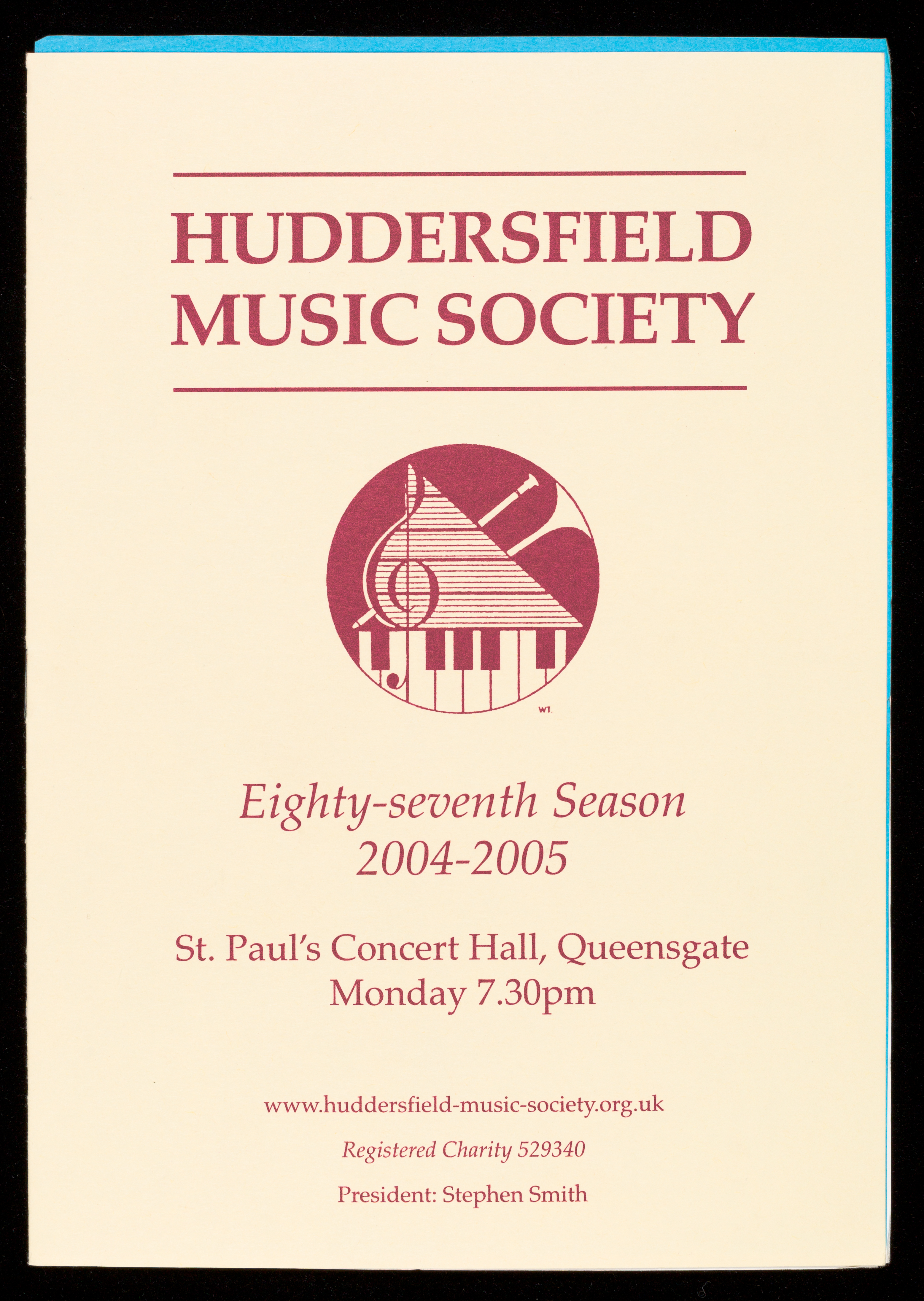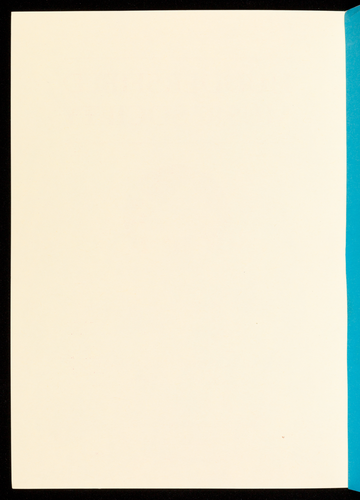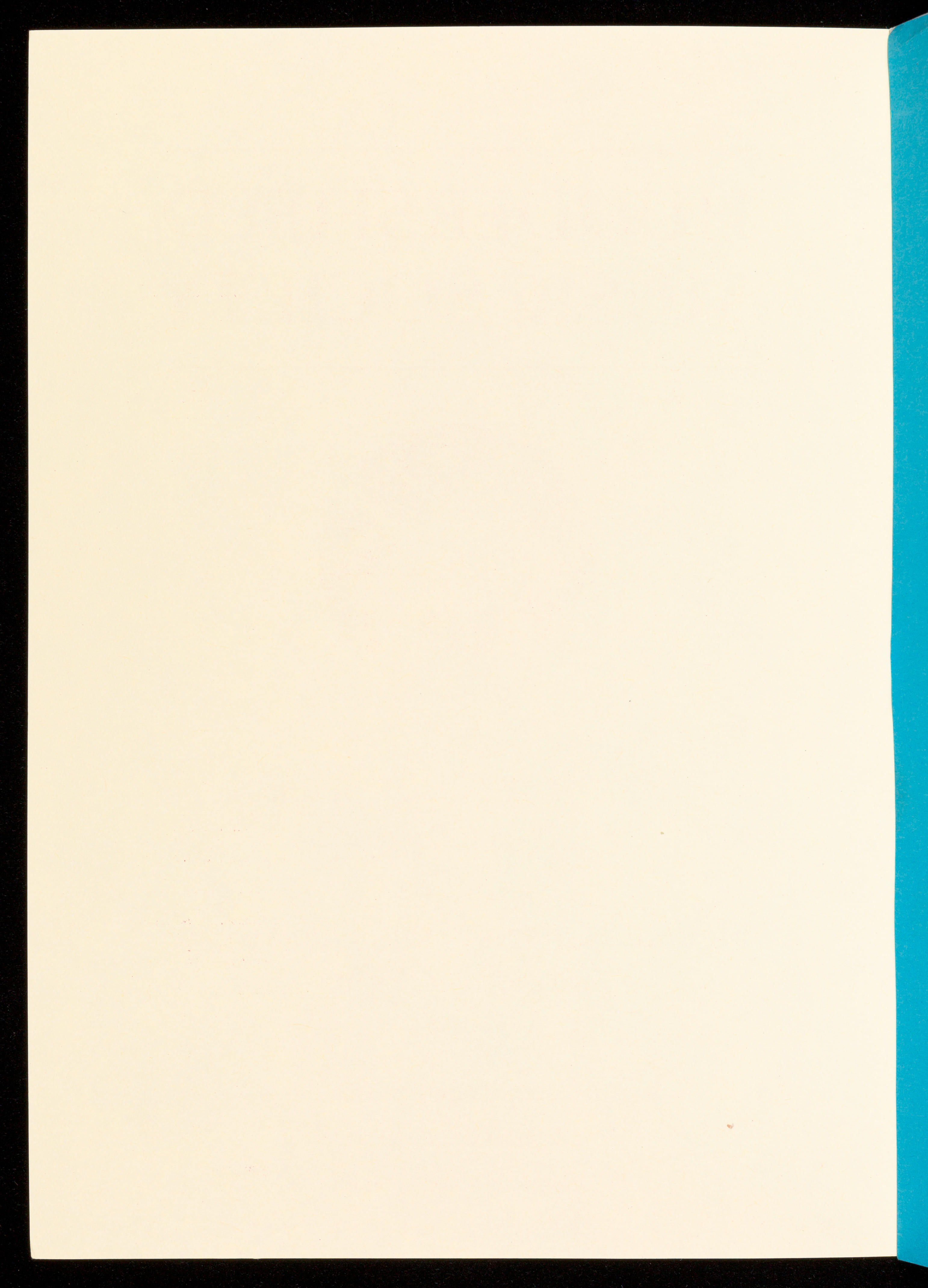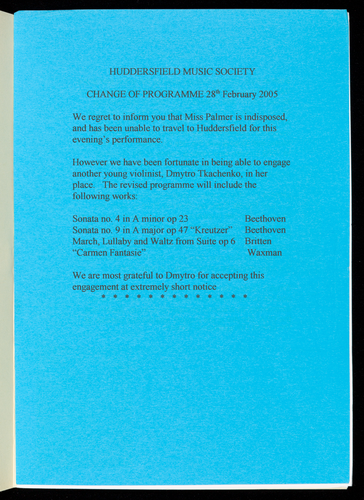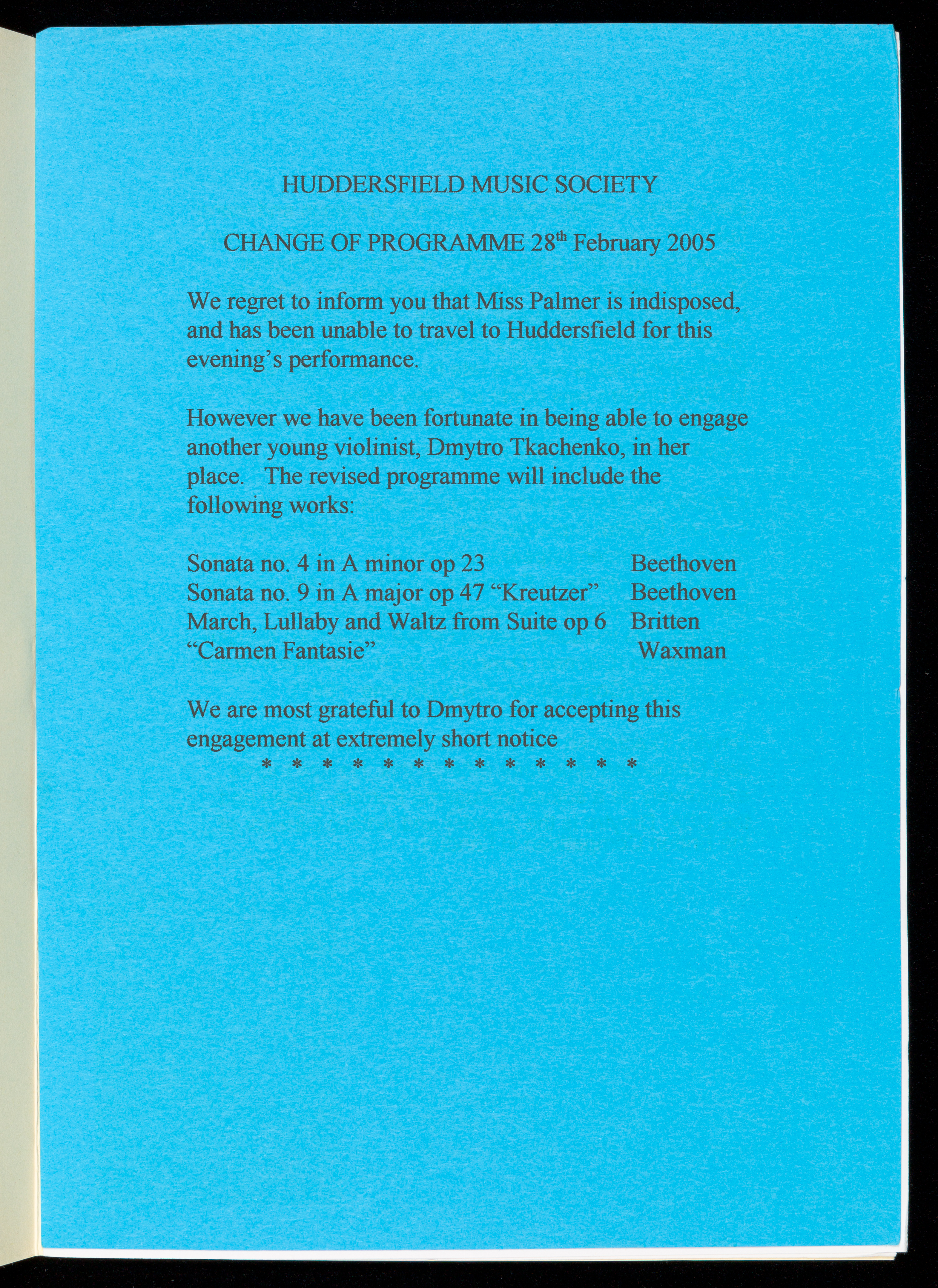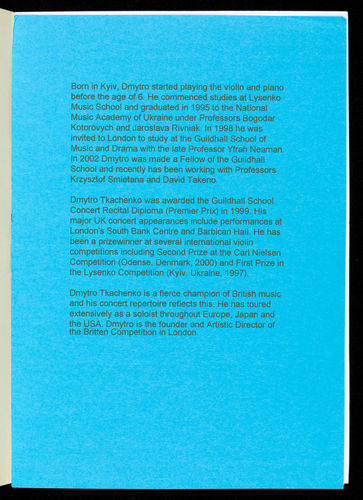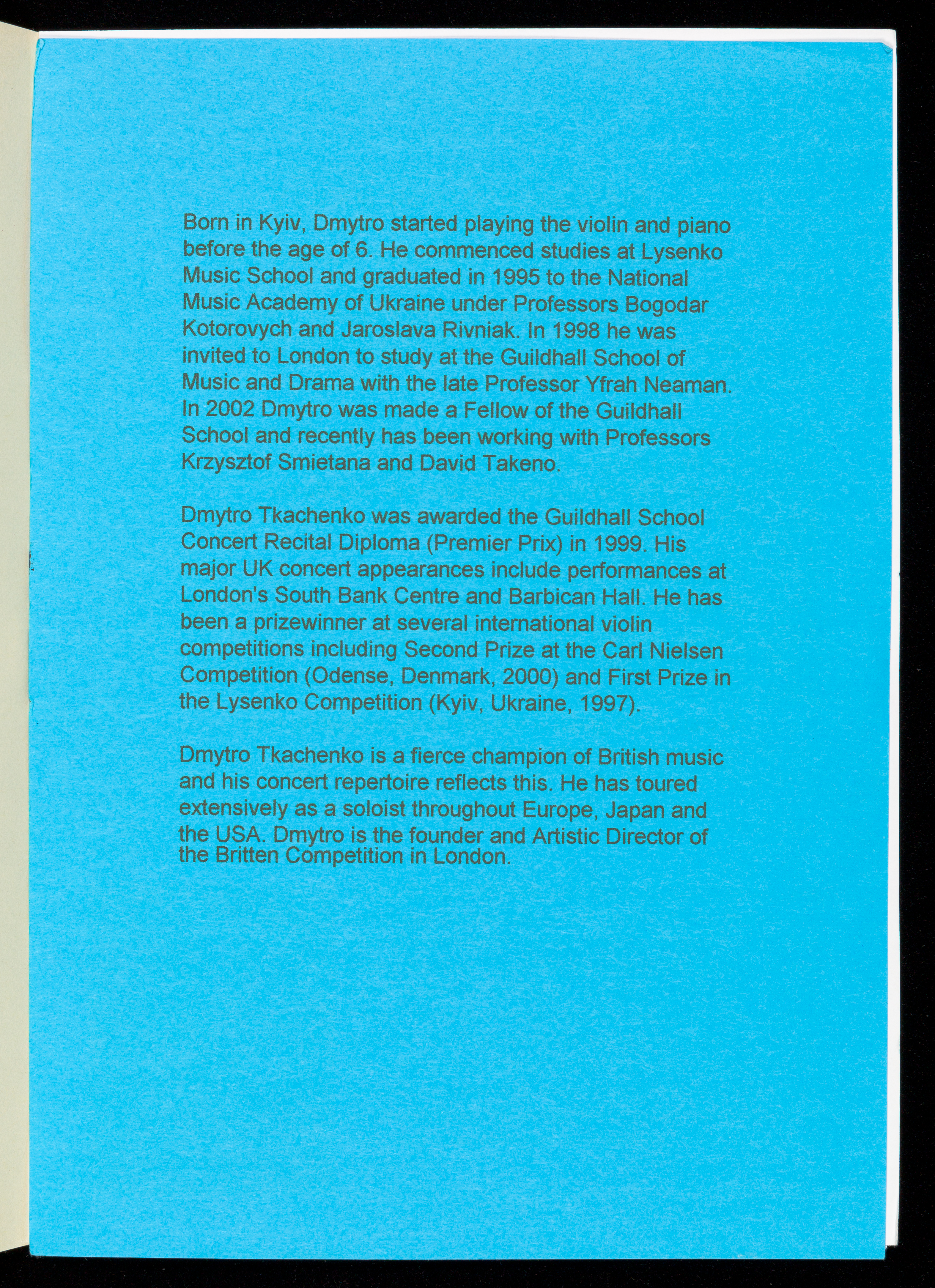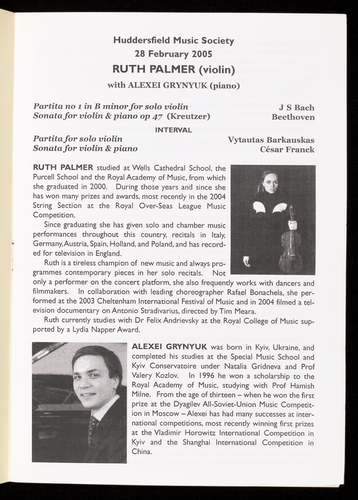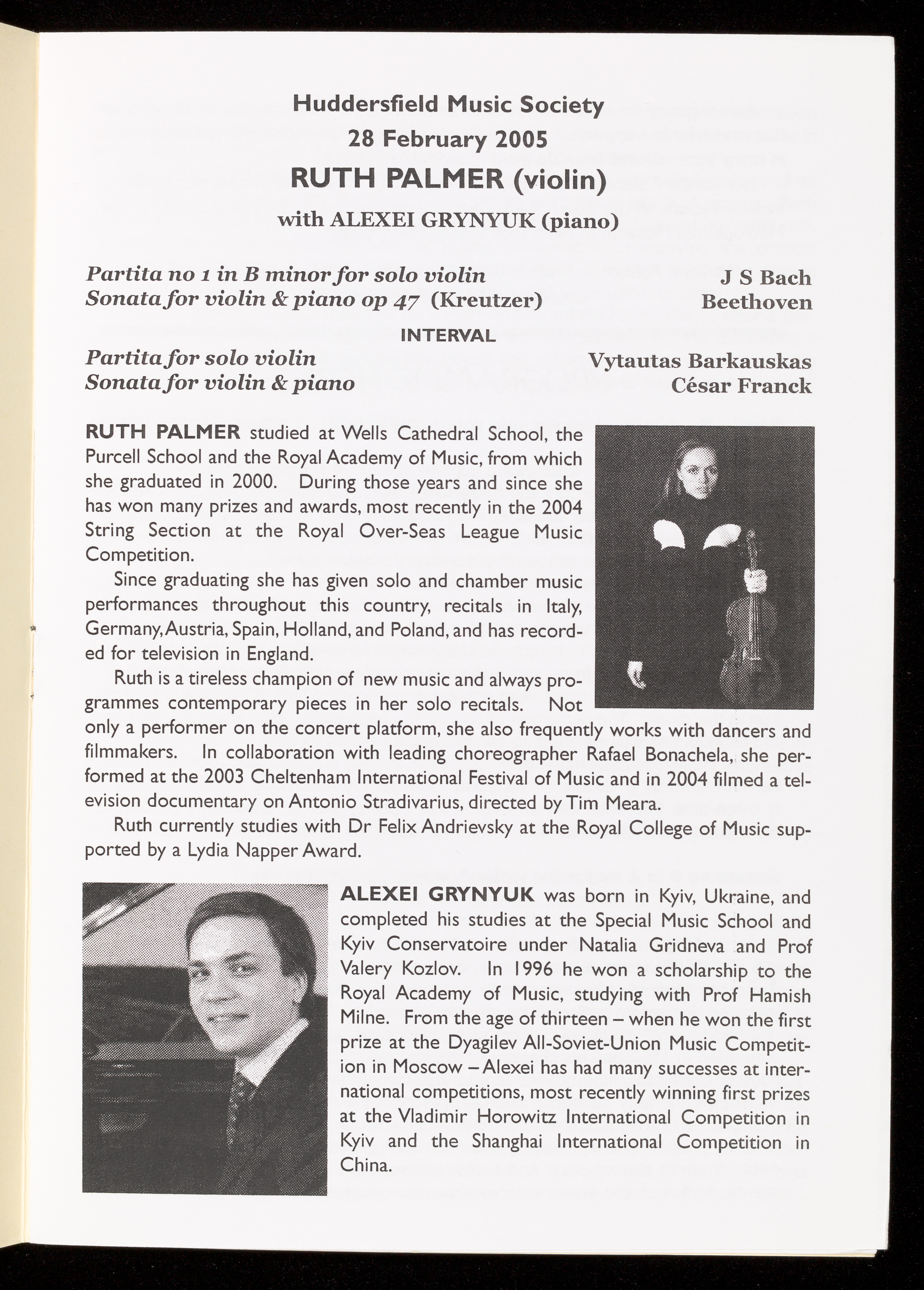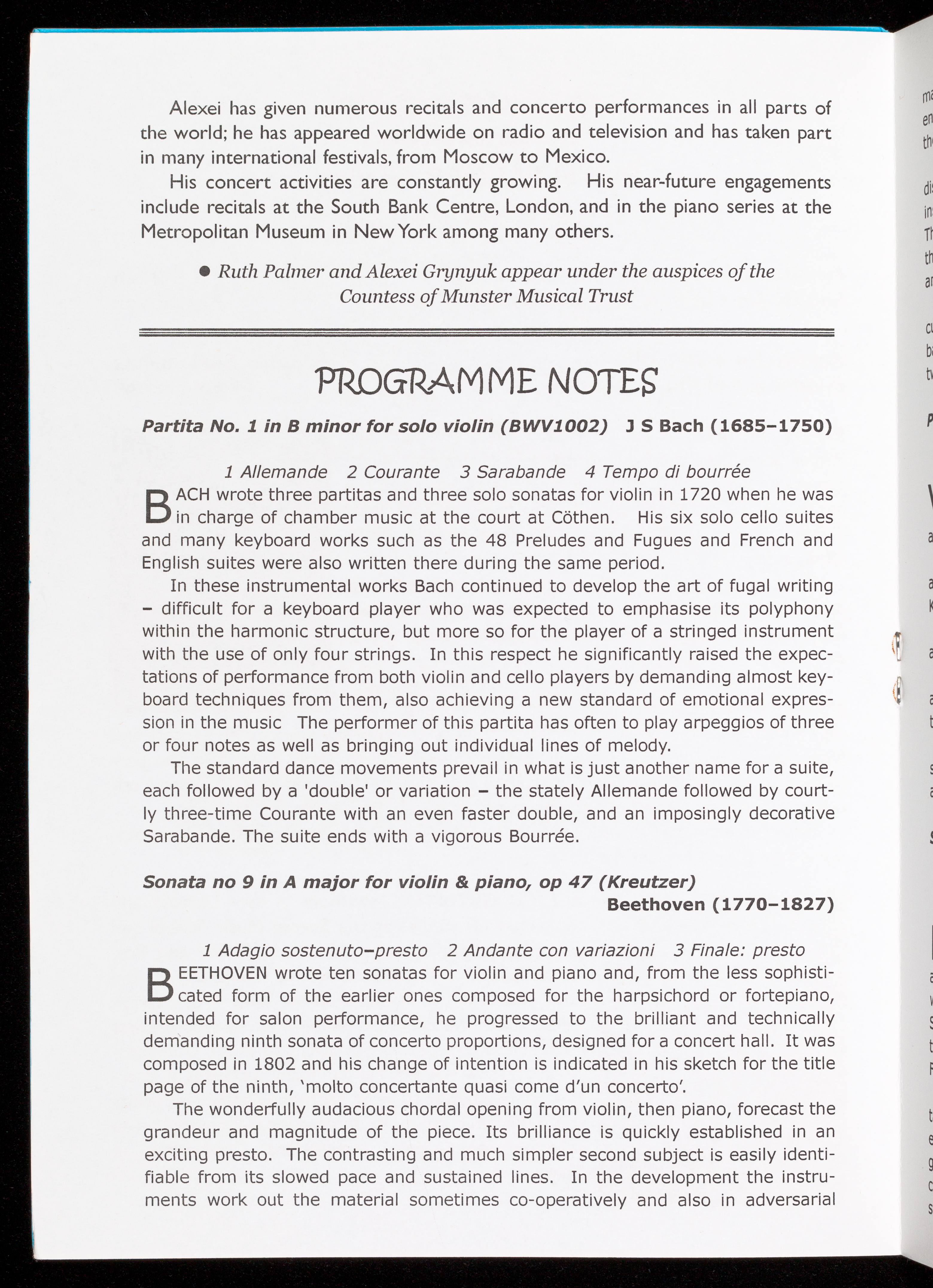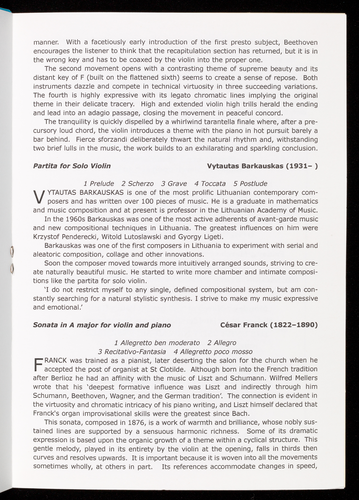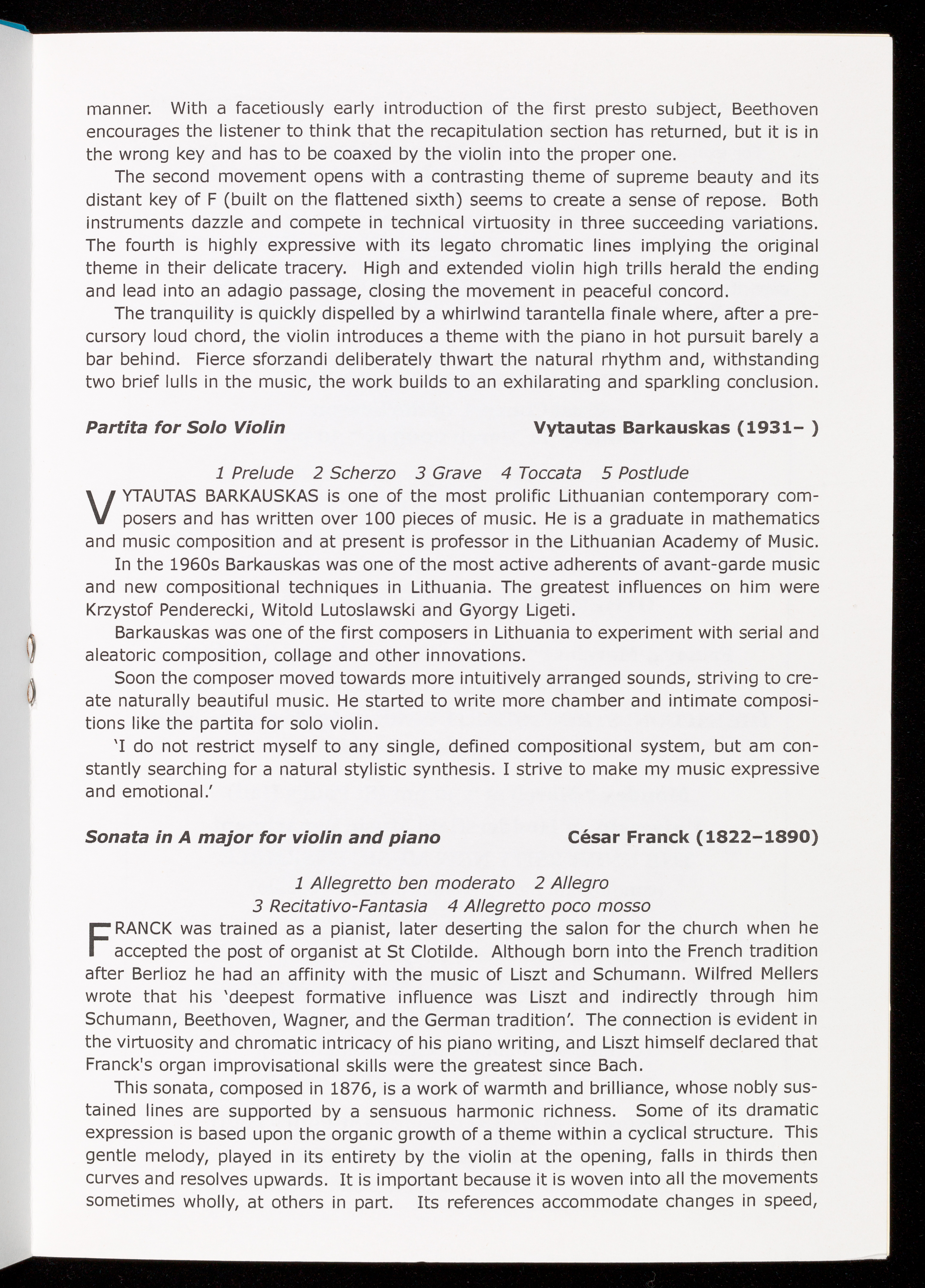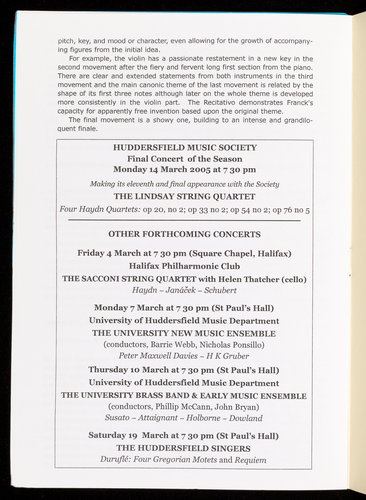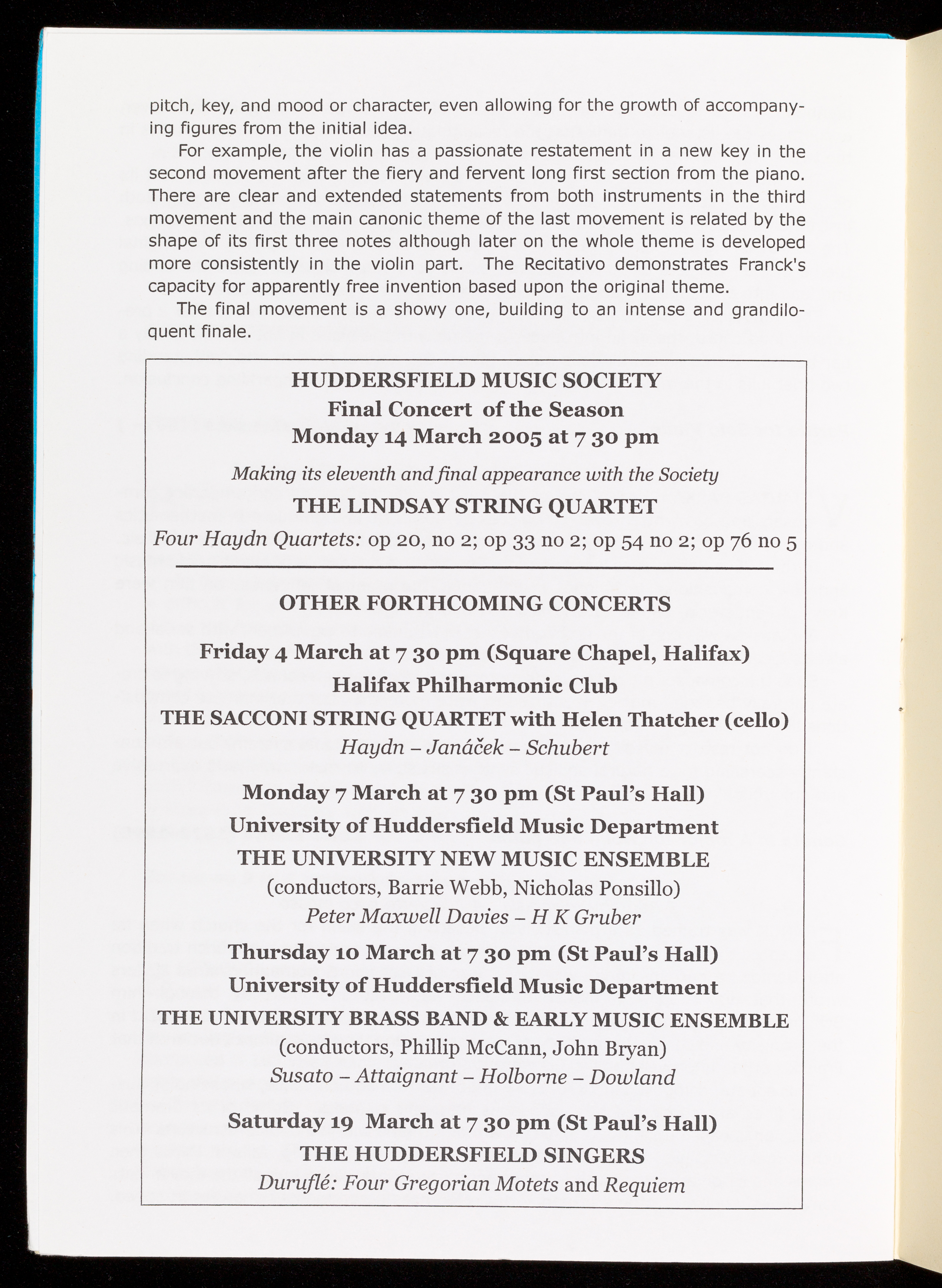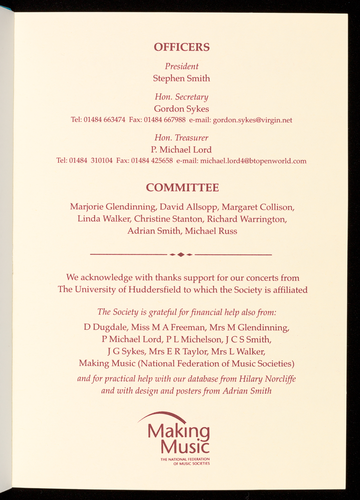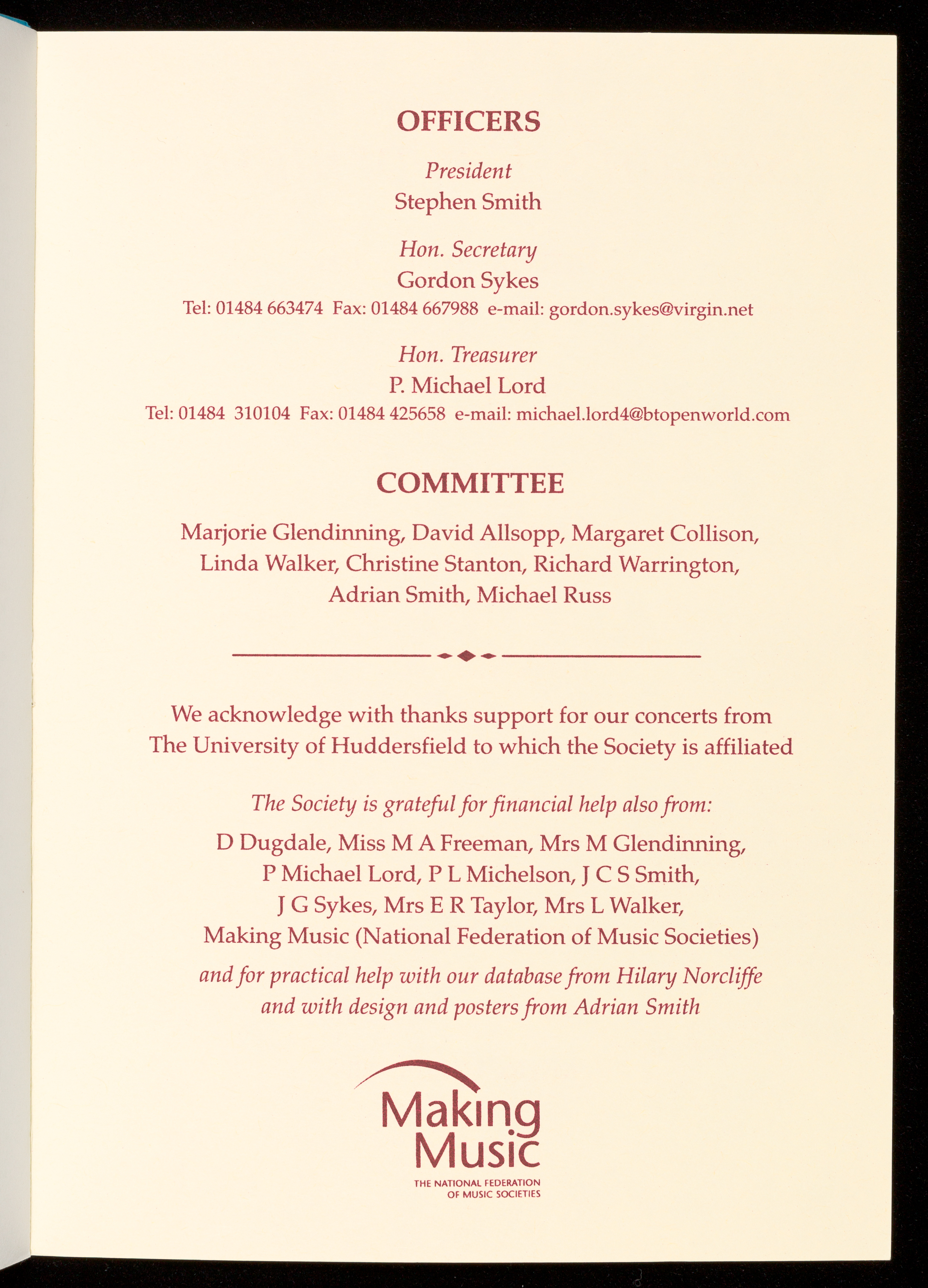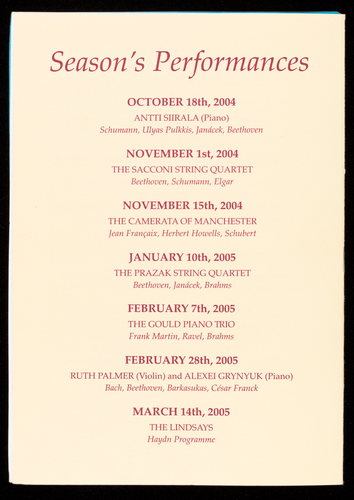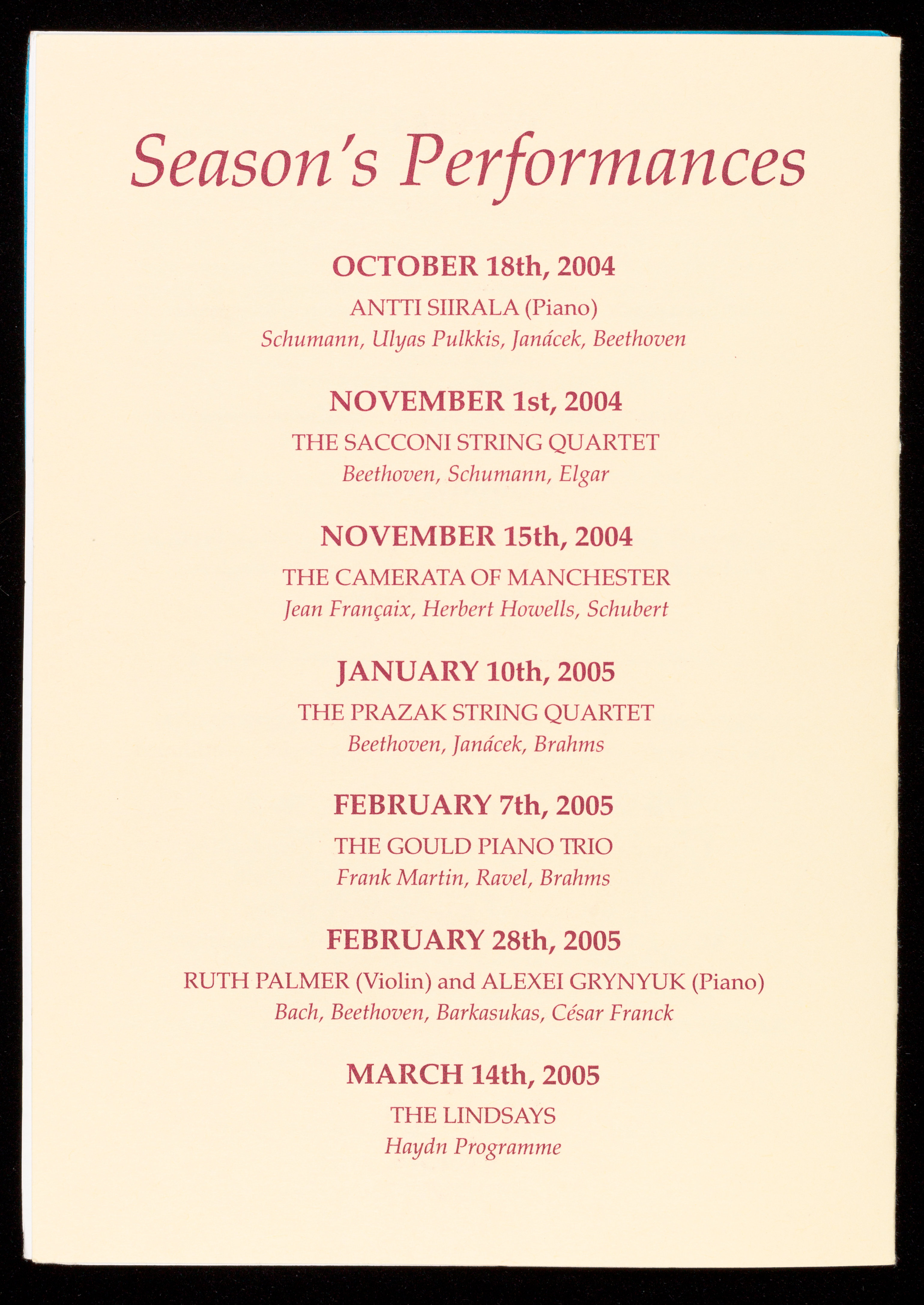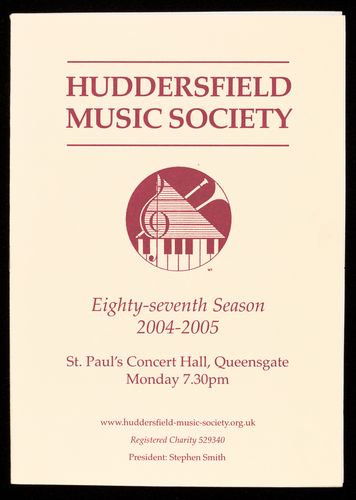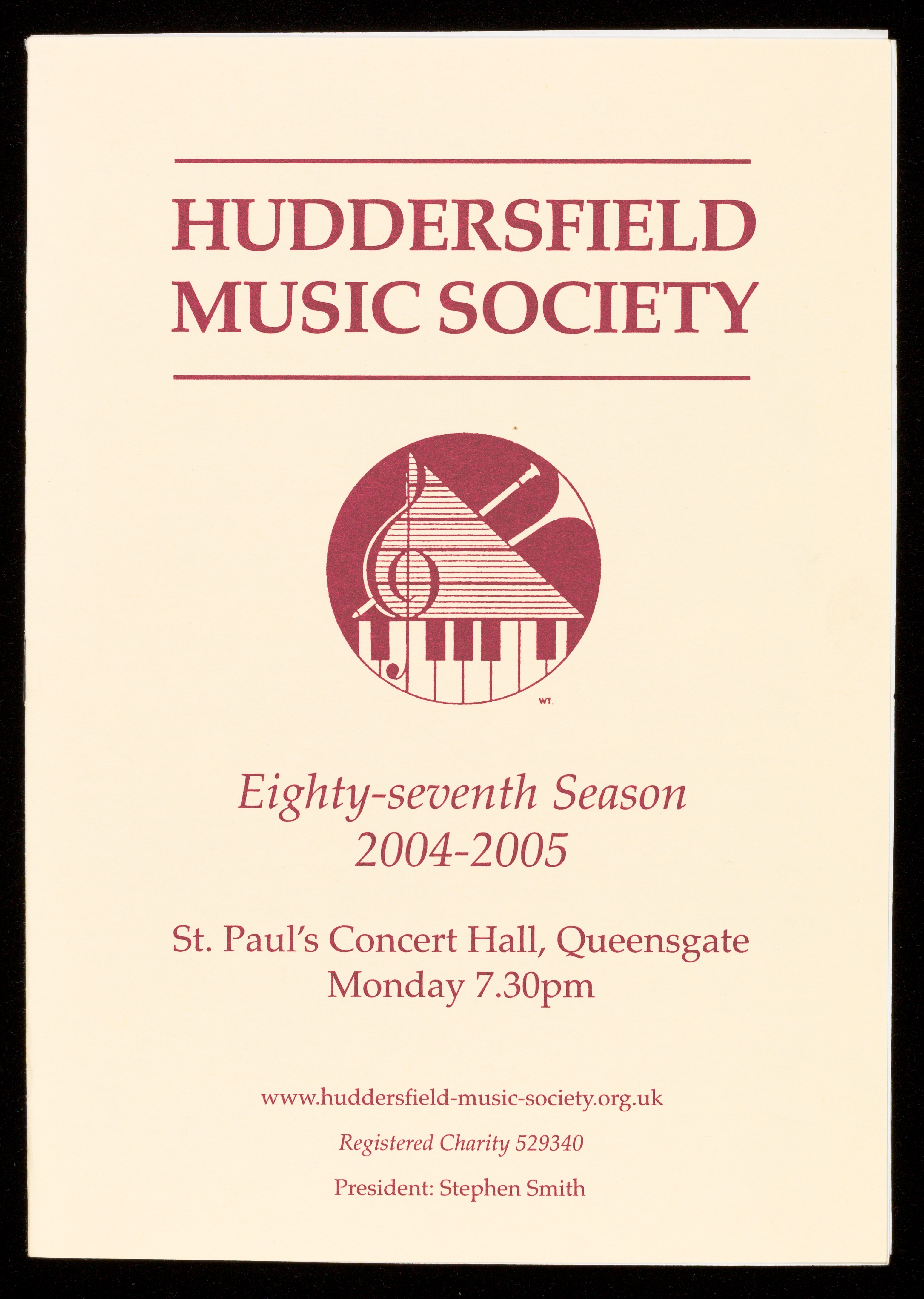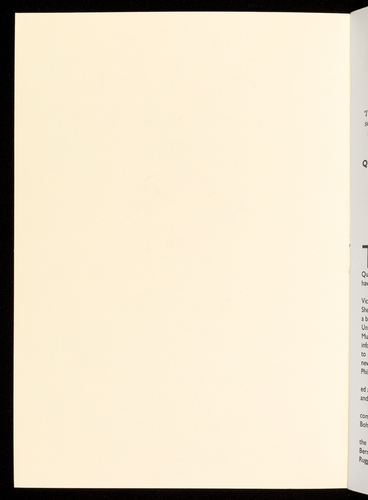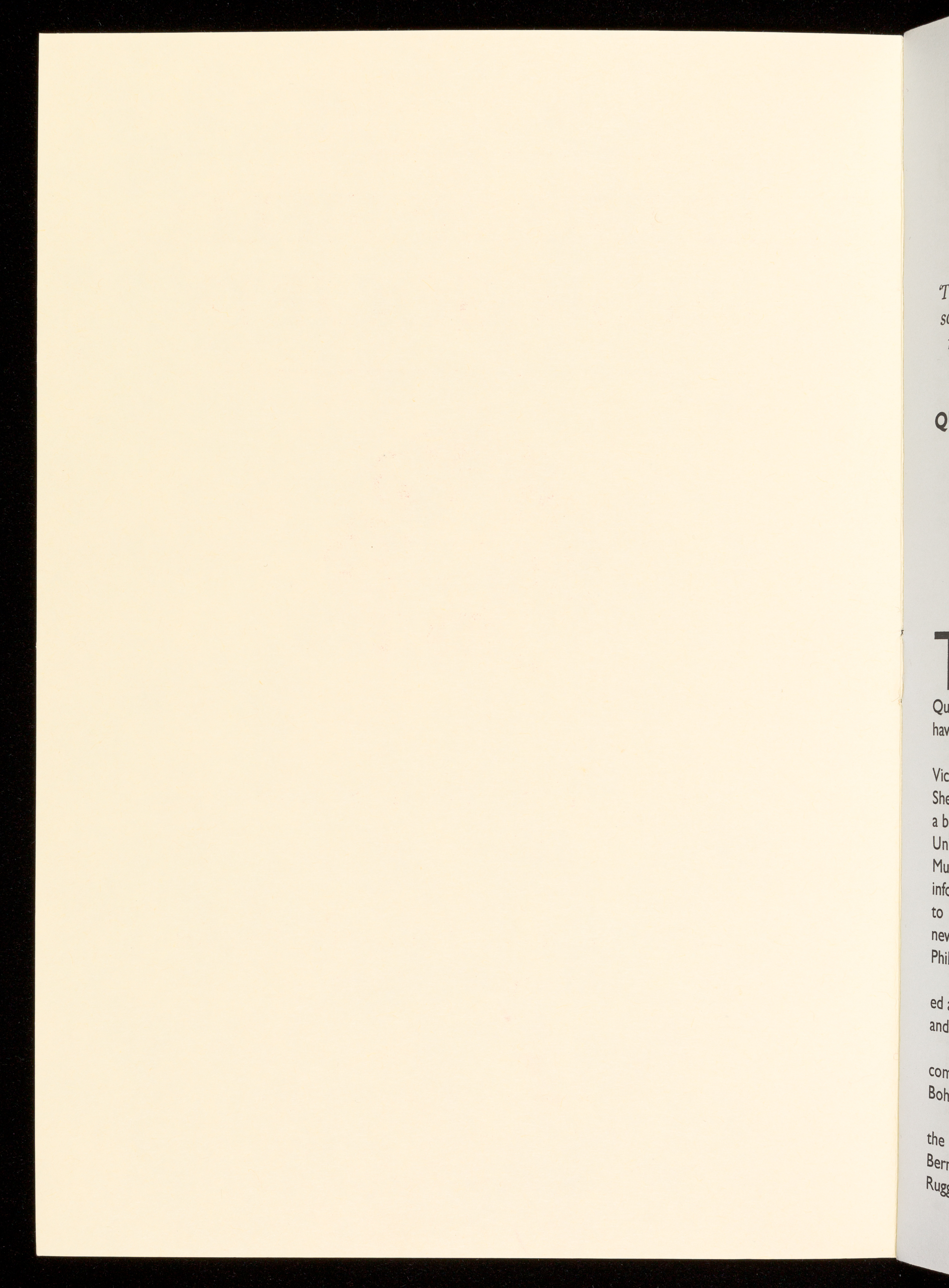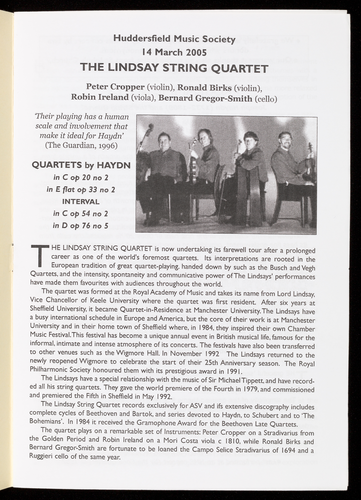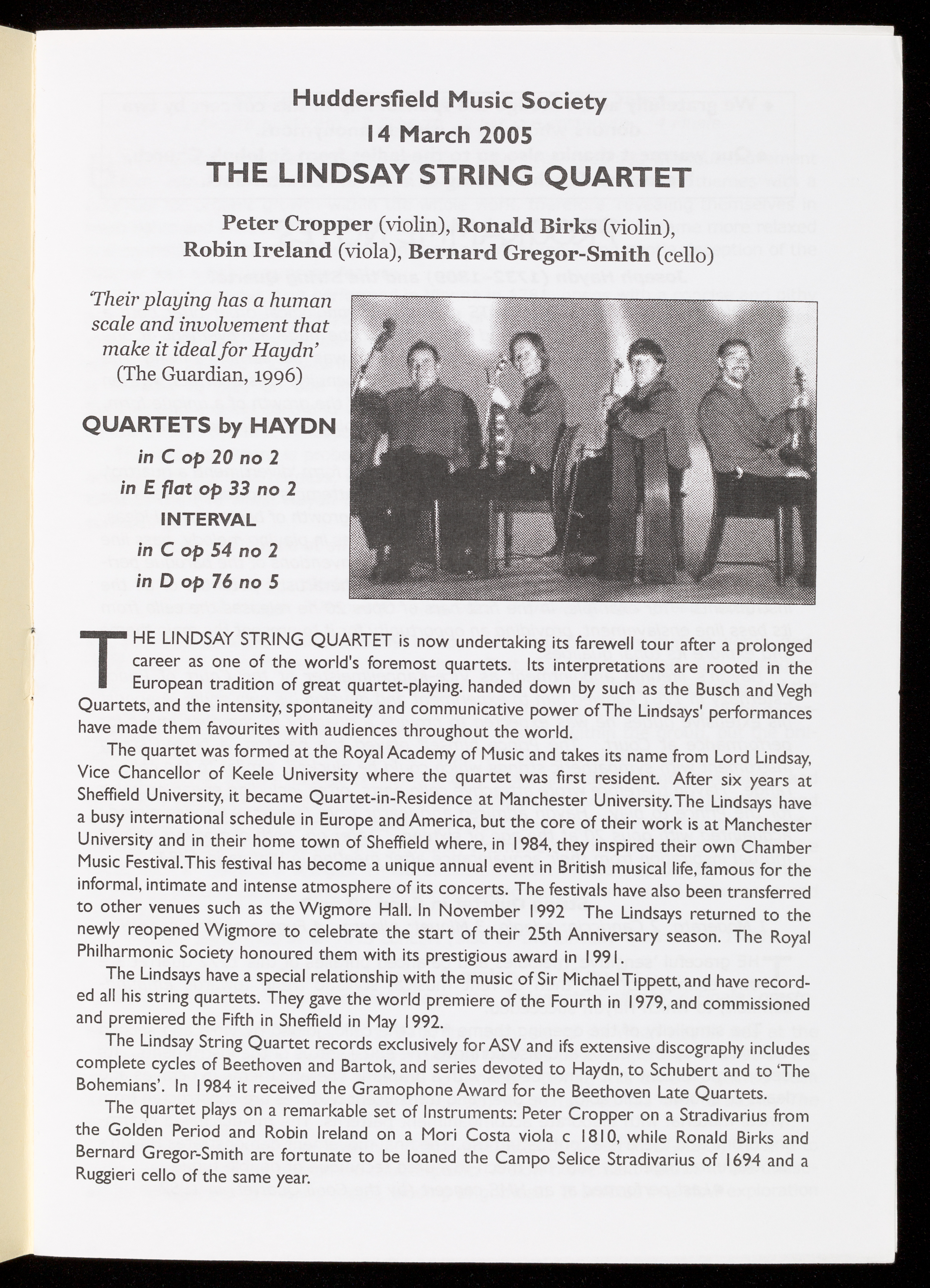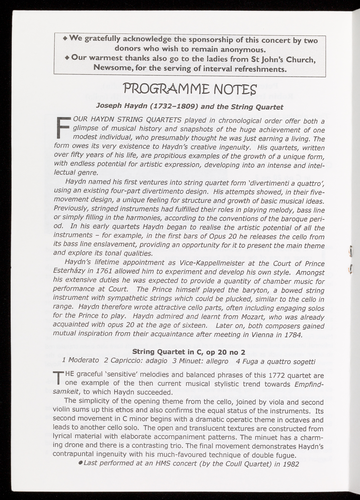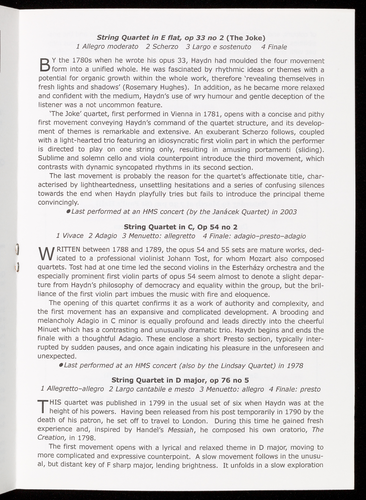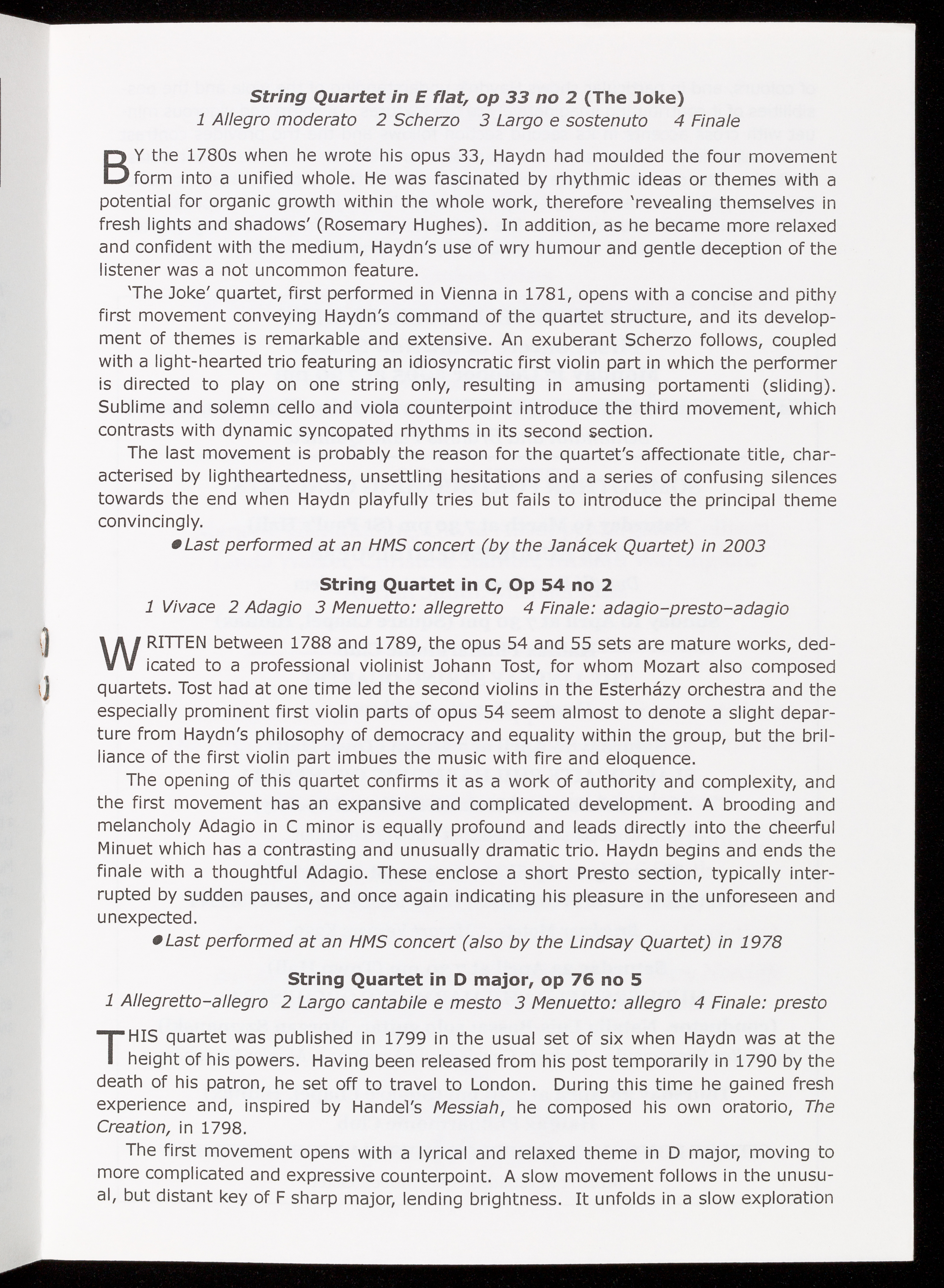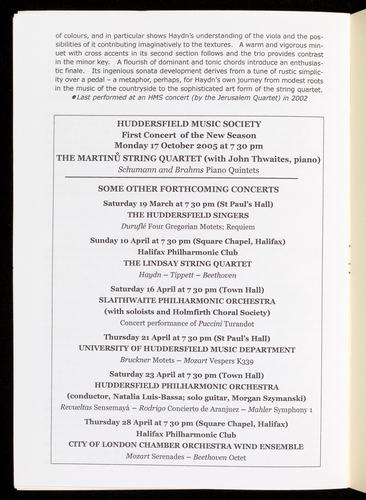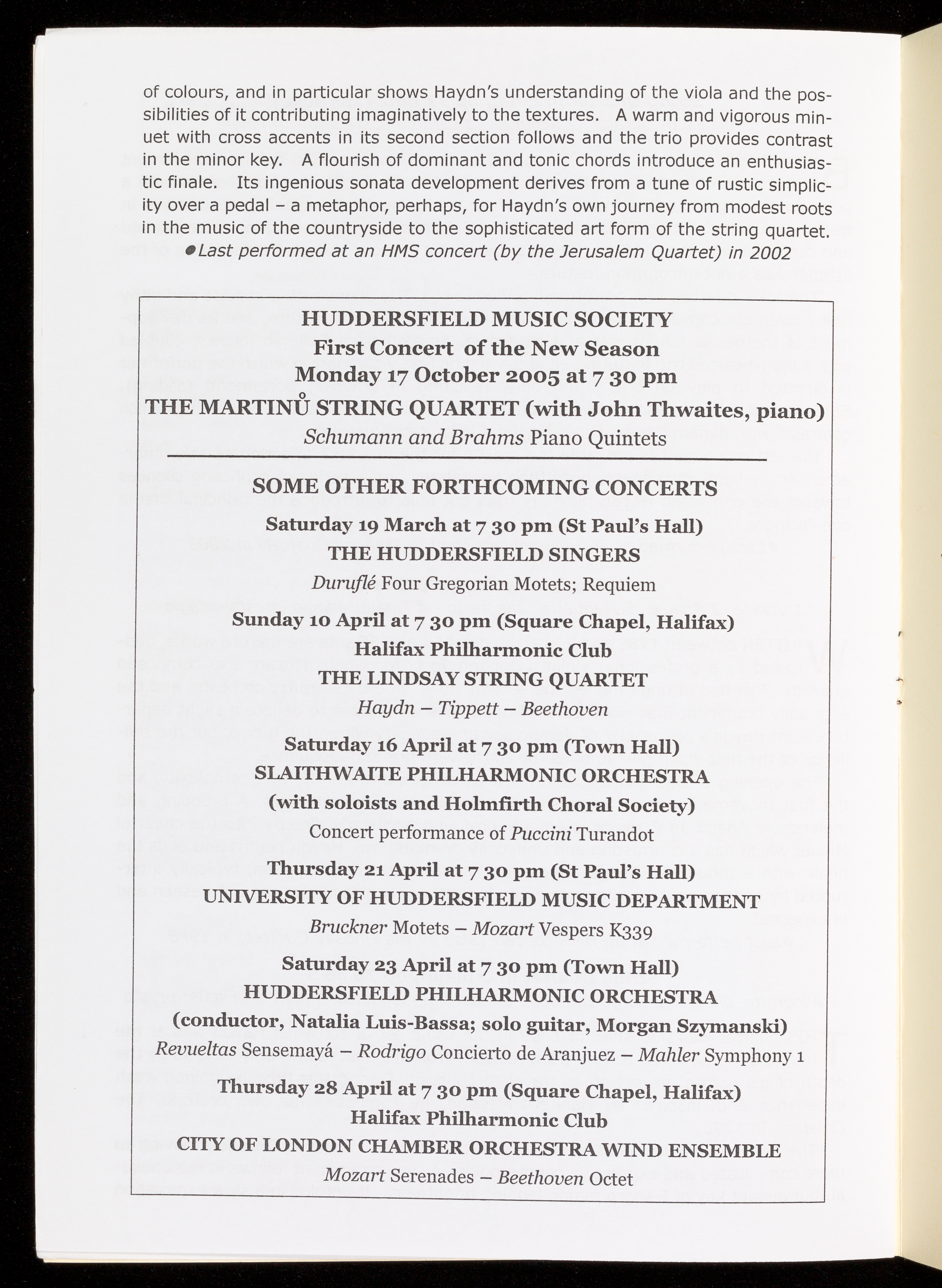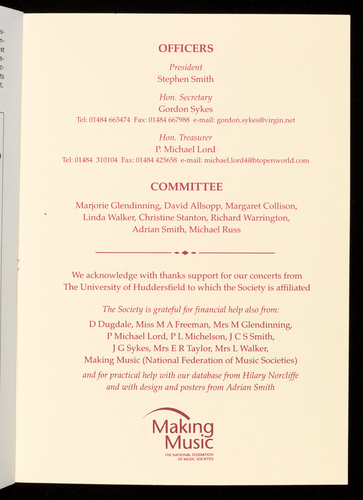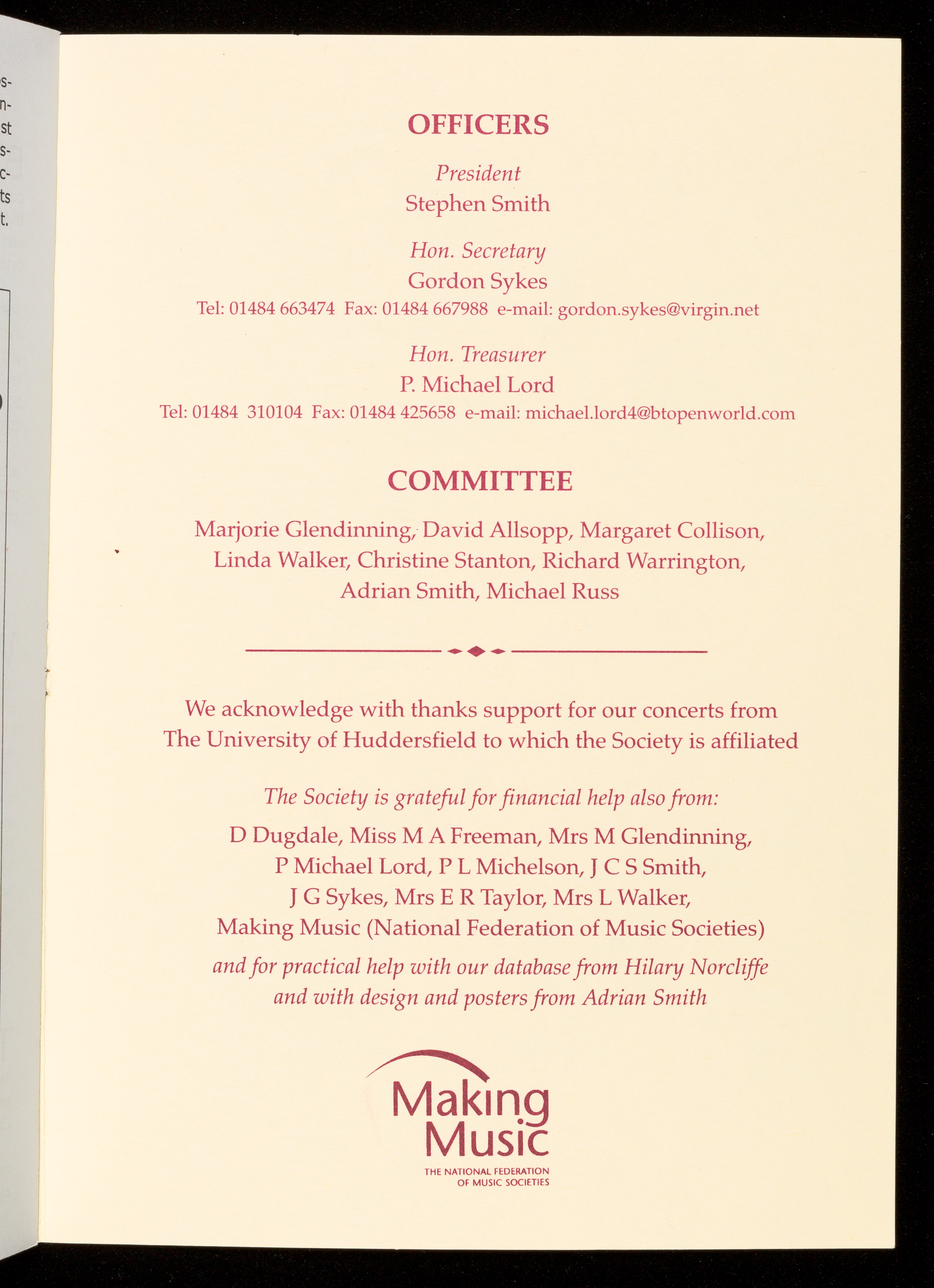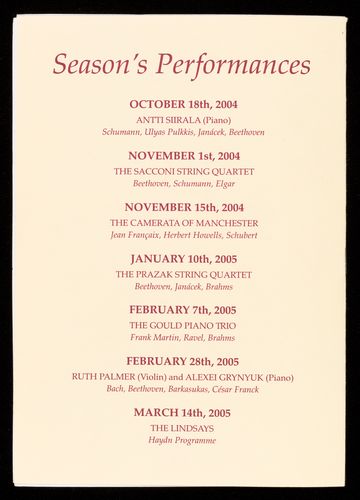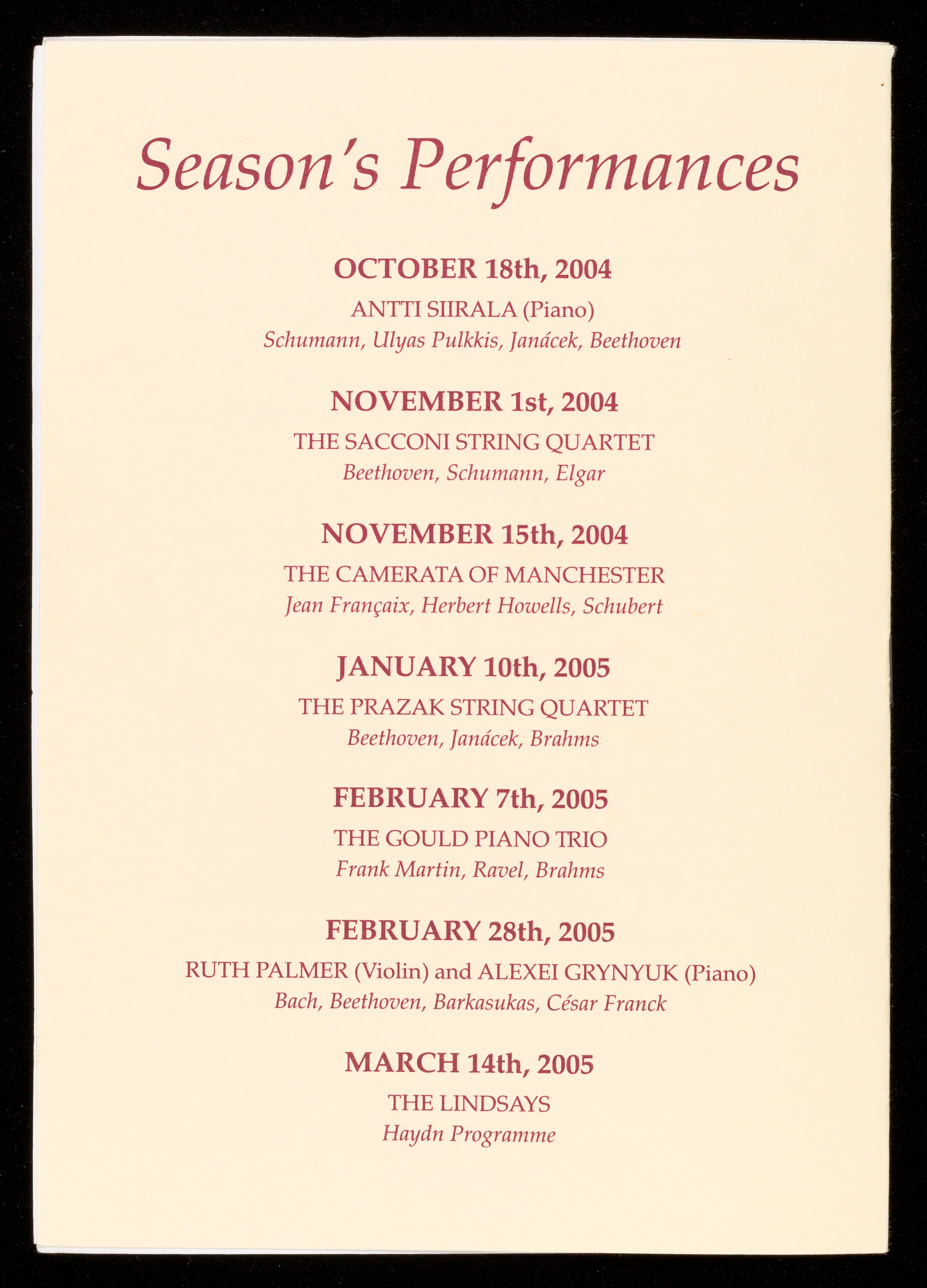Ocr'd Text:
St Paul's Hall,
Huddersfield
Huddersfield
Music Society
(President: Stephen Smith)
Eighty-seventh Season
The Lindsays
2004-2005
Given in association with the
'Music at the University of Huddersfield'
Evening Concert Series
Huddersfield Music Society is a Registered Charity
Ocr'd Text:
1 Monday 18 October 2004 at 7 30 pm
ANTTI SIIRALA (piano)
Three Romances op 28
New Commission
WE are fortunate to have
engaged Anti Siirala, the out-
standing player and deserved
winner of the 2003 Leeds
International Piano competi-
tion. His programme ranges
from a new commission to
Beethoven's mighty Variations
on a Waltz by Diabelli.
Schumann
Ulyas Pulkkis
Sonata 1.x. 1905
Janácek
Variations on a Waltz by Diabelli op 120 Beethoven
2 Monday 1 November 2004 at 7 30 pm
THE SACCONI STRING QUARTET
ONE of the brilliant young String Quartets which seem to
appear with great regularity nowadays, the Sacconi offer
two works from the mainstream classical repertoire and
give us a rare chance to sample Elgar's masterpiece in this
field.
String Quartet in C minor op 18 no 4
String Quartet in A op 41 no 3
String Quartet in E minor op 83
Beethoven
Schumann
Elgar
Ocr'd Text:
The Huddersfield Music Society is affiliated to the University of
Huddersfield and our concerts form part of its 'Evening Concert'
series. The other concerts in the series are given by the students
and staff of the School of Music and Humanities and cover a wide
range of musical performance. Full details are published in the
Department's brochure, 'Music at the University of Huddersfield',
obtainable from the Department of Music at the University (tel
01484 472003)
Single Season Ticket
Double Season Ticket
Single Concert Ticket:
Student Season Ticket
Student Single Ticket
Concerts 4 and 7 £15; others £12.50
&
Tickets may be obtained by using the booking form below or from
Huddersfield Information Centre, Albion Street (tel 01484
223200), or at the door. Please return unwanted season tickets to
the Treasurer by 25th September 2004.
Post this form with cheque payable to Huddersfield Music Society
to the Hon Treasurer, Mr Michael Lord, 14 Garsdale Road,
Newsome, Huddersfield HD4 6QZ.
Tel 01484 310104
Name
BOOKING FORM (please detach)
Please send .......... single/double season tickets
single concert tickets for
concert number(s)
Please send .......
Tickets
Address
Fax 01484 425658
E-mail Michael.Lord4@btopenworld.com
Postcode
.....
enclose cheque
£64
£126
Telephone
£15
£3
Total £
Ocr'd Text:
3 Monday 15 November 2004 at 7 30 pm
THE CAMERATA OF MANCHESTER
THE chance of engaging this brilliant ensemble from across
the Pennines for a performance of the Schubert Octet
proved too great to resist. The accompanying works by
Françaix and Howells are an added attraction.
Octet for Wind & Strings
Jean Françaix
Rhapsodic Quintet for Clarinet and Strings op 31
Herbert Howells
Schubert
Octet for Wind & Strings D803
4 Monday 10 January
WE were delighted to
learn that the Prazak,
one of our most regu-
lar and admired visi-
tors, were making
another UK tour. In
addition to their native Janácek they bring performances of
early Beethoven and mature Brahms to us.
String Quartet in F op 18 no 1
String Quartet No 2 (Intimate Letters)
String Quartet No 3 in B flat op 67
2005 at 7 30 pm
THE PRAZAK
STRING
QUARTET
ANOTHER ensemble we have
been delighted to welcome on
several previous occasions,
the Gould brings us perform-
ances of an interesting work
by the twentieth century
Swiss
composer Frank
Martin, the wonderful Ravel
Trio and Brahms' first.
5 Monday 7 February 2005 at 7 30 pm
THE GOULD PIANO TRIO
Trio on Irish Folk Songs
Piano Trio in A minor
Piano Trio no 1 in B op 8
Beethoven
Janácek
Brahms
Frank Martin
Ravel
Brahms
6 Monday 28 February 2005 at 7 30 pm
RUTH PALMER (violin) and
ALEXEI GRYNYUK (piano)
OUR 'Countess of Munster' recital is given for us by a very
youthful soloist, who has offered us what is obviously an
extremely demanding programme.
Partita no 1 in B minor for solo violin
Sonata no 3 for piano and violin op 12 no 3
Partita for solo violin
Sonata for violin and piano
Bach
Beethoven
Barkasukas
César Franck
7 Monday 14 March 2005 at 7 30 pm
THE LINDSAYS
OUR season concludes with positively their last visit to us
by the world-famous Lindsay Quartet. In their glittering
career they have become particularly renowned for their
sparkling performances of the quartets of Haydn, and it was
for this reason that we invited them to put together a pro-
It should be a
gramme based exclusively on his works.
delight.
String Quartet in C op 20 no 2
String Quartet in E flat op 33 no 2 (The Joke)
String Quartet in C op 54 no 2
String Quartet in D op 76 no 5
Haydn
Haydn
Haydn
Haydn
We acknowledge with thanks support from the University
of Huddersfield
to which the Society is affiliated.
The Society is grateful for financial help also from:
David Dugdale, Miss M A Freeman,
Mrs M Glendinning, P Michael Lord,
PL Michelson, JC S Smith, JG Sykes,
Mrs E R Taylor, Mrs L Walker,
Making Music (National Federation of Music Societies) and
the Countess of Munster Musical Trust.
Ocr'd Text:
A629
Huddersfield
Music Society
Making
Music
NEW NORTH ROA
www.huddersfield-music-society.org.uk
Honorary Secretary
Mr Gordon Sykes
Tel 01484 663474
E-mail gordon.sykes@virgin.net
TO HALIFAX
& M62
THE NATIONAL FEDERATION
OF MUSIC SOCIETIES
ROADO
TRINITY STREET
NORTH
-4011 m.
A62 MANCHESTER ROAD
TO MANCHESTER
OLL
STATION
CASTLE GATE
BUS
1002
500 001
RAILWAY STATION
Car parking should be
Yorkshire Arts
A616 CHAPEL HILL
00G00
00
On
30P
QUEESNGATE
CAR PARK
CHINOS IS
SOUTHGATE
TO LEEDS
QUEEN
LEEDS ROAD A62
St Paul's Hall for a small fee.
TO WAKEFIELD
& SHEFFIELD
4629 WAKEFIELD ROAD
ST. PAUL'S HALL
UNIVERSITY OF
HUDDERSFIELD
available across Queensgate from
The car park is lit and attended.
The concerts usually end at about 9 30 pm.
Ocr'd Text:
9068
QUI
HUDDERSFIELD MUSIC SOCIETY
Introduction to the
EIGHTY-SEVENTH SEASON
2004-2005
18 October 2004
ANTTI SIIRALA (piano)
The programme will include Beethoven Diabelli Variations
1 November 2004
THE SACCONI STRING QUARTET
Beethoven in C minor op 18 no 4;
Schumann in A op 41 no 3; Elgar in E minor
15 November 2004
THE CAMERATA OF MANCHESTER
Jean Françaix Octet;
Herbert Howells Rhapsodic Quintet for Clarinet and Strings;
Schubert Octet
10 January 2005
THE PRAZAK STRING QUARTET
Beethoven in F op18 no1; Janáček no 2 (Intimate Letters);
Brahms no 3 in B flat op67
7 February 2005
THE GOULD PIANO TRIO
Beethoven in E flat op 1 no 1; Ravel;
Shostakovich no 2 in E minor op67
28 February 2005
RUTH PALMER (violin) and ALEXEI GRYNYUK (piano)
Bach Partita no 1 in B minor; Beethoven Sonata op 12 no 3;
Bachasukas Partita for solo violin; Franck Sonata
14 March 2005
THE LINDSAYS
Haydn Quartets: in C op 20 no 2; in E flat op 33 no 2 (Joke');
in C op 54 no 2; in D op 76 n05
Ocr'd Text:
We are extremely fortunate to have engaged Antti Siirala, the winner of the 2003
Leeds International Piano Competition, to play for us at our opening concert. He
was the undoubted outstanding finalist from a field which seemed to contain even
more than the usual range of talent.
We have arranged three string quartet recitals. The first features the young British
ensemble, the Sacconi: formed at the Royal College of Music in 2001, the Quartet
has already established a considerable reputation, giving many concerts both in the
UK and in Europe.
In early January we welcome another return visit by one of our favourite quartets,
the Prazak: the mandatory Czech item is Janáček's Intimate Letters Quartet.
For our concluding concert the Lindsays will be making positively their last
appearance in Huddersfield, for they are due to disband later in the year. They
have done much to enhance the reputation of Haydn as a quartet composer during
their many years at the top of the profession, and this has influenced the choice of
programme.
The Camerata of Manchester will be giving us a rare opportunity to hear a pub-
lic performance of the Schubert Octet in November. The Gould Piano Trio
returns once more with Beethoven, Ravel and Shostakovich, and our programme is
completed with the appearance of another very promising young violinist, Ruth
Palmer, who offers a virtuoso recital, including the César Franck Sonata and some
unaccompanied Bach.
Tickets for next season will be on sale at this season's last two concerts as follows:
Double Season Ticket £124.00 (£126.00 after 30 April 2004)
Single Season Ticket £63.00 (£64.00 after 30 April 2004)
Single Concert Tickets: Prazak and Lindsays £15.00; others £12.50
(Students: Season Ticket £15.00; Single Ticket £3.00)
SAND
We thank all our sponsors (notably the Arts
Council, Making Music and the Countess of
Munster Musical Trust), patrons and
subscribers for their continued support
and hope that the concerts set out here will
prove attractive and stimulating.
Huddersfield Music Society is a Registered Charity
COUNCIL
ENGLAND
Making
Music
THE NATIONAL FEDERATION
OF MUSIC SOCIETIES
Ocr'd Text:
HUDDERSFIELD
MUSIC SOCIETY
II
WT.
Eighty-seventh Season
2004-2005
St. Paul's Concert Hall, Queensgate
Monday 7.30pm
www.huddersfield-music-society.org.uk
Registered Charity 529340
President: Stephen Smith
Ocr'd Text:
Huddersfield Music Society
16 October 2004
ANTTI SIIRALA (piano)
2. Three Romances op 28
3. Métopes op 29
1. Sonata 1.x.1905
INTERVAL
4. Variations on a Waltz by Diabelli op 120
Schumann
Karol Szymanowski
Janácek
Beethoven
'He took the audience by storm... like a radiant northern light, the star of
this young Finn ascended the firmament of pianists.' (Der Standard, Austria)
N a display of artistry astonishing in one so
young, the 20-year-old Finn Antti Siirala
became Winner of the International Piano
Competition in London in April 2000. Three
years later he has secured his position as one
of the foremost pianists of his generation by
winning First Prize in the Leeds and Dublin
International Piano Competitions.
Antti Siirala was born in Helsinki in 1979
into a musical family. He made his debut with.
orchestra at the age of seven and went on to
win First Prize in the Juvenalia Chamber Music
Competition at 13. Since then, he has been
awarded prizes in eight music competitions in
Finland. A student at the Sibelius Academy
with Matti Raekallio and Ivari Ilja, he was also
encouraged by Mitsuko Uchida and Murray
Perahia. No stranger to international piano
competitions, Siirala had already won Second
Prize in the Dino Ciani Competition in Milan,
and First Prize and a special award for the best
performance of the Hammerklavier Sonata in
the Beethoven Competition in Vienna before coming to London.
Siirala frequently performs in solo recitals, with orchestra and as a chamber musician
at international venues. He has made solo appearances in many important European
music centres including Vienna, London, Milan, Paris, Brussels and Berlin. Siirala has also
been heard at many important music festivals, including the Helsinki Festival, the
Duszniki Zdroj Chopin Festival and the Marlboro Music Festival in the USA. Last year
he gave his debut recital in Tokyo. As a soloist, Siirala has worked with many renowned
Ocr'd Text:
conductors, and has performed with many of the leading European orchestras. He fre-
quently plays contemporary music, and has recorded for many radio and TV networks.
Antti Siirala's future engagements include the first performances of works by Uljas
Pulkkis and Kalevi Aho and a cycle of the five Beethoven Concerti and the Choral Fantasy
in Finland.
His debut recording of Schubert transcriptions (part of the Grand Prize of the London
International Piano Competition) was released last year by Naxos. The recording was the
'Editor's Choice' in the August 2003 edition of Gramophone Magazine.
Robert Schumann (1810-1856)
III Sehr markiert
Drei Romanzen op 28
Sow
I Sehr markiert II Einfach
CHUMANN fell in love with Clara, his former piano teacher's daughter, who was also
an accomplished pianist, in 1835 and many of his greatest piano masterpieces were
written for her to play during the period of courtship up to 1840, including the pas-
sionate Kreisleriana, Fantasiestücke and the beautiful C major Fantasy. The Three
Romances were written in 1839 just before they were married without her father's per-
mission.
PROGRAMME NOTES
These three miniatures once again communicate his ardour for Clara. In the manner of
Romantic composers, they communicate his fervour and zeal but also display an innate
sense of Classical balance and proportion. Schumann's own command of the piano is evi-
dent in the use of major keys each employing five sharps or flats but which lie perfectly
under the fingers of a genuine artist.
The first is a direct and passionate movement scarcely pausing for breath, the second,
a reflective and almost reverential piece, and finally a lengthy movement of directness
completes the set.
Métopes op 29
Karol Szymanowski (1882-1937)
1 Isle of Sirens 2 Calypso 3 Nausicaa
A
LTHOUGH Szymanowski was a Polish composer, born in the late 19th century and
raised on the piano works of Chopin and Scriabin, he was first trained in the tra-
ditions of the German romantic composers. Visits to Europe later and acquaintance
with the highly original language of Debussy, Ravel and Stravinsky clearly changed and
enriched his personal compositional style. This work strongly reveals impressionistic influ-
ences in its harmonic and rhythmic subtleties and flexibility of phrase and structure.
The triptych, composed in 1915, suggested by 'métopes' ['square spaces between two
triglyphs in a Doric frieze'] he visited in Palermo, are intended to outline stages in mytho-
logical history based on Homer's Odyssey.
The first piece reminds us that the Sirens were half bird and half woman; the second
portrays the daughter of Atlas who personified the depths of the sea and who kept
Odysseus on the island of Ortigia for seven years; and the third depicts the dancing of
Nausicaa and her maidens who discovered Odysseus after his shipwreck. Images of the
sea abound in the music; also piano configurations which represent the double lyre and
lute and, in the first and last pieces, bird calls.
S
d
a
fr
a
ir
e
0
p
n
b
r
C
UJ
UJ
S
TU
2
r
r
C
r
U
r
T
C
a
S
n
t
in
Ocr'd Text:
0
Sonata 1.10.1905 ('From the street')
Leos Janácek (1854-1928)
1 Premonition (con moto) 2 Death (adagio)
HIS sonata was born out of a traumatic event in the lives of Janácek and his con-
temporaries in the manner that many other twentieth century works of art
responded to a political event or situation. A worker taking part in a peaceful
demonstration calling for a second Czech university was brutally stabbed to death with
a bayonet. The outrage aroused fear and horror and generated a new musical language
from Janácek.
His belief that musical notes 'mean nothing at all unless they are steeped in life, blood
and nature' enabled him to create an almost photographic representation of the abom-
ination, translating human experience directly into music.
In the first movement the expression of overwhelming pain and pathos can be detect-
ed in its repetition of motivic melodies which are developed to encompass a spectrum
of emotions. Other indications of disquiet lie beneath the textures in the uneasy accom-
paniments sometimes leading to passionate and eloquent declamations/invective.
The simply crafted opening phrases of the second movement express the pointless-
ness of the death in their pathos and melancholy. Later the movement intensifies,
building more continuous textures of anguish and releasing extremes of emotion,
returning once more to the quiet despair and pathos of the opening.
33 Variations on a Waltz by Anton Diabelli op 120
Beethoven (1770-1827)
C
HARLES ROSEN wrote, 'Beethoven was the greatest master of musical time. In no
other composer is the relation between intensity and duration so closely
observed; . . . no other composer understood so well... the effect of simple reit-
eration, the power that can be drawn from repetition, the tension that can arise from
delay.'
This comment underlines and explains Beethoven's genius in building a large-scale
structured work of richness and intensity from the restrained discipline of Diabelli's waltz
theme. It is a late work and reflects his experience in handling extended symphonic
material. The music mirrors the depth and intensity found not only in his late piano
sonatas but also in his chamber music. Beethoven transformed the conventional static
and repetitive variation form into a dramatic and progressive whole by employing a
more architectural approach and presenting the variations in larger groups whilst still
retaining their contrasting individuality.
The first thirteen movements, all in 3/4 time, appear to be grouped together as an
opening statement. They explore the simple binary theme through original piano figu-
ration and diverse speeds, textures and moods. One is in the tonic minor key (9); a
short march-style variation completes the first group.
The second group introduces an element of hesitation and premonition in the grave e
maestoso variation (14), quickly repudiated by its ensuing capricious and playful variation.
Thereafter Beethoven pursues a path of invention and brilliance displaying the typical fire
characteristic of his late piano sonatas; that is, until a humorous variation (22), based on
an aria by Mozart, brings temporary but welcome relief from the escalating emotional ten-
sion.
However he quickly recaptures the inexorable progress towards his goal when what
might be regarded as the final section is ushered in by the more cerebral four-part coun-
terpoint of a Bach-like fughetta (24). Once again the mood is briefly dispelled by four
impulsive and stimulating movements, including a dance (25) recalling Diabelli's theme
Ocr'd Text:
and an exhilarating toccata (27). Three expressive and uneasy minor variations,
increasingly polyphonic and with chromatically embellished lines, lead up to the final and
complex double fugue in C minor (32). It is highly dramatic in its delayed climaxes and
unexpectedly concludes on a subdued and inconclusive discord. The final minuet (33)
is clearly a metamorphosis of the Diabelli waltz, but its elegant decoration and expres-
siveness imbue it with altogether more depth and significance than its precursor.
● Previous HMS performances of this work were given in 1968 by Stephen Bishop
(now Stephen Kovacevich) and in 1994 by Artur Pizarro.
HUDDERSFIELD MUSIC SOCIETY
Next Concert
Monday 3 November at 7 30 pm
THE SACCONI STRING QUARTET
String Quartet in C minor op 18 no 4
String Quartet in A op 41 no 3
String Quartet in E minor op 83
Beethoven
Schumann
Elgar
OTHER FORTHCOMING CONCERTS
Wednesday 27 October at 1 15 pm (St Paul's)
UNIVERSITY OF HUDDERSFIELD BRASS BAND
(Phillip McCann, conductor, with Graham Cummings, organ)
Tuesday 2 November at 7 30 pm (St Paul's)
REGIMENTAL BAND OF THE COLDSTREAM GUARDS
and THE UNIVERSITY SYMPHONIC WIND BAND
(Major G O Jones and Phillip McCann, conductors)
Saturday 13 November at 7 30 pm (Town Hall)
HUDDERSFIELD PHILHARMONIC ORCHESTRA
(Natalia Luis-Bassa, conductor; Martin Roscoe, piano)
Tchaikovsky - Francesca da Rimini
Dohnányi - Variations on a Nursery Song
Tchaikovsky - Marche Slave
Prokofiev - Romeo and Juliet: Suite no 2
Friday 19 November at 7 30 pm (Square Chapel, Halifax)
Halifax Philharmonic Club
THE HANOVER BAND
in a programme of music by J S Bach
Ocr'd Text:
S₁
nd
nd
3)
S-
"P
OFFICERS
President
Stephen Smith
Hon. Secretary
Gordon Sykes
Tel: 01484 663474 Fax: 01484 667988 e-mail: gordon.sykes@virgin.net
Hon. Treasurer
P. Michael Lord
Tel: 01484 310104 Fax: 01484 425658 e-mail: michael.lord4@btopenworld.com
COMMITTEE
Marjorie Glendinning, David Allsopp, Margaret Collison,
Linda Walker, Christine Stanton, Richard Warrington,
Adrian Smith, Michael Russ
We acknowledge with thanks support for our concerts from
The University of Huddersfield to which the Society is affiliated
The Society is grateful for financial help also from:
D Dugdale, Miss M A Freeman, Mrs M Glendinning,
P Michael Lord, P L Michelson, JC S Smith,
JG Sykes, Mrs E R Taylor, Mrs L Walker,
Making Music (National Federation of Music Societies)
and for practical help with our database from Hilary Norcliffe
and with design and posters from Adrian Smith
Making
Music
THE NATIONAL FEDERATION
OF MUSIC SOCIETIES
Ocr'd Text:
Season's Performances
OCTOBER 18th, 2004
ANTTI SIIRALA (Piano)
Schumann, Ulyas Pulkkis, Janácek, Beethoven
NOVEMBER 1st, 2004
THE SACCONI STRING QUARTET
Beethoven, Schumann, Elgar
NOVEMBER 15th, 2004
THE CAMERATA OF MANCHESTER
Jean Françaix, Herbert Howells, Schubert
JANUARY 10th, 2005
THE PRAZAK STRING QUARTET
Beethoven, Janácek, Brahms
FEBRUARY 7th, 2005
THE GOULD PIANO TRIO
Frank Martin, Ravel, Brahms
FEBRUARY 28th, 2005
RUTH PALMER (Violin) and ALEXEI GRYNYUK (Piano)
Bach, Beethoven, Barkasukas, César Franck
MARCH 14th, 2005
THE LINDSAYS
Haydn Programme
Ocr'd Text:
HUDDERSFIELD
MUSIC SOCIETY
W1.
Eighty-seventh Season
2004-2005
St. Paul's Concert Hall, Queensgate
Monday 7.30pm
www.huddersfield-music-society.org.uk
Registered Charity 529340
President: Stephen Smith
Ocr'd Text:
St
S
S
O FERN
0
b
it
r.
P
A
J
1
t
D
D
C
n
E
n
t
C
Ocr'd Text:
Huddersfield Music Society
I November 2004
THE SACCONI STRING QUARTET
Ben Hancox (violin), Hannah Dawson (violin),
Robin Ashwell (viola), Cara Berridge (cello)
String Quartet in C minor op 18 no 4
String Quartet in A op 41 no 3
INTERVAL
Beethoven
Schumann
String Quartet in E minor op 83
Elgar
Their rare quality, however, is the ability to combine their talents and forge an ensemble of
the highest quality and distinctive musical character. (Levon Chilingirian OBE)
T
HE Sacconi String
Quartet is now
acknowledged as one
of the finest young string
quartets in the country, since
its formation at London's
Royal College of Music in
2001. The quartet is cur-
rently giving performances as
part of the Tillett Trust Young
Artists' Platform scheme, and
recently made its debut in the
Wigmore Hall. Winners of
the prestigious Gerard Heller
and Rosemary Rapaport string
quartet prize (held for all UK
conservatoires), these musi-
cians have also twice been awarded the Helen Just and Susan Connell string chamber
music prize at the Royal College of Music.
The Sacconi Quartet pursues a busy schedule of recitals throughout the UK and
Europe. It has performed both the Mendelssohn Octet and the Schubert Quintet with
members of the world renowned Chilingirian Quartet, to great acclaim. The quartet
has performed for two years running in the Lake District Summer Music festival, where
they were assistant coaches to the Chilingirian Quartet and supported by the Ernest
Cook Trust Fellowship.
During 2004 the quartet has given two world premières: a clarinet quintet by
Ocr'd Text:
Roderick Watkins, performed with clarinetist David Campbell, and a string quartet
Iridescence by Max Charles Davies.
The Sacconi Quartet pursues a keen interest in education work, and has a programme
of recitals in London schools in collaboration with the CAVATINA Chamber Music Trust. It
makes regular visits to schools, hospitals and other community venues on behalf of Live
Music Now! and the Wigmore Hall, and was Ensemble in Residence on the National Young
Pianists' Week in Uppingham.
The quartet is given valuable support by the Musicians' Benevolent Fund, and is spon-
sored by consultancy firm m.a.Partners. The name 'Sacconi Quartet' comes from the out-
standing twentieth-century Italian violin maker and restorer Simone Sacconi, whose book
The Secrets of Stradivari is considered an indispensable reference for violin makers.
PROGRAMME NOTES
String Quartet in C minor op 18 no 4
Beethoven (1770-1827)
A
LTHOUGH there is much evidence of spontaneity and youthful vigour in this
particular work written in the late 1790s, the authority of Beethoven's quartet style
already established by the beginning of the opus. Beethoven himself was not
convinced of this as he later wrote endearingly to his friend, Carl Amenda about number
one of the set, 'Don't let anyone see [the] quartet as I have greatly changed it, as only
now do I know how to write quartets properly.'
The explosive accents of the opening are characteristic of Beethoven's directness of
expression, and the key of C minor lends itself to the dramatic style of the work in which
the intensive first subject proceeds without any introduction. A move to C major in the
second subject of the first movement reflects Haydn's work in the setting up of thematic
relationships within the classical sonata movement.
The second movement is not a slow movement but an elegant and witty dance.
Beethoven demonstrates expertise in writing counterpoint and the entire movement grows
organically from its opening.
The strong syncopations on the third beat of a turbulent minuet contribute to a feeling
of lack of composure but the trio section regains its equilibrium with more conventional
writing in the major key.
1 Allegro ma non tanto 2 Andante scherzoso quasi allegro
3 Menuetto: allegretto 4 Allegro-prestissimo
A gypsy finale is suggestive of an equivalent movement in Haydn's first piano trio and
although its energy propels the piece forward there are moments for pause and reflection.
The final bars are wonderfully individual and typical of the composer in their
unexpectedness.
String Quartet in A op 41 no 3
Schumann (1810-1856)
1 Andante expressive-allegro moderato 2 Assai agitato
3 Adagio molto 4 Finale: allegro molto vivace
I
N 1842 Schumann wrote the three quartets of opus 41 in an attempt to release
himself from the struggle of composing the intensely subjective piano music which was
undermining his health. He was urged by his wife Clara to try to compose some music
Ocr'd Text:
}
J
that was 'more easily understandable' and 'striving to give pleasure'. These quartets
are dedicated to Mendelssohn whose work he admired.
This quartet is in A major, a key defining brightness and warmth. Its motif of a
falling fifth opens the gentle Andante introduction and also permeates the whole of the
first movement. Schumann's skilful manipulation of his melodic material is displayed
throughout in his colourful polyphony, already relished by him in his piano music.
The Scherzo is a variation movement with signs of agitation in its continually
displaced rhythms at the beginning. The theme becomes clearer in the third variation
which is robust and imitative. Number four is more earnest and introspective; number
five is vigorous and concludes with a lyrical coda.
Signs of Schumann's abundant gifts for lyrical melody personalise the slow
movement in its contemplative and endless interplay of parts.
The Finale has a spirited and quicksilver rondo theme insinuating itself between the
contrasting sections which often embody folk elements. The repetition of dotted
rhythms combined with rising pitch towards the end brings the music to a fulfilling
resolution.
String Quartet in E minor op 83
Edward Elgar (1857-1934)
1 Allegro moderato 2 Piacevole (poco andante) 3 Allegro molto
E
LGAR was a natural and spontaneous musician and this is born out by his own
statement, 'the music is in the air all around us, the world is full of it, and at any
given time you simply take as much of it as you require.' Part of his unique
musical language sprang from his absorption of English folk song and its modal
harmonies which seem to reflect the English countryside at the time of the first world
war also reflecting the distinctive emotions and impressions of people's lives at that
time.
This work in E minor (also the key of his violin sonata and cello concerto) was writ-
ten in his greatest and final period and completed on Christmas Eve 1918. It is a
mature work capturing the feelings of unrest and depression of the war years. The
quartet received its first performance at the Wigmore Hall in 1919 and was dedicated to
the Brodsky quartet.
The beginning creates a wonderful sense of lightness in which a rising gestural motif
is answered by a falling one. The music seems to be searching without finding any
permanent resolution, always exploring a wide and changing range of pitch and colour.
It concludes significantly on a major chord.
[please turn over]
.free tickets... free tickets... free tickets... free tickets...
CONCERT on MONDAY 28 FEBRUARY 2005
Don't forget that double and single SEASON TICKET
HOLDERS can claim two or one FREE tickets for the above concert.
Please contact our Treasurer, Mr Michael Lord, to claim your tickets.
It would be lovely to see a full house at this fine violinist's recital!
free tickets... free tickets... free tickets... free tickets...
●
Ocr'd Text:
In the second movement there is a release of tension and its melodies are sweet and
lyrical. Understandably Alice Elgar described this music as 'captured sunshine'. The
final section is muted, and its simple and languid closing phrases highlight the
exquisite individual instrumental lines.
In the finale a fluid and unison opening gives way to soaring eloquence from all
instruments and the music flows confidently, seemingly offering hope for the future.
Throughout the whole work one is aware of Elgar's grasp of the capabilities each
individual instrument and his intuitive knowledge of the vast and fluctuating timbres
they can jointly produce, probably because he himself was an accomplished violinist.
HUDDERSFIELD MUSIC SOCIETY
Next Concert
Monday 15 November at 7 30 pm
THE MANCHESTER CAMERATA ENSEMBLE
Jean Françaix
Octet for Wind & Strings
Rhapsodic Quintet for Clarinet and Strings op 31
Octet for Wind & Strings D 803
Herbert Howells
Schubert
OTHER FORTHCOMING CONCERTS
Tuesday 2 November at 7 30 pm (St Paul's)
REGIMENTAL BAND OF THE COLDSTREAM GUARDS
and THE UNIVERSITY SYMPHONIC WIND BAND
(Major G O Jones and Phillip McCann, conductors)
Saturday 13 November at 7 30 pm (Town Hall)
HUDDERSFIELD PHILHARMONIC ORCHESTRA
(Natalia Luis-Bassa, conductor; Martin Roscoe, piano)
Tchaikovsky - Francesca da Rimini
Dohnányi - Variations on a Nursery Song
Tchaikovsky - Marche Slave
Prokofiev - Romeo and Juliet: Suite no 2
Friday 19 November at 7 30 pm (Square Chapel, Halifax)
Halifax Philharmonic Club
THE HANOVER BAND
in a programme of music by J S Bach
Ocr'd Text:
OFFICERS
President
Stephen Smith
Hon. Secretary
Gordon Sykes
Tel: 01484 663474 Fax: 01484 667988 e-mail: gordon.sykes@virgin.net
Hon. Treasurer
P. Michael Lord
Tel: 01484 310104 Fax: 01484 425658 e-mail: michael.lord4@btopenworld.com
COMMITTEE
Marjorie Glendinning, David Allsopp, Margaret Collison,
Linda Walker, Christine Stanton, Richard Warrington,
Adrian Smith, Michael Russ
We acknowledge with thanks support for our concerts from
The University of Huddersfield to which the Society is affiliated
The Society is grateful for financial help also from:
D Dugdale, Miss M A Freeman, Mrs M Glendinning,
P Michael Lord, P L Michelson, JC S Smith,
JG Sykes, Mrs E R Taylor, Mrs L Walker,
Making Music (National Federation of Music Societies)
and for practical help with our database from Hilary Norcliffe
and with design and posters from Adrian Smith
Making
Music
THE NATIONAL FEDERATION
OF MUSIC SOCIETIES
Ocr'd Text:
Season's Performances
OCTOBER 18th, 2004
ANTTI SIIRALA (Piano)
Schumann, Ulyas Pulkkis, Janácek, Beethoven
NOVEMBER 1st, 2004
THE SACCONI STRING QUARTET
Beethoven, Schumann, Elgar
NOVEMBER 15th, 2004
THE CAMERATA OF MANCHESTER
Jean Françaix, Herbert Howells, Schubert
JANUARY 10th, 2005
THE PRAZAK STRING QUARTET
Beethoven, Janácek, Brahms
FEBRUARY 7th, 2005
THE GOULD PIANO TRIO
Frank Martin, Ravel, Brahms
FEBRUARY 28th, 2005
RUTH PALMER (Violin) and ALEXEI GRYNYUK (Piano)
Bach, Beethoven, Barkasukas, César Franck
MARCH 14th, 2005
THE LINDSAYS
Haydn Programme
Ocr'd Text:
HUDDERSFIELD
MUSIC SOCIETY
WT.
Eighty-seventh Season
2004-2005
St. Paul's Concert Hall, Queensgate
Monday 7.30pm
www.huddersfield-music-society.org.uk
Registered Charity 529340
President: Stephen Smith
Ocr'd Text:
Huddersfield Music Society
15 November 2004
The Manchester Camerata Ensemble
Richard Howarth (violin) Catherine Yates (violin)
Richard Williamson (viola) Jonathan Price (cello)
Daniel Storer (double bass) Fiona Cross (clarinet)
Laurence Perkins (bassoon) Naomi Atherton (horn)
Octet for Wind & Strings
Rhapsodic Quintet for Clarinet and Strings op 31
INTERVAL
Octet for Wind & Strings D 803
L
ED by Richard Howarth, Camerata
Ensemble has an established repu-
tation as the North West's leading
chamber music group. Drawing on first
class players from Manchester Camerata,
the ensemble has applied its orchestral
expertise in developing an exciting and
distinctive style and sound. The ensem-
ble's flexibility enables it to offer a broad
repertoire of familiar and more unusual
pieces.
Jean Françaix
Herbert Howells
Schubert
Fiona Cross
Camerata Ensemble performs regu-
larly at the Royal Northern College of Music, Lancaster University and many venues
around the region. It is experienced in the field of education and places a high priority
on its work in the community. The group is available for composition and masterclass
workshops at all levels.
First performances of new works include the Nonet by Ivor McGregor and, more
recently, the Suite by Patrick Gowers which was commissioned by the National Trust to
celebrate its Centenary. At the invitation of the North West Composers Association,
Camerata Ensemble has recorded string quartets by Geoffrey Poole, Robin Walker and
Kevin Malone, and has recently finished a further recording project to include quartets
and string trios by John McCabe and David Ellis. Another CD released at the end of
2001 with recorder player John Turner presented several new works for recorder and
string quartet.
In the Spring of 2000, Camerata Ensemble, together with the pianist Martin Roscoe,
Ocr'd Text:
were joint artistic directors and resident artists of a Millennium Music Festival promoted
by Holmes Chapel Music Society. A new piano quintet was commissioned from Stephen
Dodgson for the occasion, and the nine-concert weekend culminated in a performance of
Messiaen's Quartet for the End of Time with guest clarinetist Emma Johnson.
Octet
PROGRAMME NOTES
Jean Françaix (1912-1996)
1 Moderato - allegrissimo 2 Scherzo - trio
3 Andante - adagio 4 Mouvement de valse
EAN FRANÇAIX reached maturity between the two world wars and studied with Nadia
to
raries reflecting neo-classical tendencies in reviving ideals, forms and textures of classical
styles, but with the addition of twentieth century harmonic and rhythmic subtleties.
Françaix uses the same instrumentation in his octet (string quintet, clarinet, basson
and horn) as Schubert.
The first movement begins with a slow introduction evoking the emotional and tonal
world of the Germanic romantic period. A short melody is developed imitatively in a clar-
inet and bassoon duet and continues in cheerful vein. The movement takes on new life
and reaches a highly dramatic climax, intensified by a general pause. The movement pro-
ceeds to a simple and quiet conclusion with a coda which forms the transition to the next
movement.
The scherzo is characterised by syncopation and many of the scherzo rhythmic motifs
also appear in the wind voices of the relatively short trio. Within this elegantly constructed
scherzo Françaix makes ironic allusions to popular music of the 30s.
A romantic intermezzo begins the third movement after which the string quintet and
the wind trio make their separate appearances. There is a return to the first theme by
the strings, adorned with wind scales. A short coda concludes the movement.
The finale consists of a short introduction and a series of three waltzes followed by a
coda. The coda briefly quotes the waltzes and concludes with the introductory motif. Once
again the composer makes wry references to the waltz style of operettas of the period.
This work has not been previously performed at an HMS concert.
Rhapsodic Quintet for Clarinet and strings op 31 Herbert Howells (1892-1983)
Lento, ma appassionato a tempo, tranquillo - più mosso, inquieto -
doppio movimento ritmico, e non troppo allegro - più elato -
meno mosso - lento, assai tranquillo - più adagio
-
ERBERT HOWELLS is best known for his organ and choral works but this little gem was
written, amongst other pieces of high-quality chamber music in 1919, at the outset
of his career, for amateur clarinetist Oscar Street. Cast in a single movement divided into
eight sections, it captures the ambience of English pastoral tradition and rural life. The
title clearly reveals Howells' fascination with the character of the instrumental fantasy of
the Elizabethan period, a form in which several unrelated but varied sections form the
Ocr'd Text:
0
0
basis for a single extended work.
Despite its rhapsodic nature it is a self-generating work based upon development of
the main themes. Howells himself described the quintet as having a mystical quality.
The two main themes are heard at the outset; first, an upward moving and declam-
atory announcement from the strings in the opening bars, from which springs the sec-
ond idea, a shapely modal and lyrical melody for clarinet.
After the first major climax an insistent wry and humorous motif from the clarinet
appears, and after continual repetition it becomes an important string ostinato figure in
the more complex and pivotal polyrhythmic fourth section, in which pizzicato strings fig-
ure prominently. The polyrhythmic nature of this section is complex and sometimes
ambiguous.
From this point, and after a passionate climax, the intensity of the music diminish-
es, passing through a pastoral idyll dominated by a theme which has evolved from the
opening string theme. The work continues to assuage and its final section subsides into
the opening parallel theme in the strings, with the clarinet springing effortlessly out of
its texture before subsiding into a profound serenity.
This early work reveals an ability in the young composer to achieve spiritual eleva-
tion through a rhapsodic interpretation of nature and Englishness whilst confirming an
understanding of the importance of structure and development.
This work has not been previously performed at an HMS concert.
Octet in F major D 803
1 Adagio-allegro 2 Adagio 3 Scherzo: allegro vivace
4 Andante 5 Menuetto: allegro 6 Andante molto-allegro
Schubert (1797-1828)
CHUBERT'S octet is scored for an ensemble with a string section like that of a small
orchestra with its double bass and he deals with much of this section in an orches-
tral manner.
S
The slow introduction wanders through several keys in Schubertian manner before
the presentation of the cheerful and familiar dotted theme. The movement proceeds
energetically with a development of buoyant rhythmic appeal and spontaneity.
A poetic and extended melody from the clarinet commences the adagio and the entire
movement is based upon tranquil dialogue. The exuberant scherzo is evocative of other
music produced by the sociable and gregarious Schubert on his walking tours with
friends and it is linked to an also genial but restrained trio section.
●
free tickets... free tickets... free tickets... free tickets...
CONCERT on MONDAY 28 FEBRUARY 2005
Don't forget that double and single SEASON TICKET
HOLDERS can claim two or one FREE tickets for the above concert.
Please contact our Treasurer, Mr Michael Lord, to claim your tickets.
It would be lovely to see a full house at this fine violinist's recital!
free tickets... free tickets... free tickets... free tickets...
●
[continued overleaf]
Ocr'd Text:
In the fourth movement andante the composer chooses an unpretentious Viennese
tune from an early opera as the foundation of a set of variations which become effec-
tively the centre and pinnacle of the work. This simple form allows the composer to
experiment with diverse and unique instrumental combinations within the movement.
In balance to the previous scherzo movement is a gracious minuet, employing the
striking harmonic twists which confirm the quintessence and originality of Schubert.
Finally, the last movement returns to another, more prolonged adagio than the first,
underlined by unsettling double bass tremolos, before a return to the joie de vivre of
the whole work.
◆ Previous HMS performances of this work were given by the Delme Ensemble (with
Jack Brymer) in 1981 and by the Camerata Ensemble in 1991.
HUDDERSFIELD MUSIC SOCIETY
Next Concert
Monday 10 January at 7 30 pm
THE PRAŽÁK STRING QUARTET
String Quartet in F op 18 no 1
String Quartet No 2 (Intimate Letters)
String Quartet No 3 in B flat op 67
Beethoven
Janáček
Brahms
OTHER FORTHCOMING CONCERTS
Friday 19 November at 7 30 pm (Square Chapel, Halifax)
Halifax Philharmonic Club
THE HANOVER BAND
in a programme of music by J S Bach
Monday 29 November at 7 30 pm (St Paul's)
University Early Music Ensemble (director, Lisa Cotton)
& University Brass Band (conductor, Phillip McCann)
in The Play of Daniel
(a late-medieval drama with music composed at Beauvais)
Friday 3 December at 7 30 pm (Square Chapel, Halifax)
Halifax Philharmonic Club
SONNERIE STRING TRIO
with DAVID OWEN NORRIS (piano)
in a programme of music by Mendelssohn
Ocr'd Text:
OFFICERS
President
Stephen Smith
Hon. Secretary
Gordon Sykes
Tel: 01484 663474 Fax: 01484 667988 e-mail: gordon.sykes@virgin.net
Hon. Treasurer
P. Michael Lord
Tel: 01484 310104 Fax: 01484 425658 e-mail: michael.lord4@btopenworld.com
COMMITTEE
Marjorie Glendinning, David Allsopp, Margaret Collison,
Linda Walker, Christine Stanton, Richard Warrington,
Adrian Smith, Michael Russ
We acknowledge with thanks support for our concerts from
The University of Huddersfield to which the Society is affiliated
The Society is grateful for financial help also from:
D Dugdale, Miss M A Freeman, Mrs M Glendinning,
P Michael Lord, P L Michelson, JC S Smith,
JG Sykes, Mrs E R Taylor, Mrs L Walker,
Making Music (National Federation of Music Societies)
and for practical help with our database from Hilary Norcliffe
and with design and posters from Adrian Smith
Making
Music
THE NATIONAL FEDERATION
OF MUSIC SOCIETIES
Ocr'd Text:
Season's Performances
OCTOBER 18th, 2004
ANTTI SIIRALA (Piano)
Schumann, Ulyas Pulkkis, Janácek, Beethoven
NOVEMBER 1st, 2004
THE SACCONI STRING QUARTET
Beethoven, Schumann, Elgar
NOVEMBER 15th, 2004
THE CAMERATA OF MANCHESTER
Jean Françaix, Herbert Howells, Schubert
JANUARY 10th, 2005
THE PRAZAK STRING QUARTET
Beethoven, Janácek, Brahms
FEBRUARY 7th, 2005
THE GOULD PIANO TRIO
Frank Martin, Ravel, Brahms
FEBRUARY 28th, 2005
RUTH PALMER (Violin) and ALEXEI GRYNYUK (Piano)
Bach, Beethoven, Barkasukas, César Franck
MARCH 14th, 2005
THE LINDSAYS
Haydn Programme
Ocr'd Text:
HUDDERSFIELD
MUSIC SOCIETY
II
W1.
Eighty-seventh Season
2004-2005
St. Paul's Concert Hall, Queensgate
Monday 7.30pm
www.huddersfield-music-society.org.uk
Registered Charity 529340
President: Stephen Smith
Ocr'd Text:
Str
Str
Str
and
Pra
Qu
198
un
str
Vi
th
an
cla
an
en
Dv
Jar
CO
Pa
ex
hav
wh
acc
int
He
Ocr'd Text:
Huddersfield Music Society
10 January 2005
THE PRAŽÁK STRING QUARTET
Václav REMEŠ and Vlastimil HOLEK (violin);
Josef KLUSON (viola); Michal KANKA (cello)
String Quartet in F op 18 no I
String Quartet No 2 (Intimate Letters)
INTERVAL
Beethoven
Janáček
String Quartet No 3 in B flat op 67
Brahms
IKE many Bohemian ensembles, the Pražák Quartet was founded while its mem-
bers were still students at the Prague Conservatory between 1974 and 1978 and
was soon awarded the First Prize in the Evian International Competition (1978)
and Prague Spring Festival Prize (1979).
L
They then embarked on a professional career while pursuing their studies at the
Prague Academy (AMU) in the chamber music class of Antonín Kohout (Smetana
Quartet), and at the University of Cincinnati with Walter Levin (LaSalle Quartet). In
1986, Michal Kanka succeeded Josef Pražák as cellist; otherwise the membership remains
unchanged.
Today the Pražák is recognized as one of the foremost Czech ensembles and best
string quartets in the world. Their extended repertoire include works by the Second
Viennese School's composers such as Zemlinsky, Schönberg, Berg and Webern, for which
they are much in demand in Europe
and especially in Germany. They also
extensively perform and record the
classical repertoire: Haydn, Mozart
and Schubert, and, like all Czech
ensembles, are ideal interpreters of
Dvorák, Smetana, Suk, Novák,
Janáček and Schulhoff, as well as of
contemporary composers such as
Pascal Dusapin, to name but one.
The Pražák quartet records
exclusively for Praga Digitals. They
have released almost 30 CDs for
which they received great critical
acclaim and the highest awards in the
international press (including Klassik
Heute, Diapason and Gramophone).
Ocr'd Text:
The Pražák String Quartet will be touring nationwide in January 2005 for music soci-
eties including Cheltenham, Huddersfield, Halifax and Scunthorpe and will be returning to
England in November 2005 for an Around the Country tour organised by Music in the Round
and other engagements. They recently appeared at the Royal Concert Hall in Nottingham
for a BBC Beethoven series and gave a whole programme of Czech music as part of 'Voice
of a Nation' at St Luke's in London, a concert also relayed by BBC Radio 3.
Václav Remeš plays a Lorenzo Guadagnigi (1730) instrument; Vlastimil Holek, an Antonio
Caressa (1900); Josef Kluson, a Thomas Vilar (1985); and Michal Kanka, a Giovanni Grancino
(1710, Collection d'Etat, Prague).
PROGRAMME NOTES
String quartet in F op 18 no 1
Beethoven (1770-1827)
1 Allegro con brio 2 Adagio affetuoso ed appassionato
3 Scherzo: allegro molto 4 Allegro
WH
WHEN Beethoven started to write the set of opus 18 string quartets in the late 1790s,
he had been settled in Vienna for six years, having achieved considerable social and
professional status as pianist and piano teacher. They were dedicated to Prince Lob-
kowitz as were the last quartets of Haydn, whose example Beethoven followed closely in
these early works.
The brisk opening introduces a concise theme which becomes the essence of the first
movement. It is a conventional sonata movement that displays the harmonic range and
instrumental mastery of a mature composer.
According to his violinist friend, Carl Amenda, to whom he first showed the quartet,
the Adagio was inspired by the tomb scene in Romeo and Juliet, borne out by its combi-
nation of romantic intensity with emotional outbursts and dramatic silences.
A delightfully high-spirited scherzo delivers a welcome contrast to the Adagio move-
ment with characteristically offbeat rhythms. A buoyant octave figure, thrown out in the
scherzo, develops into an exhilarating trio section.
The opening embellishment of the final rondo movement anticipates its ensuing bril-
liance but Beethoven mitigates its impetus with interspersed lyrical episodes and skilful
use of counterpoint.
This work was last performed at an HMS concert by the Delme Quartet in 1986.
Quartet no 2 ('Intimate Letters')
Janáček (1854-1928)
1 Andante-allegro 2 Adagio 3 Moderato 3 Allegro
OTH this and Janáček's first quartet (the Kreutzer) were inspired by a relationship with
Kamila Stösslová, a married woman who was thirty-eight years his junior. They are
both personal and emotional works and the second, which was composed in the last year
of his life, still expresses his obsession and enduring love for her.
B
The flexible melodic lines of his chamber music reflect the composer's strong alliance
with the countryside. Their essence recalls his fascination with speech idioms and lan-
guage, and his absorption with the sounds of nature. His colourful twentieth century
h
th
V
u
e
f
h
t
C
C
2
2
U
r
C
S
E
r
t
E
r
in
1-
с
i
a
a
S
e
V
th
>
C
th
0
Ocr'd Text:
1
0
harmonic language is moulded from the essential characteristics of folk music rather
than following the rules of classical harmony but it retains a fundamental tonal feel.
The work is divided into four movements but that is where its similarity to the con-
ventional classical quartet ends. This quartet has a motto presented at the start and
used variously in all movements. The movements are free and must be listened to as
extended forms beyond the conventional structures of quartet writing. Emphasis on
form can be replaced with attention to Janáček's unique and expressive textures, and
his individual melodic ideas as well personal feeling. The viola plays a prominent part
throughout, for example in the opening melody in the second movement. (Janáček
originally wished to use a viola d'amore but instead he often marks the part sul ponti-
cello (play as closely as possible to the bridge'), the result being an idiosyncratic thin
and brittle tone.
Of the third movement Janáček wrote to Kamila, 'Today I have succeeded in writing
a piece in which the earth begins to tremble. . . Here I can find a place for my most
beautiful melodies', and of the Finale, 'it shall reflect the anguish I feel about you'.
This work was last performed at an HMS concert (also by the Pražák Quartet)
in 1996.
String Quartet in B flat major op 67
1 Vivace 2 Andante
3 Agitato (allegro non troppo) Poco allegretto con variazioni
RAHMS was intensely aware of the responsibility he held in following Haydn and
Beethoven, but it is clear retrospectively that this quartet, completed in May 1876,
represents the end of the extended and pure chamber work of the classical style.
B
There are two important ideas which appear in the first section; the opening horn
calls of the principal theme in 6/8 time which give way to curious and also important
syncopation in the fifth phrase, and later, a distinctive simple two-beat dance rhythm.
Brahms makes great play with the metrical independence of these ideas throughout the
movement. The central development section introduces a new, undulating, legato
theme marked sotto voce (in an undertone), which explores different and distant keys,
but the principal material is also developed before the return to the recapitulation.
The slow movement unfolds peacefully, commencing with a ravishing melody in F
major. The viola and cello also command an important melodic role within the increas-
ingly rich texture of contrapuntal development. The opening theme returns more rich-
ly and elaborately scored to close the movement.
Brahms (1833-1897)
Brahms chose the viola to take the solo role in the third movement, writing an elo-
quent and expansive melody for it. By introducing it alone and writing the accompany-
ing parts so that they rarely play on the first and strongest beat of the bar, he solved
any potential balance problems. In the short Trio, the viola is again featured, and
accompanied by a four-note quaver motif, in which the cello moves mainly in the oppo-
site direction to the others.
The work concludes with a set of variations, a form in which Brahms, like Beethoven,
excelled. They are based on a shapely and elegant two-part theme. Once again the
viola receives prominence in the first two variations. From the fifth variation onwards
the counterpoint becomes increasingly elaborate, and its distant flat key and insistent
cello pedal notes introduced a sense of unease. Towards the end it becomes clear that
the variation theme has strong associations with the first movement in its recollection
of the horn calls.
● This work was last performed at an HMS concert by the Leipzig Quartet in 1996.
Ocr'd Text:
HUDDERSFIELD MUSIC SOCIETY
Next Concert
Monday 7 February 2005 at 7 30 pm
THE GOULD PIANO TRIO
Trio on Irish Folk Songs
Piano Trio in A minor
Piano Trio no 1 in B op 8
Frank Martin
Ravel
Brahms
OTHER FORTHCOMING CONCERTS
This Thursday at 7 30 pm (Square Chapel, Halifax)
Halifax Philharmonic Club
PRAŽÁK STRING QUARTET
Programme as of tonight, except that the Quartet no 4 by
Jindřich Feld (born 1925) will replace the Janáček.
Saturday 22 January at 7 30 pm (Huddersfield Town Hall)
SLAITHWAITE PHILHARMONIC ORCHESTRA
(conductor, Chris Houlding; soloist, Ian Buckle)
Piano Concerto no 1 in D minor Brahms
Ein Heldenleben Richard Strauss
Saturday 12 February at 7 30 pm (Huddersfield Town Hall)
HUDDERSFIELD PHILHARMONIC ORCHESTRA
(principal guest conductor, Nicholas Cleobury; soloist, Jack Liebeck)
Suite: Love for Three Oranges Prokofiev
Violin Concerto Tchaikovsky
Overture Rienzi Wagner
Also Sprach Zarathustra Richard Strauss
.free tickets... free tickets... free tickets... free tickets...
HMS CONCERT on MONDAY 28 FEBRUARY 2005
SEASON TICKET HOLDERS can claim two or one FREE tickets
for the above concert: please contact Michael Lord, our Treasurer.
Ocr'd Text:
OFFICERS
President
Stephen Smith
Hon. Secretary
Gordon Sykes
Tel: 01484 663474 Fax: 01484 667988 e-mail: gordon.sykes@virgin.net
Hon. Treasurer
P. Michael Lord
Tel: 01484 310104 Fax: 01484 425658 e-mail: michael.lord4@btopenworld.com
COMMITTEE
Marjorie Glendinning, David Allsopp, Margaret Collison,
Linda Walker, Christine Stanton, Richard Warrington,
Adrian Smith, Michael Russ
We acknowledge with thanks support for our concerts from
The University of Huddersfield to which the Society is affiliated
The Society is grateful for financial help also from:
D Dugdale, Miss M A Freeman, Mrs M Glendinning,
Michael Lord, P L Michelson, JC S Smith,
JG Sykes, Mrs E R Taylor, Mrs L Walker,
Making Music (National Federation of Music Societies)
and for practical help with our database from Hilary Norcliffe
and with design and posters from Adrian Smith
Making
Music
THE NATIONAL FEDERATION
OF MUSIC SOCIETIES
Ocr'd Text:
Season's Performances
OCTOBER 18th, 2004
ANTTI SIIRALA (Piano)
Schumann, Ulyas Pulkkis, Janácek, Beethoven
NOVEMBER 1st, 2004
THE SACCONI STRING QUARTET
Beethoven, Schumann, Elgar
NOVEMBER 15th, 2004
THE CAMERATA OF MANCHESTER
Jean Françaix, Herbert Howells, Schubert
JANUARY 10th, 2005
THE PRAZAK STRING QUARTET
Beethoven, Janácek, Brahms
FEBRUARY 7th, 2005
THE GOULD PIANO TRIO
Frank Martin, Ravel, Brahms
FEBRUARY 28th, 2005
RUTH PALMER (Violin) and ALEXEI GRYNYUK (Piano)
Bach, Beethoven, Barkasukas, César Franck
MARCH 14th, 2005
THE LINDSAYS
Haydn Programme
Ocr'd Text:
HUDDERSFIELD
MUSIC SOCIETY
TI
W1.
Eighty-seventh Season
2004-2005
St. Paul's Concert Hall, Queensgate
Monday 7.30pm
www.huddersfield-music-society.org.uk
Registered Charity 529340
President: Stephen Smith
Ocr'd Text:
Huddersfield Music Society
7 February 2005
THE GOULD PIANO TRIO
Lucy Gould (violin), Alice Neary (cello)*, Benjamin Frith (piano)
Trio on Irish Folk Songs
Piano Trio in A minor
INTERVAL
Their first disc on Naxos fea-
tures the two Mendelssohn trios
and this autumn they release trios by
Brahms and his contemporary
Robert Fuchs on the Quartz label,
Frank Martin
Ravel
Piano Trio no 1 in B op 8
F
ORMED in 1987, the Gould Piano Trio has established a reputation as one of the
most exciting ensembles to emerge in recent years, enjoying a career that takes it
to major venues both in the UK and overseas. Chosen as the 'British Rising Stars'
for the 1998-9 season, the Trio performed in such prestigious venues as New York's
Carnegie Hall and Alice Tully Hall, the Amsterdam Concertgebouw, the Brussels Palais
des Beaux-Arts, Birmingham Symphony Hall and major halls in Paris, Cologne, Athens
and Vienna.
Festival appearances have included Edinburgh, Cheltenham, City of London, Bath,
Spoleto and the BBC Proms, whilst overseas travels have taken them to New Zealand,
South Korea and Taiwan, South America and most European countries. The Goulds reg-
ularly tour to the USA, performing in the Lincoln Center, Weill Hall and at the Frick
Collection. In the UK they appear at Wigmore Hall, Bridgewater Hall, Purcell Room, LSO
St Luke's, St. George's Bristol and Queen's Hall Edinburgh and will be giving one of the
first chamber concerts at The Sage,
Gateshead as part of an Arts
Council-sponsored Around the
Country national tour and the Trio
appeared with the BBC Symphony
and BBC Philharmonic at their
recent James MacMillan festivals.
The Goulds have become a familiar
ensemble to listeners of BBC Radio
3.
Brahms
* Alice Neary is indisposed and is replaced for tonight's concert
by Martin Storey, the trio's former cellist
Ocr'd Text:
to be followed next year by the Tchaikovsky Trio; and they have recorded a cover disc for
BBC Music Magazine, performing works by Beethoven, Fauré and Brahms. In 1999 the
Trio started an annual chamber music festival in Corbridge, Northumberland.
The Gould Piano Trio has been the recipient of many national and international awards
including first prize at the Charles Hennen Competition in Holland, followed by joint first
prize in the inaugural Melbourne International Chamber Music Competition in Australia.
As part of their commitment to extending the piano trio repertoire, the Goulds have
commissioned works and performed many contemporary pieces. They enjoy coaching
young ensembles and giving workshops in schools.
PROGRAMME NOTES
Trio on Irish Folk Songs
Frank Martin (1890-1974)
Allegro moderato; adagio; gigue (allegro)
F
RANK Martin speaks: This trio, based on traditional Irish folk tunes, was written in
1925 at Capbreton in the Landes. While exploiting the rich musical resources of Irish
folklore, I tried to submit as far as possible to its idiosyncratic character. I avoided an
abusage of the melodies chosen, always presuming them to be in this entirety and not
overburdening them with any falsifying harmonies. This means there are no traces of
development in the classical sense, in this trio. The principle of my musical form was
sought in rhythm and the means of enriching my own diction in the rhythmic combina-
tions.
This trio hardly draws on harmony and the polyphonic principle of imitation.
Everything is achieved through the rhythm and melody which constitutes the basis of Irish
song and dance.'
This note, in rather charming English, comes from the composer, who was born in
Geneva and taught at the Geneva conservatory and for a time (1952-1958) in Cologne.
His works are noted for their delicate colouring, contrapuntal skill and expressive nature.
This work was last performed at an HMS concert (also by the Gould Trio) in 1995.
Trio pour piano, violon et violoncelle
Ravel (1875-1937)
1 Modéré 2 Pantoum:assez-vif
3 Passacaille:trés large 4 Finale: animé
TH
HE trio was completed in 1914 at the end of an intense creative period for Ravel, which
included colourful works such as his ballet, Daphnis and Chloé, the Valse Nobles et
Sentimentales and Trois Poèmes de Mallarmé. It was first performed in 1915 when the
composer was already involved in active war service, driving a lorry for the Thirteenth
Artillery Regiment.
The languid and clear opening of the first movement leads artfully into a passionate
flow of melody, intensified and coloured by the idiosyncratic textures so typical of Ravel's
mature style. His apparently effortless grace in handling the counterpoint reflects also the
inspiration of his teacher, André Gedalgen, to whom the work is dedicated.
The opening of the second movement features mercurial shifts of pitch and glittering
string techniques, and then a contrasting, more legato second idea. Later, the piano
introduces a calm and sustained melody with a slight rhythmic disparity, but the move-
Ocr'd Text:
ment gradually returns again to its original humour, concluding with an ostentatious
flourish.
The lengthy passacaille theme is quietly presented in the piano bass, followed by the
cello and violin in turn. In each section thereafter it is present in one form or another.
The whole structure builds to a climax and then gracefully diminishes: an interlude of
spaciousness and peace.
The final movement is one of typically kaleidoscopic textures, commencing with a
passage of supreme delicacy. It sums up Ravel's incomparable ability in creating musi-
cal imagery, demanding grace, fluency and immense control from the performers. The
work ends in an explosion of colour and energy.
● This work was last performed at an HMS concert (by the Trio Ravel of Paris) in 1989.
Piano Trio Op 8 in B Major (revised version)
Brahms (1833-1897)
1 Allegro con moto 2 Scherzo: allegro molto
2 Adagio non troppo 4 Allegro molto agitato
HIS is Brahms' first piano trio, written when he was only twenty-one, but revised
made radical
movements, mainly in their second subject material and in tautening and refining their
harmonic and structural outlines. No doubt this was due to his critical experience of
thirty-seven years of handling large scale symphonic and sonata works. The work, how-
ever, still retains the warmth and impetuosity of youth.
The first movement opens in B major with an extended and lyrical theme containing
a rising and a falling phrase, both of which are crucial to future development. After long
passages of repetition (and development) of the first subject theme, triplet figures are
introduced and these are never far away in the future. Its central section is dedicated
to the development of the main themes, often with richly scored piano decoration. The
return of the opening theme in the recapitulation is initially presented in unison by the
cello and violin. Finally, a beautiful contemplative section, marked tranquillo, brings the
work to a temporary halt before the final precipitous conclusion.
An ebullient scherzo theme in B minor, introduced by the cello, forms the basis of the
first section of the next movement. The brilliant instrumental writing is superceded by a
more flowing trio section in the major key. The movement draws to quiet close after an
extended return of the scherzo.
At the start of the spacious and controlled third movement, the piano offers a quiet
chordal passage that the violin and cello answer in duet. After an extended cello melody
a new section introduces harmonic interest and more movement before the music final-
ly subsides gently back into B major, briefly recalling the opening just before the end.
The final movement, in B minor, communicates a sense of urgency through its recur-
ring and characteristic dotted rhythm, heard at the outset. After a rather conservative
second subject in D major, identifiable by its syncopated cello accompaniment, there is
an unexpected return of the first subject to conclude the exposition. This later allows the
composer to end the entire work with the same dramatic idea, thus setting up the cer-
tainty of a brilliant conclusion.
This work was last performed at an HMS concert
(by the Trio Fontenoy of Hamburg) in 2000.
Huddersfield Music Society wishes to thank an anonymous donor
for sponsorship of this concert
Ocr'd Text:
HUDDERSFIELD MUSIC SOCIETY
*Next Concert *
Monday 28 February 2005 at 7 30 pm
RUTH PALMER (violin) and ALEXEI GRYNYUK (piano)
Partita no 1 in B minor for solo violin
Sonata for violin & piano op 47 (Kreutzer)
Partita for solo violin
Sonata for violin & piano
Ruth Palmer appears under the auspices of the
Countess of Munster Musical Trust
OTHER FORTHCOMING CONCERTS
Saturday 12 February at 7 30 pm (Huddersfield Town Hall)
HUDDERSFIELD PHILHARMONIC ORCHESTRA
(conductor, Nicholas Cleobury; soloist, Jack Liebeck)
Suite: Love for Three Oranges Prokofiev
Violin Concerto Tchaikovsky
Overture Rienzi Wagner
Also Sprach Zarathustra Richard Strauss
Bach
Beethoven
Barkasukas
César Franck
Sunday 13 February at 7 30 pm (Square Chapel, Halifax)
Halifax Philharmonic Club
THE VOGLER STRING QUARTET
Haydn - Janáček - Schubert
Monday 14 February at 7 30 pm (St Paul's Hall)
University of Huddersfield Music Department
THE GOLDBERG ENSEMBLE (director, Malcolm Layfield)
Sally Beamish - Judith Bingham - Helen Roe
- Piers Hellawell - Geoffrey Poole
Friday 25 February at 7 30 pm (Square Chapel, Halifax)
Halifax Philharmonic Club
THE GOLDNER STRING QUARTET
Szymanowski - Ligeti - Schubert
* For this concert Season Ticket holders can claim a free ticket:
please contact Michael Lord, our Treasurer. *
Ocr'd Text:
OFFICERS
President
Stephen Smith
Hon. Secretary
Gordon Sykes
Tel: 01484 663474 Fax: 01484 667988 e-mail: gordon.sykes@virgin.net
Hon. Treasurer
P. Michael Lord
Tel: 01484 310104 Fax: 01484 425658 e-mail: michael.lord4@btopenworld.com
COMMITTEE
Marjorie Glendinning, David Allsopp, Margaret Collison,
Linda Walker, Christine Stanton, Richard Warrington,
Adrian Smith, Michael Russ
We acknowledge with thanks support for our concerts from
The University of Huddersfield to which the Society is affiliated
The Society is grateful for financial help also from:
D Dugdale, Miss M A Freeman, Mrs M Glendinning,
P Michael Lord, P L Michelson, JC S Smith,
JG Sykes, Mrs E R Taylor, Mrs L Walker,
Making Music (National Federation of Music Societies)
and for practical help with our database from Hilary Norcliffe
and with design and posters from Adrian Smith
Making
Music
THE NATIONAL FEDERATION
OF MUSIC SOCIETIES
Ocr'd Text:
Season's Performances
OCTOBER 18th, 2004
ANTTI SIIRALA (Piano)
Schumann, Ulyas Pulkkis, Janácek, Beethoven
NOVEMBER 1st, 2004
THE SACCONI STRING QUARTET
Beethoven, Schumann, Elgar
NOVEMBER 15th, 2004
THE CAMERATA OF MANCHESTER
Jean Françaix, Herbert Howells, Schubert
JANUARY 10th, 2005
THE PRAZAK STRING QUARTET
Beethoven, Janácek, Brahms
FEBRUARY 7th, 2005
THE GOULD PIANO TRIO
Frank Martin, Ravel, Brahms
FEBRUARY 28th, 2005
RUTH PALMER (Violin) and ALEXEI GRYNYUK (Piano)
Bach, Beethoven, Barkasukas, César Franck
MARCH 14th, 2005
THE LINDSAYS
Haydn Programme
Ocr'd Text:
HUDDERSFIELD
MUSIC SOCIETY
Ⓡ
||
WT.
Eighty-seventh Season
2004-2005
St. Paul's Concert Hall, Queensgate
Monday 7.30pm
www.huddersfield-music-society.org.uk
Registered Charity 529340
President: Stephen Smith
Ocr'd Text:
HUDDERSFIELD MUSIC SOCIETY
CHANGE OF PROGRAMME 28th February 2005
We regret to inform you that Miss Palmer is indisposed,
and has been unable to travel to Huddersfield for this
evening's performance.
However we have been fortunate in being able to engage
another young violinist, Dmytro Tkachenko, in her
place. The revised programme will include the
following works:
Sonata no. 4 in A minor op 23
Sonata no. 9 in A major op 47 "Kreutzer"
March, Lullaby and Waltz from Suite op 6
"Carmen Fantasie"
Beethoven
Beethoven
Britten
Waxman
We are most grateful to Dmytro for accepting this
engagement at extremely short notice
* * *
*
* * * * *
Ocr'd Text:
Born in Kyiv, Dmytro started playing the violin and piano
before the age of 6. He commenced studies at Lysenko
Music School and graduated in 1995 to the National
Music Academy of Ukraine under Professors Bogodar
Kotorovych and Jaroslava Rivniak. In 1998 he was
invited to London to study at the Guildhall School of
Music and Drama with the late Professor Yfrah Neaman.
In 2002 Dmytro was made a Fellow of the Guildhall
School and recently has been working with Professors
Krzysztof Smietana and David Takeno.
Dmytro Tkachenko was awarded the Guildhall School
Concert Recital Diploma (Premier Prix) in 1999. His
major UK concert appearances include performances at
London's South Bank Centre and Barbican Hall. He has
been a prizewinner at several international violin
competitions including Second Prize at the Carl Nielsen
Competition (Odense, Denmark, 2000) and First Prize in
the Lysenko Competition (Kyiv, Ukraine, 1997).
Dmytro Tkachenko is a fierce champion of British music
and his concert repertoire reflects this. He has toured
extensively as a soloist throughout Europe, Japan and
the USA. Dmytro is the founder and Artistic Director of
the Britten Competition in London.
Ocr'd Text:
Huddersfield Music Society
28 February 2005
RUTH PALMER (violin)
with ALEXEI GRYNYUK (piano)
Partita no 1 in B minor for solo violin
Sonata for violin & piano op 47 (Kreutzer)
Partita for solo violin
Sonata for violin & piano
INTERVAL
RUTH PALMER studied at Wells Cathedral School, the
Purcell School and the Royal Academy of Music, from which
she graduated in 2000. During those years and since she
has won many prizes and awards, most recently in the 2004
String Section at the Royal Over-Seas League Music
Competition.
Since graduating she has given solo and chamber music
performances throughout this country, recitals in Italy,
Germany, Austria, Spain, Holland, and Poland, and has record-
ed for television in England.
JS Bach
Beethoven
Vytautas Barkauskas
César Franck
Ruth is a tireless champion of new music and always pro-
grammes contemporary pieces in her solo recitals. Not
only a performer on the concert platform, she also frequently works with dancers and
filmmakers. In collaboration with leading choreographer Rafael Bonachela, she per-
formed at the 2003 Cheltenham International Festival of Music and in 2004 filmed a tel-
evision documentary on Antonio Stradivarius, directed by Tim Meara.
Ruth currently studies with Dr Felix Andrievsky at the Royal College of Music sup-
ported by a Lydia Napper Award.
ALEXEI GRYNYUK was born in Kyiv, Ukraine, and
completed his studies at the Special Music School and
Kyiv Conservatoire under Natalia Gridneva and Prof
Valery Kozlov. In 1996 he won a scholarship to the
Royal Academy of Music, studying with Prof Hamish
Milne. From the age of thirteen - when he won the first
prize at the Dyagilev All-Soviet-Union Music Competit-
ion in Moscow - Alexei has had many successes at inter-
national competitions, most recently winning first prizes
at the Vladimir Horowitz International Competition in
Kyiv and the Shanghai International Competition in
China.
Ocr'd Text:
Alexei has given numerous recitals and concerto performances in all parts of
the world; he has appeared worldwide on radio and television and has taken part
in many international festivals, from Moscow to Mexico.
His concert activities are constantly growing. His near-future engagements
include recitals at the South Bank Centre, London, and in the piano series at the
Metropolitan Museum in New York among many others.
● Ruth Palmer and Alexei Grynyuk appear under the auspices of the
Countess of Munster Musical Trust
PROGRAMME NOTES
Partita No. 1 in B minor for solo violin (BWV1002) JS Bach (1685-1750)
1 Allemande 2 Courante 3 Sarabande 4 Tempo di bourrée
ACH wrote three partitas and three solo sonatas for violin in 1720 when he was
in charge of chamber music at the court at Cöthen. His six solo cello suites
and many keyboard works such as the 48 Preludes and Fugues and French and
English suites were also written there during the same period.
B
In these instrumental works Bach continued to develop the art of fugal writing
- difficult for a keyboard player who was expected to emphasise its polyphony
within the harmonic structure, but more so for the player of a stringed instrument
with the use of only four strings. In this respect he significantly raised the expec-
tations of performance from both violin and cello players by demanding almost key-
board techniques from them, also achieving a new standard of emotional expres-
sion in the music The performer of this partita has often to play arpeggios of three
or four notes as well as bringing out individual lines of melody.
The standard dance movements prevail in what is just another name for a suite,
each followed by a 'double' or variation – the stately Allemande followed by court-
ly three-time Courante with an even faster double, and an imposingly decorative
Sarabande. The suite ends with a vigorous Bourrée.
Sonata no 9 in A major for violin & piano, op 47 (Kreutzer)
Beethoven (1770-1827)
1 Adagio sostenuto-presto 2 Andante con variazioni 3 Finale: presto
EETHOVEN wrote ten sonatas for violin and piano and, from the less sophisti-
cated form of the earlier ones composed for the harpsichord or fortepiano,
intended for salon performance, he progressed to the brilliant and technically
demanding ninth sonata of concerto proportions, designed for a concert hall. It was
composed in 1802 and his change of intention is indicated in his sketch for the title
page of the ninth, 'molto concertante quasi come d'un concerto'.
The wonderfully audacious chordal opening from violin, then piano, forecast the
grandeur and magnitude of the piece. Its brilliance is quickly established in an
exciting presto. The contrasting and much simpler second subject is easily identi-
fiable from its slowed pace and sustained lines. In the development the instru-
ments work out the material sometimes co-operatively and also in adversarial
ma
en
the
dis
in:
Th
등
th
ar
CL
ba
tw
a
a
K
ā
2
t
S
2
2
V
F
4
e
C
S
Ocr'd Text:
0
manner. With a facetiously early introduction of the first presto subject, Beethoven
encourages the listener to think that the recapitulation section has returned, but it is in
the wrong key and has to be coaxed by the violin into the proper one.
The second movement opens with a contrasting theme of supreme beauty and its
distant key of F (built on the flattened sixth) seems to create a sense of repose. Both
instruments dazzle and compete in technical virtuosity in three succeeding variations.
The fourth is highly expressive with its legato chromatic lines implying the original
theme in their delicate tracery. High and extended violin high trills herald the ending
and lead into an adagio passage, closing the movement in peaceful concord.
The tranquility is quickly dispelled by a whirlwind tarantella finale where, after a pre-
cursory loud chord, the violin introduces a theme with the piano in hot pursuit barely a
bar behind. Fierce sforzandi deliberately thwart the natural rhythm and, withstanding
two brief lulls in the music, the work builds to an exhilarating and sparkling conclusion.
Vytautas Barkauskas (1931-)
Partita for Solo Violin
V
1 Prelude 2 Scherzo 3 Grave 4 Toccata 5 Postlude
YTAUTAS BARKAUSKAS is one of the most prolific Lithuanian contemporary com-
posers and has written over 100 pieces of music. He is a graduate in mathematics
and music composition and at present is professor in the Lithuanian Academy of Music.
In the 1960s Barkauskas was one of the most active adherents of avant-garde music
and new compositional techniques in Lithuania. The greatest influences on him were
Krzystof Penderecki, Witold Lutoslawski and Gyorgy Ligeti.
Barkauskas was one of the first composers in Lithuania to experiment with serial and
aleatoric composition, collage and other innovations.
Soon the composer moved towards more intuitively arranged sounds, striving to cre-
ate naturally beautiful music. He started to write more chamber and intimate composi-
tions like the partita for solo violin.
'I do not restrict myself to any single, defined compositional system, but am con-
antly searching for a natural stylistic synthesis. I strive to make my music expressive
and emotional.'
Sonata in A major for violin and piano
César Franck (1822-1890)
1 Allegretto ben moderato 2 Allegro
3 Recitativo-Fantasia 4 Allegretto poco mosso
F
RANCK was trained as a pianist, later deserting the salon for the church when he
accepted the post of organist at St Clotilde. Although born into the French tradition
after Berlioz he had an affinity with the music of Liszt and Schumann. Wilfred Mellers
wrote that his 'deepest formative influence was Liszt and indirectly through him
Schumann, Beethoven, Wagner, and the German tradition'. The connection is evident in
the virtuosity and chromatic intricacy of his piano writing, and Liszt himself declared that
Franck's organ improvisational skills were the greatest since Bach.
This sonata, composed in 1876, is a work of warmth and brilliance, whose nobly sus-
tained lines are supported by a sensuous harmonic richness. Some of its dramatic
expression is based upon the organic growth of a theme within a cyclical structure. This
gentle melody, played in its entirety by the violin at the opening, falls in thirds then
curves and resolves upwards. It is important because it is woven into all the movements
sometimes wholly, at others in part. Its references accommodate changes in speed,
Ocr'd Text:
pitch, key, and mood or character, even allowing for the growth of accompany-
ing figures from the initial idea.
For example, the violin has a passionate restatement in a new key in the
second movement after the fiery and fervent long first section from the piano.
There are clear and extended statements from both instruments in the third
movement and the main canonic theme of the last movement is related by the
shape of its first three notes although later on the whole theme is developed
more consistently in the violin part. The Recitativo demonstrates Franck's
capacity for apparently free invention based upon the original theme.
The final movement is a showy one, building to an intense and grandilo-
quent finale.
HUDDERSFIELD MUSIC SOCIETY
Final Concert of the Season
Monday 14 March 2005 at 7 30 pm
Making its eleventh and final appearance with the Society
THE LINDSAY STRING QUARTET
Four Haydn Quartets: op 20, no 2; op 33 no 2; op 54 no 2; op 76 no 5
OTHER FORTHCOMING CONCERTS
Friday 4 March at 7 30 pm (Square Chapel, Halifax)
Halifax Philharmonic Club
THE SACCONI STRING QUARTET with Helen Thatcher (cello)
Haydn - Janáček - Schubert
Monday 7 March at 7 30 pm (St Paul's Hall)
University of Huddersfield Music Department
THE UNIVERSITY NEW MUSIC ENSEMBLE
(conductors, Barrie Webb, Nicholas Ponsillo)
Peter Maxwell Davies - HK Gruber
Thursday 10 March at 7 30 pm (St Paul's Hall)
University of Huddersfield Music Department
THE UNIVERSITY BRASS BAND & EARLY MUSIC ENSEMBLE
(conductors, Phillip McCann, John Bryan)
Susato - Attaignant - Holborne – Dowland
Saturday 19 March at 7 30 pm (St Paul's Hall)
THE HUDDERSFIELD SINGERS
Duruflé: Four Gregorian Motets and Requiem
Ocr'd Text:
OFFICERS
President
Stephen Smith
Hon. Secretary
Gordon Sykes
Tel: 01484 663474 Fax: 01484 667988 e-mail: gordon.sykes@virgin.net
Hon. Treasurer
P. Michael Lord
Tel: 01484 310104 Fax: 01484 425658 e-mail: michael.lord4@btopenworld.com
COMMITTEE
Marjorie Glendinning, David Allsopp, Margaret Collison,
Linda Walker, Christine Stanton, Richard Warrington,
Adrian Smith, Michael Russ
We acknowledge with thanks support for our concerts from
The University of Huddersfield to which the Society is affiliated
The Society is grateful for financial help also from:
D Dugdale, Miss M A Freeman, Mrs M Glendinning,
P Michael Lord, P L Michelson, JC S Smith,
JG Sykes, Mrs E R Taylor, Mrs L Walker,
Making Music (National Federation of Music Societies)
and for practical help with our database from Hilary Norcliffe
and with design and posters from Adrian Smith
Making
Music
THE NATIONAL FEDERATION
OF MUSIC SOCIETIES
Ocr'd Text:
Season's Performances
OCTOBER 18th, 2004
ANTTI SIIRALA (Piano)
Schumann, Ulyas Pulkkis, Janácek, Beethoven
NOVEMBER 1st, 2004
THE SACCONI STRING QUARTET
Beethoven, Schumann, Elgar
NOVEMBER 15th, 2004
THE CAMERATA OF MANCHESTER
Jean Françaix, Herbert Howells, Schubert
JANUARY 10th, 2005
THE PRAZAK STRING QUARTET
Beethoven, Janácek, Brahms
FEBRUARY 7th, 2005
THE GOULD PIANO TRIO
Frank Martin, Ravel, Brahms
FEBRUARY 28th, 2005
RUTH PALMER (Violin) and ALEXEI GRYNYUK (Piano)
Bach, Beethoven, Barkasukas, César Franck
MARCH 14th, 2005
THE LINDSAYS
Haydn Programme
Ocr'd Text:
HUDDERSFIELD
MUSIC SOCIETY
||
WT.
Eighty-seventh Season
2004-2005
St. Paul's Concert Hall, Queensgate
Monday 7.30pm
www.huddersfield-music-society.org.uk
Registered Charity 529340
President: Stephen Smith
Ocr'd Text:
T
SC
Q
252
ed
and
com
Boh
Ocr'd Text:
Huddersfield Music Society
14 March 2005
THE LINDSAY STRING QUARTET
Peter Cropper (violin), Ronald Birks (violin),
Robin Ireland (viola), Bernard Gregor-Smith (cello)
'Their playing has a human
scale and involvement that
make it ideal for Haydn'
(The Guardian, 1996)
QUARTETS by HAYDN
in C op 20 no 2
in E flat op 33 no 2
INTERVAL
in C op 54 no 2
in D op 76 no 5
T
HE LINDSAY STRING QUARTET is now undertaking its farewell tour after a prolonged
career as one of the world's foremost quartets. Its interpretations are rooted in the
European tradition of great quartet-playing. handed down by such as the Busch and Vegh
Quartets, and the intensity, spontaneity and communicative power of The Lindsays' performances
have made them favourites with audiences throughout the world.
The quartet was formed at the Royal Academy of Music and takes its name from Lord Lindsay,
Vice Chancellor of Keele University where the quartet was first resident. After six years at
Sheffield University, it became Quartet-in-Residence at Manchester University. The Lindsays have
a busy international schedule in Europe and America, but the core of their work is at Manchester
University and in their home town of Sheffield where, in 1984, they inspired their own Chamber
Music Festival. This festival has become a unique annual event in British musical life, famous for the
informal, intimate and intense atmosphere of its concerts. The festivals have also been transferred
to other venues such as the Wigmore Hall. In November 1992 The Lindsays returned to the
newly reopened Wigmore to celebrate the start of their 25th Anniversary season. The Royal
Philharmonic Society honoured them with its prestigious award in 1991.
The Lindsays have a special relationship with the music of Sir Michael Tippett, and have record-
ed all his string quartets. They gave the world premiere of the Fourth in 1979, and commissioned
and premiered the Fifth in Sheffield in May 1992.
The Lindsay String Quartet records exclusively for ASV and ifs extensive discography includes
complete cycles of Beethoven and Bartok, and series devoted to Haydn, to Schubert and to 'The
Bohemians'. In 1984 it received the Gramophone Award for the Beethoven Late Quartets.
The quartet plays on a remarkable set of Instruments: Peter Cropper on a Stradivarius from
the Golden Period and Robin Ireland on a Mori Costa viola c 1810, while Ronald Birks and
Bernard Gregor-Smith are fortunate to be loaned the Campo Selice Stradivarius of 1694 and a
Ruggieri cello of the same year.
Ocr'd Text:
We gratefully acknowledge the sponsorship of this concert by two
donors who wish to remain anonymous.
Our warmest thanks also go to the ladies from St John's Church,
Newsome, for the serving of interval refreshments.
PROGRAMME NOTES
Joseph Haydn (1732-1809) and the String Quartet
F
OUR HAYDN STRING QUARTETS played in chronological order offer both a
glimpse of musical history and snapshots of the huge achievement of one
modest individual, who presumably thought he was just earning a living. The
form owes its very existence to Haydn's creative ingenuity. His quartets, written
over fifty years of his life, are propitious examples of the growth of a unique form,
with endless potential for artistic expression, developing into an intense and intel-
lectual genre.
Haydn named his first ventures into string quartet form 'divertimenti a quattro',
using an existing four-part divertimento design. His attempts showed, in their five-
movement design, a unique feeling for structure and growth of basic musical ideas.
Previously, stringed instruments had fulfilled their roles in playing melody, bass line
or simply filling in the harmonies, according to the conventions of the baroque peri-
od. In his early quartets Haydn began to realise the artistic potential of all the
instruments - for example, in the first bars of Opus 20 he releases the cello from
its bass line enslavement, providing an opportunity for it to present the main theme
and explore its tonal qualities.
Haydn's lifetime appointment as Vice-Kappellmeister at the Court of Prince
Esterházy in 1761 allowed him to experiment and develop his own style. Amongst
his extensive duties he was expected to provide a quantity of chamber music for
performance at Court. The Prince himself played the baryton, a bowed string
instrument with sympathetic strings which could be plucked, similar to the cello in
range. Haydn therefore wrote attractive cello parts, often including engaging solos
for the Prince to play. Haydn admired and learnt from Mozart, who was already
acquainted with opus 20 at the age of sixteen. Later on, both composers gained
mutual inspiration from their acquaintance after meeting in Vienna in 1784.
String Quartet in C, op 20 no 2
1 Moderato 2 Capriccio: adagio 3 Minuet: allegro 4 Fuga a quattro sogetti
HE graceful 'sensitive' melodies and balanced phrases of this 1772 quartet are
samkeit, to which Haydn succeeded.
The simplicity of the opening theme from the cello, joined by viola and second
violin sums up this ethos and also confirms the equal status of the instruments. Its
second movement in C minor begins with a dramatic operatic theme in octaves and
leads to another cello solo. The open and translucent textures are constructed from
lyrical material with elaborate accompaniment patterns. The minuet has a charm-
ing drone and there is a contrasting trio. The final movement demonstrates Haydn's
contrapuntal ingenuity with his much-favoured technique of double fugue.
Last performed at an HMS concert (by the Coull Quartet) in 1982
Ocr'd Text:
0
}
String Quartet in E flat, op 33 no 2 (The Joke)
1 Allegro moderato 2 Scherzo 3 Largo e sostenuto 4 Finale
the 1780s when he wrote his opus 33, Haydn had moulded the four movement
ideas or
potential for organic growth within the whole work, therefore 'revealing themselves in
fresh lights and shadows' (Rosemary Hughes). In addition, as he became more relaxed
and confident with the medium, Haydn's use of wry humour and gentle deception of the
listener was a not uncommon feature.
'The Joke' quartet, first performed in Vienna in 1781, opens with a concise and pithy
first movement conveying Haydn's command of the quartet structure, and its develop-
ment of themes is remarkable and extensive. An exuberant Scherzo follows, coupled
with a light-hearted trio featuring an idiosyncratic first violin part in which the performer
is directed to play on one string only, resulting in amusing portamenti (sliding).
Sublime and solemn cello and viola counterpoint introduce the third movement, which
contrasts with dynamic syncopated rhythms in its second section.
The last movement is probably the reason for the quartet's affectionate title, char-
acterised by lightheartedness, unsettling hesitations and a series of confusing silences
towards the end when Haydn playfully tries but fails to introduce the principal theme
convincingly.
Last performed at an HMS concert (by the Janácek Quartet) in 2003
String Quartet in C, Op 54 no 2
1 Vivace 2 Adagio 3 Menuetto: allegretto 4 Finale: adagio-presto-adagio
RITTEN between 1788 and 1789, the opus 54 and 55 sets are mature works, ded-
to a professional Tost, for
quartets. Tost had at one time led the second violins in the Esterházy orchestra and the
especially prominent first violin parts of opus 54 seem almost to denote a slight depar-
ture from Haydn's philosophy of democracy and equality within the group, but the bril-
liance of the first violin part imbues the music with fire and eloquence.
The opening of this quartet confirms it as a work of authority and complexity, and
the first movement has an expansive and complicated development. A brooding and
melancholy Adagio in C minor is equally profound and leads directly into the cheerful
Minuet which has a contrasting and unusually dramatic trio. Haydn begins and ends the
finale with a thoughtful Adagio. These enclose a short Presto section, typically inter-
rupted by sudden pauses, and once again indicating his pleasure in the unforeseen and
unexpected.
Last performed at an HMS concert (also by the Lindsay Quartet) in 1978
String Quartet in D major, op 76 no 5
1 Allegretto-allegro 2 Largo cantabile e mesto 3 Menuetto: allegro 4 Finale: presto
HIS quartet was published in 1799 in the usual set of six when Haydn was at the
Theight powers, released post
death of his patron, he set off to travel to London. During this time he gained fresh
experience and, inspired by Handel's Messiah, he composed his own oratorio, The
Creation, in 1798.
The first movement opens with a lyrical and relaxed theme in D major, moving to
more complicated and expressive counterpoint. A slow movement follows in the unusu-
al, but distant key of F sharp major, lending brightness. It unfolds in a slow exploration
Ocr'd Text:
of colours, and in particular shows Haydn's understanding of the viola and the pos-
sibilities of it contributing imaginatively to the textures. A warm and vigorous min-
uet with cross accents in its second section follows and the trio provides contrast
in the minor key. A flourish of dominant and tonic chords introduce an enthusias-
tic finale. Its ingenious sonata development derives from a tune of rustic simplic-
ity over a pedal - a metaphor, perhaps, for Haydn's own journey from modest roots
in the music of the countryside to the sophisticated art form of the string quartet.
Last performed at an HMS concert (by the Jerusalem Quartet) in 2002
HUDDERSFIELD MUSIC SOCIETY
First Concert of the New Season
Monday 17 October 2005 at 7 30 pm
THE MARTINŮ STRING QUARTET (with John Thwaites, piano)
Schumann and Brahms Piano Quintets
SOME OTHER FORTHCOMING CONCERTS
Saturday 19 March at 7 30 pm (St Paul's Hall)
THE HUDDERSFIELD SINGERS
Duruflé Four Gregorian Motets; Requiem
Sunday 10 April at 7 30 pm (Square Chapel, Halifax)
Halifax Philharmonic Club
THE LINDSAY STRING QUARTET
Haydn - Tippett - Beethoven
Saturday 16 April at 7 30 pm (Town Hall)
SLAITHWAITE PHILHARMONIC ORCHESTRA
(with soloists and Holmfirth Choral Society)
Concert performance of Puccini Turandot
Thursday 21 April at 7 30 pm (St Paul's Hall)
UNIVERSITY OF HUDDERSFIELD MUSIC DEPARTMENT
Bruckner Motets - Mozart Vespers K339
Saturday 23 April at 7 30 pm (Town Hall)
HUDDERSFIELD PHILHARMONIC ORCHESTRA
(conductor, Natalia Luis-Bassa; solo guitar, Morgan Szymanski)
Revueltas Sensemayá - Rodrigo Concierto de Aranjuez - Mahler Symphony 1
Thursday 28 April at 7 30 pm (Square Chapel, Halifax)
Halifax Philharmonic Club
CITY OF LONDON CHAMBER ORCHESTRA WIND ENSEMBLE
Mozart Serenades - Beethoven Octet
Ocr'd Text:
i ét is
"S-
n-
st
S-
C-
ts
t.
OFFICERS
President
Stephen Smith
Hon. Secretary
Gordon Sykes
Tel: 01484 663474 Fax: 01484 667988 e-mail: gordon.sykes@virgin.net
Hon. Treasurer
P. Michael Lord
Tel: 01484 310104 Fax: 01484 425658 e-mail: michael.lord4@btopenworld.com
COMMITTEE
Marjorie Glendinning, David Allsopp, Margaret Collison,
Linda Walker, Christine Stanton, Richard Warrington,
Adrian Smith, Michael Russ
We acknowledge with thanks support for our concerts from
The University of Huddersfield to which the Society is affiliated
The Society is grateful for financial help also from:
D Dugdale, Miss M A Freeman, Mrs M Glendinning,
P Michael Lord, P L Michelson, JC S Smith,
JG Sykes, Mrs E R Taylor, Mrs L Walker,
Making Music (National Federation of Music Societies)
and for practical help with our database from Hilary Norcliffe
and with design and posters from Adrian Smith
Making
Music
THE NATIONAL FEDERATION
OF MUSIC SOCIETIES
Ocr'd Text:
Season's Performances
OCTOBER 18th, 2004
ANTTI SIIRALA (Piano)
Schumann, Ulyas Pulkkis, Janácek, Beethoven
NOVEMBER 1st, 2004
THE SACCONI STRING QUARTET
Beethoven, Schumann, Elgar
NOVEMBER 15th, 2004
THE CAMERATA OF MANCHESTER
Jean Françaix, Herbert Howells, Schubert
JANUARY 10th, 2005
THE PRAZAK STRING QUARTET
Beethoven, Janácek, Brahms
FEBRUARY 7th, 2005
THE GOULD PIANO TRIO
Frank Martin, Ravel, Brahms
FEBRUARY 28th, 2005
RUTH PALMER (Violin) and ALEXEI GRYNYUK (Piano)
Bach, Beethoven, Barkasukas, César Franck
MARCH 14th, 2005
THE LINDSAYS
Haydn Programme







































































 loading...
loading...